#563
/Tonight I searched my thousands of photos for Lambskin #563. Found it. I needed to get it on the website since it is now here for sale. But look what else I found! This is just a small selection of memories.
Found it. I needed to get it on the website since it is now here for sale. But look what else I found! This is just a small selection of memories. 1999. Flash, my first Border Collie, who helped with dairy cows, and Benny who we got as a puppy when we first moved to our current location.
1999. Flash, my first Border Collie, who helped with dairy cows, and Benny who we got as a puppy when we first moved to our current location.
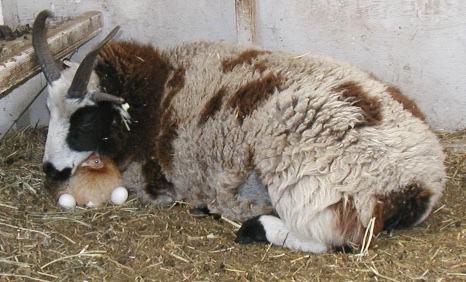

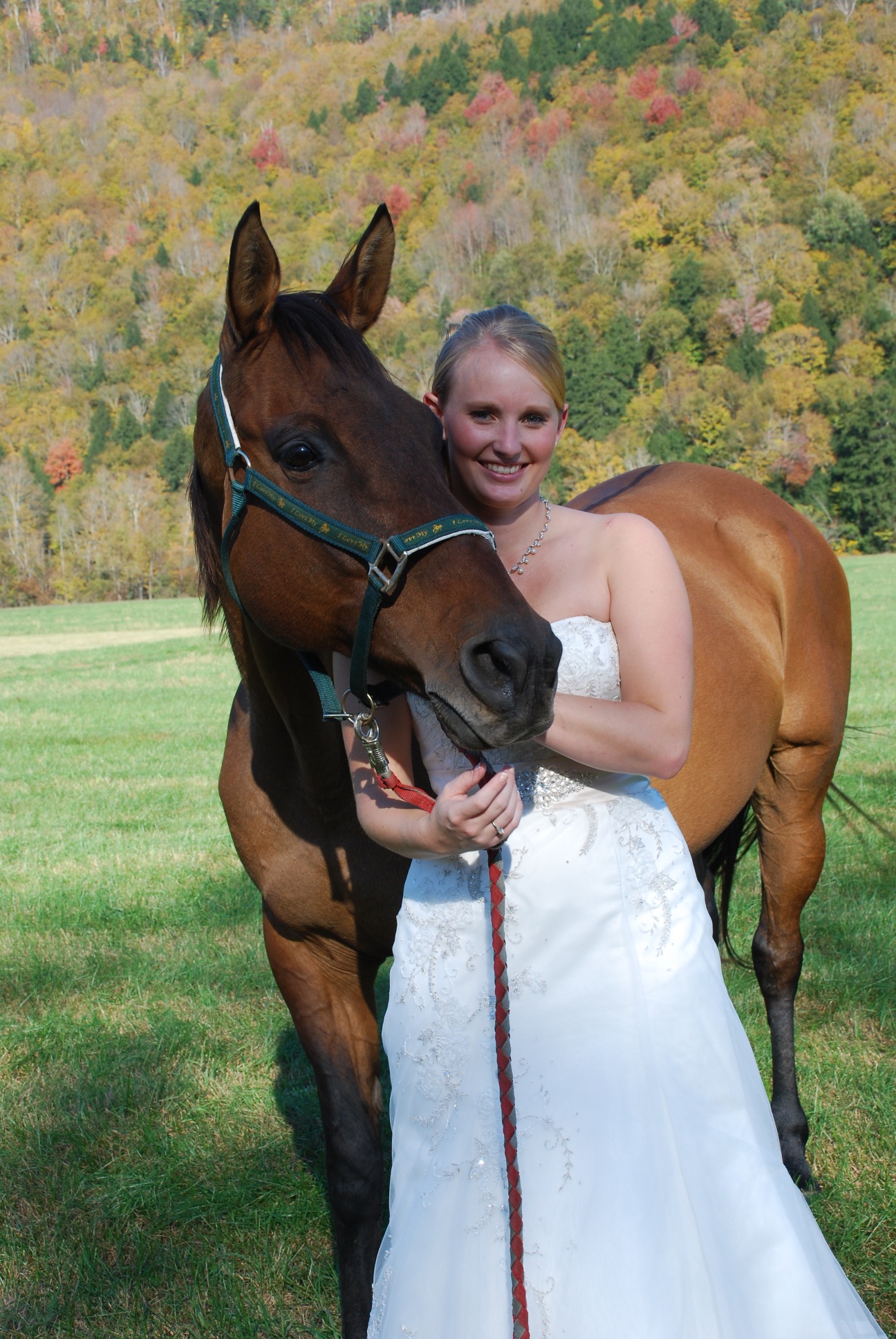 A gorgeous wedding day in Vermont.
A gorgeous wedding day in Vermont.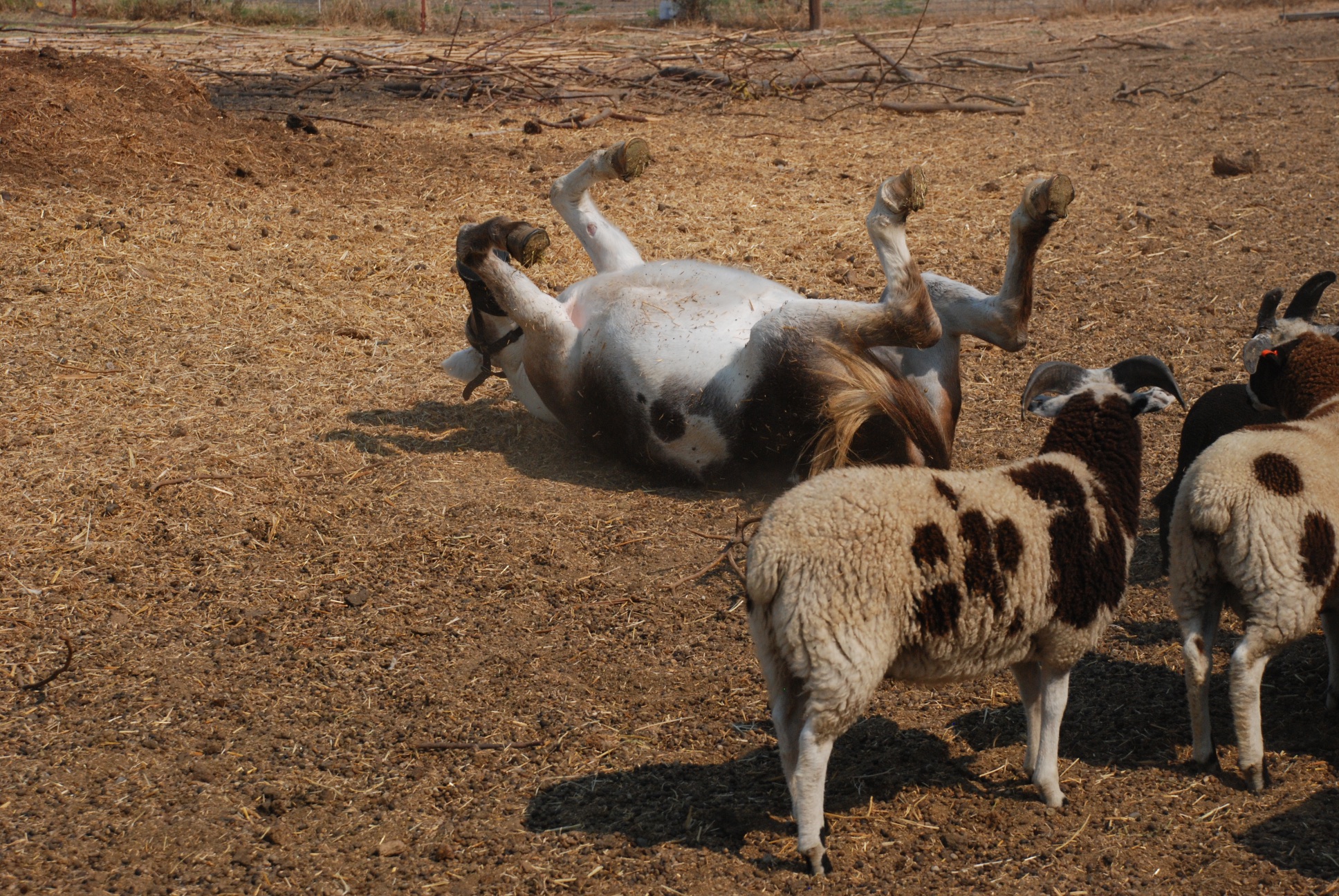 Amaryllis.
Amaryllis.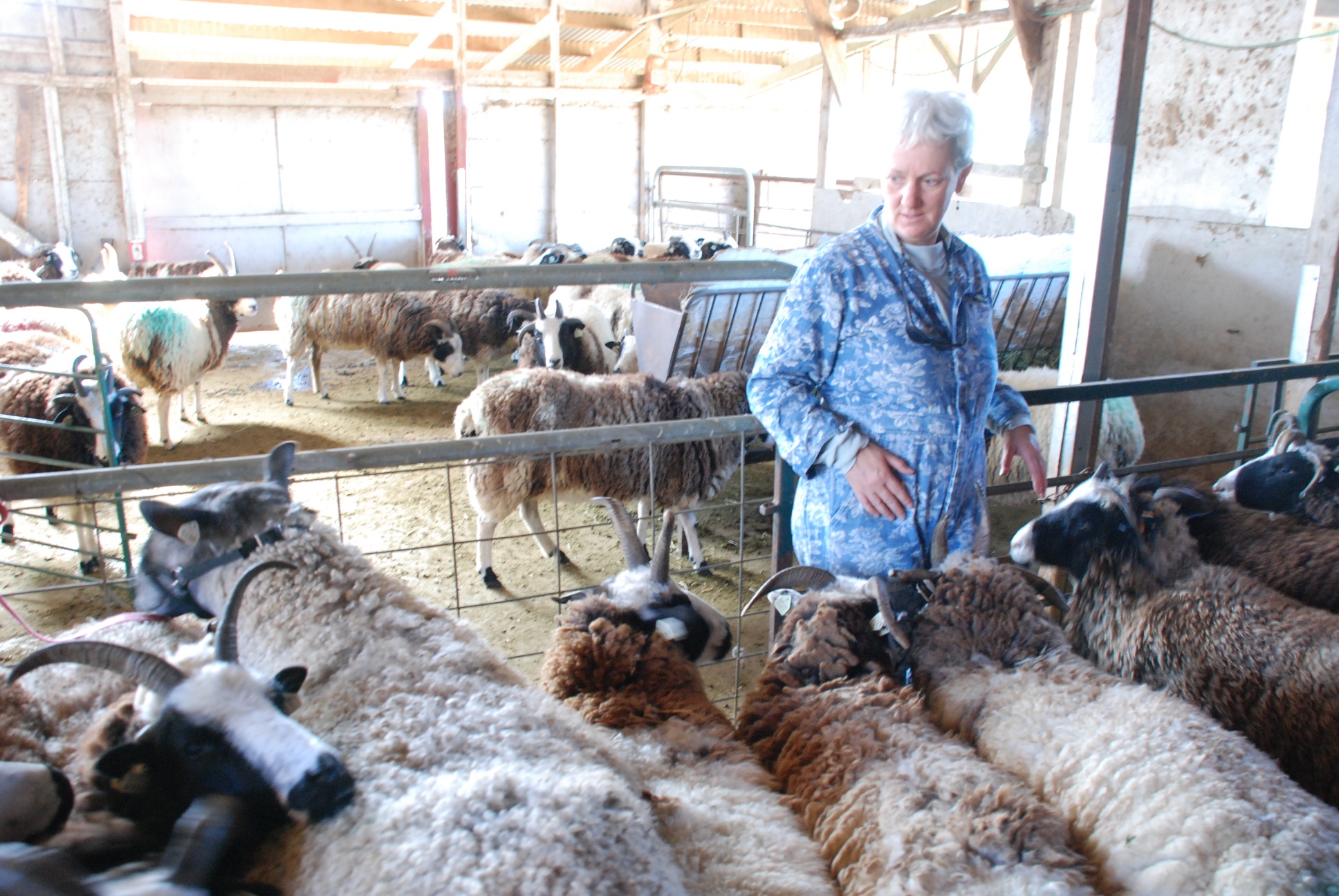 A line-up of the girls plus Faulkner, the BFL ram.
A line-up of the girls plus Faulkner, the BFL ram. Rusty moving sheep.
Rusty moving sheep.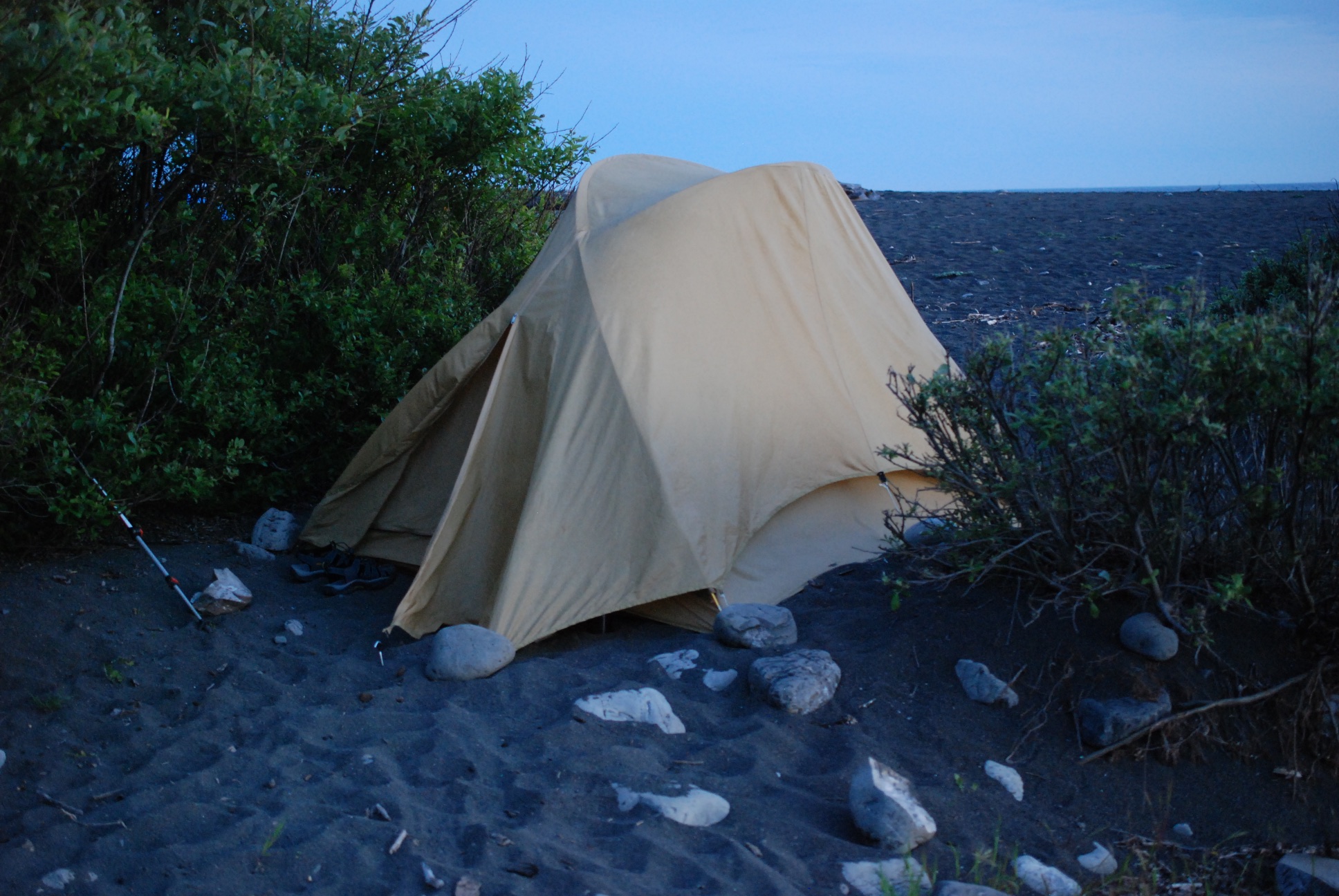 My tent when backpacking on the Lost Coast a few years ago.
My tent when backpacking on the Lost Coast a few years ago.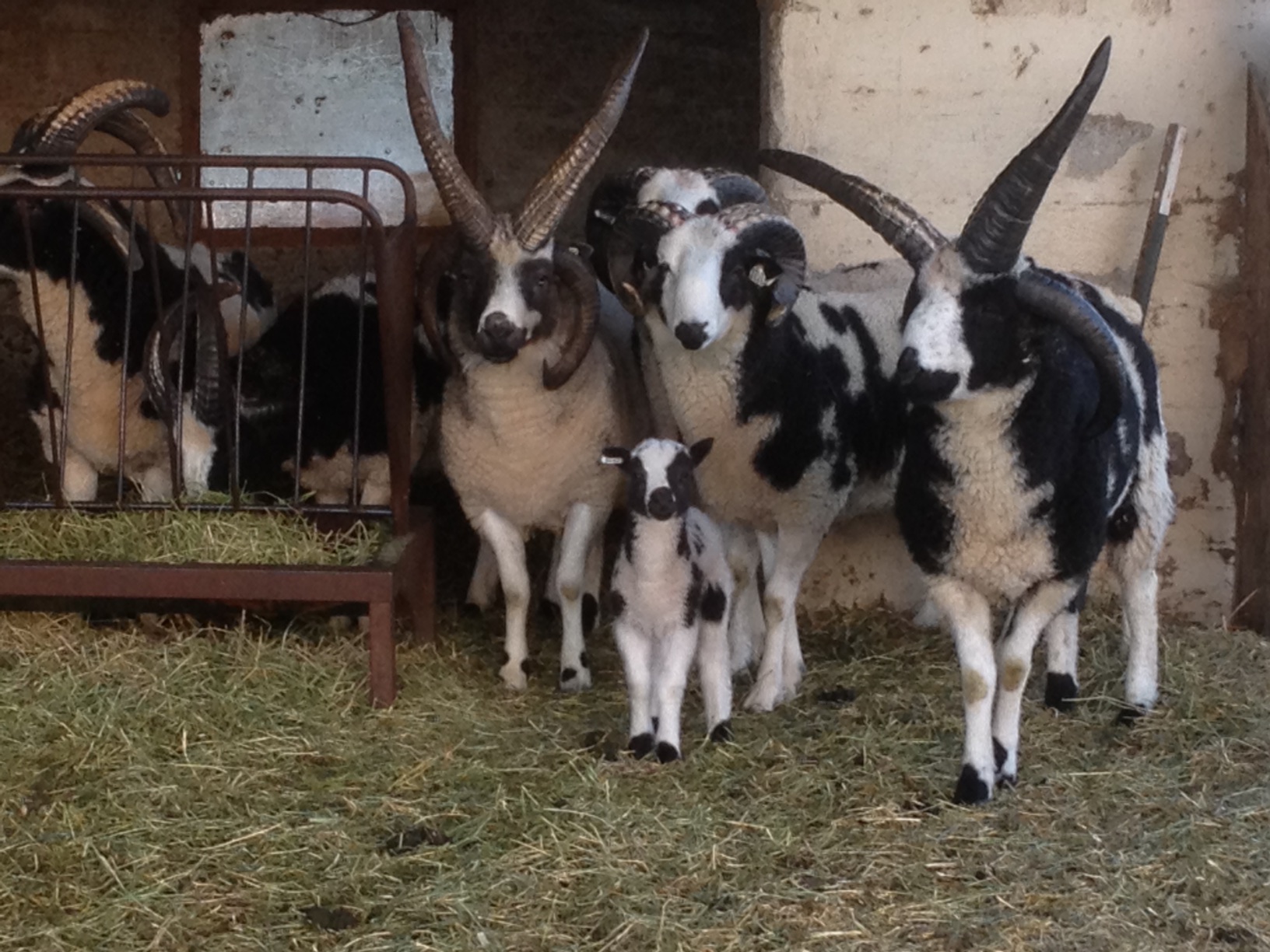 Taken 4 years ago. Look who got in with the big boys!
Taken 4 years ago. Look who got in with the big boys!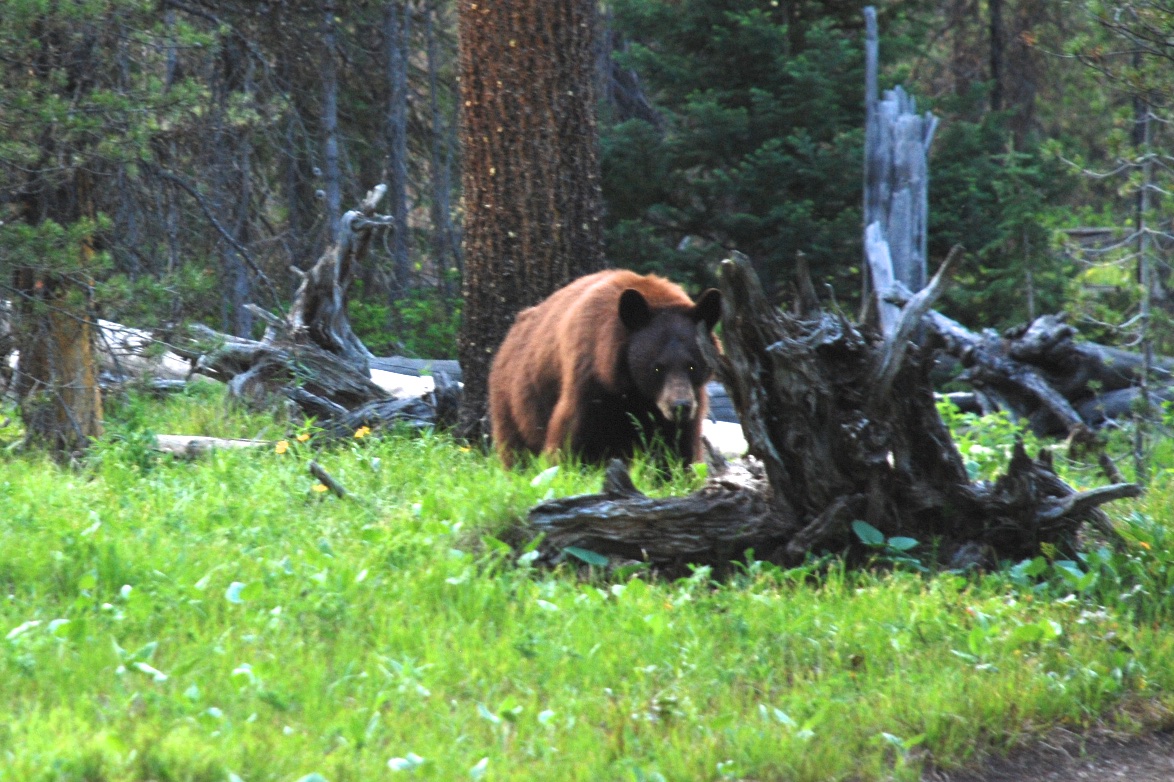 Speaking of big boys, this is a bear that Dan and came across when hiking in Grand Tetons National Park. She has a cub nearby and didn't back down. Black bear or grizzly? We were never sure. We assumed it was a black bear but some people who saw they photo said grizzly.
Speaking of big boys, this is a bear that Dan and came across when hiking in Grand Tetons National Park. She has a cub nearby and didn't back down. Black bear or grizzly? We were never sure. We assumed it was a black bear but some people who saw they photo said grizzly.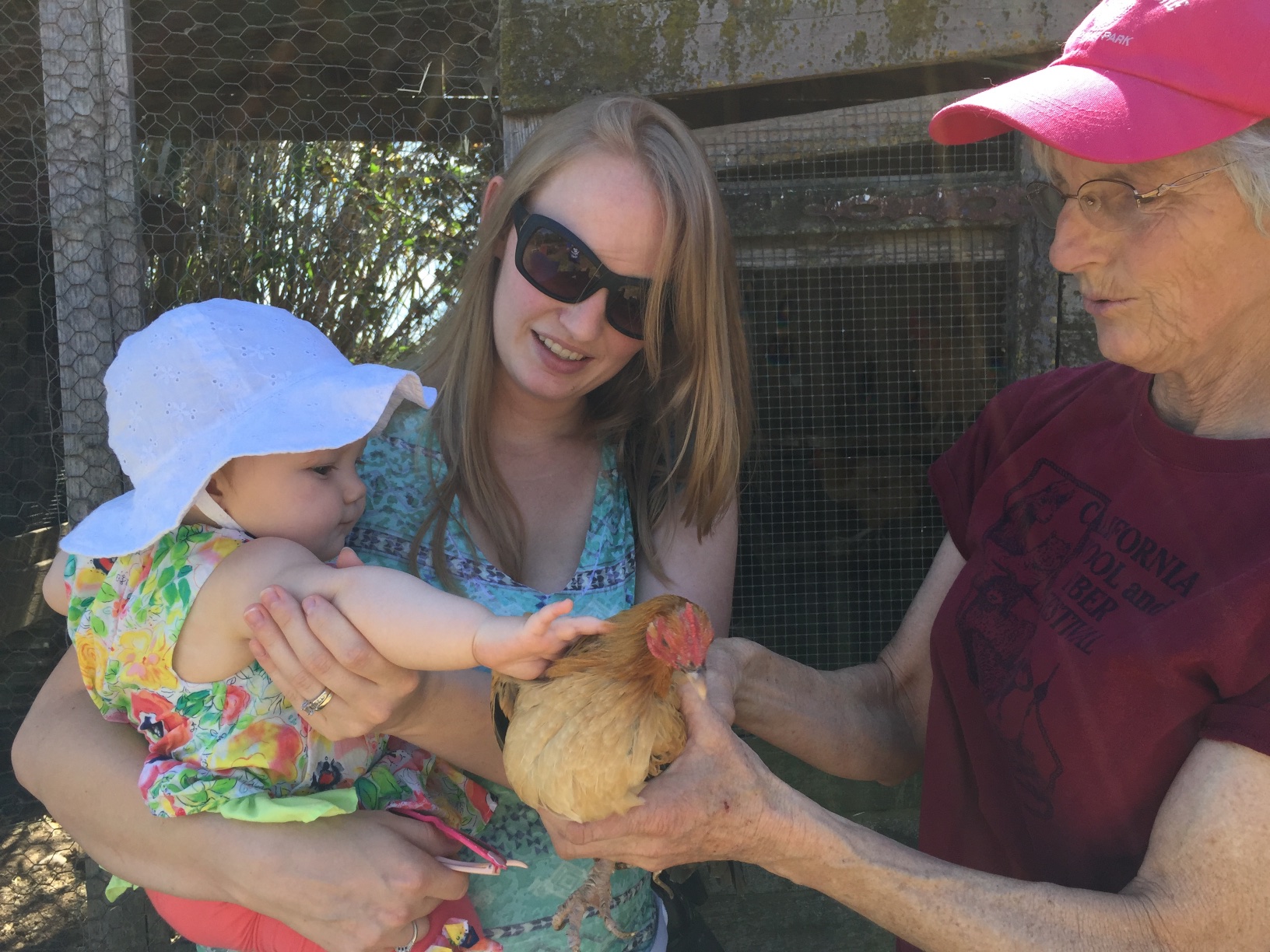 My granddaughter taken about a year ago. That's the "little chicken". Could that be the same one as in that photo with the sheep?
My granddaughter taken about a year ago. That's the "little chicken". Could that be the same one as in that photo with the sheep? I took this photo in December when we were with all my kids and their spouses in Hawaii.
I took this photo in December when we were with all my kids and their spouses in Hawaii.
That's #563. I could spend all evening here if I keep looking for other numbers.
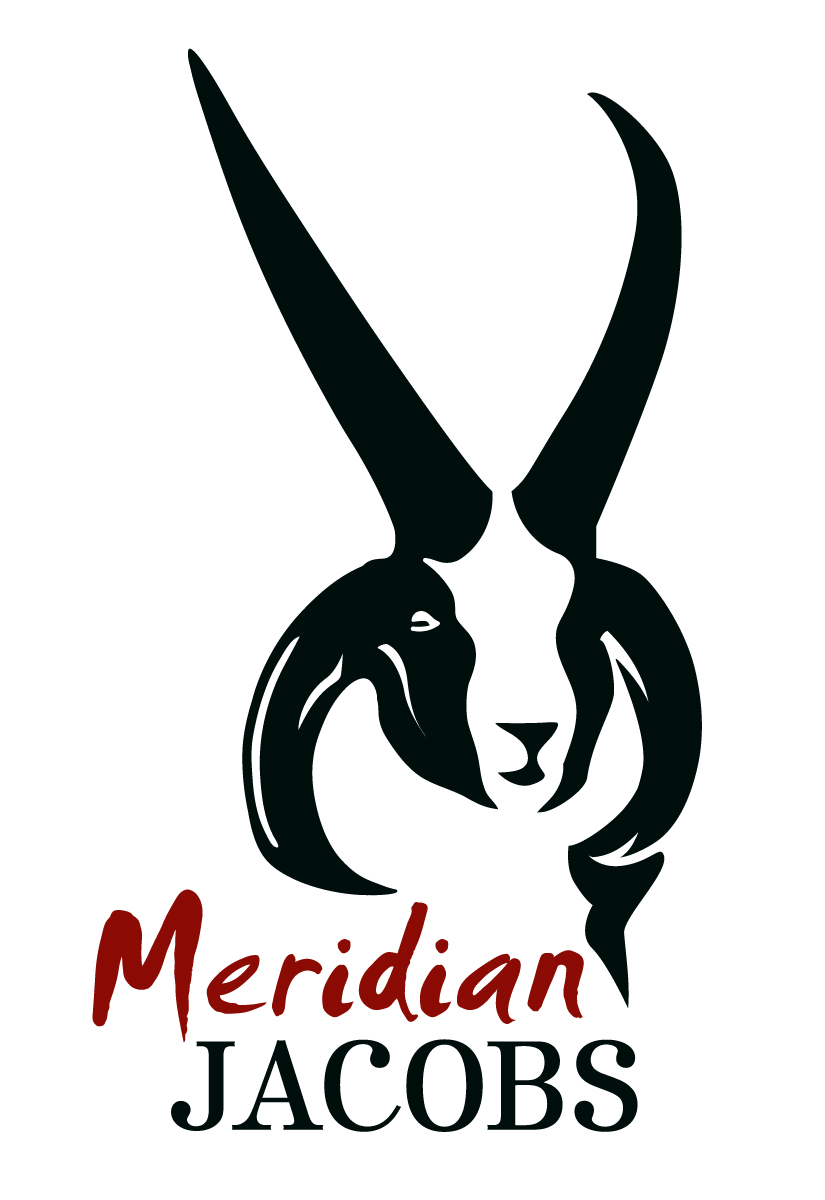
 ...and was inspired to change to my 40 mm micro lens. Then I walked around looking at things through that lens. Some are tiny and some not so tiny, depending on the view.
...and was inspired to change to my 40 mm micro lens. Then I walked around looking at things through that lens. Some are tiny and some not so tiny, depending on the view.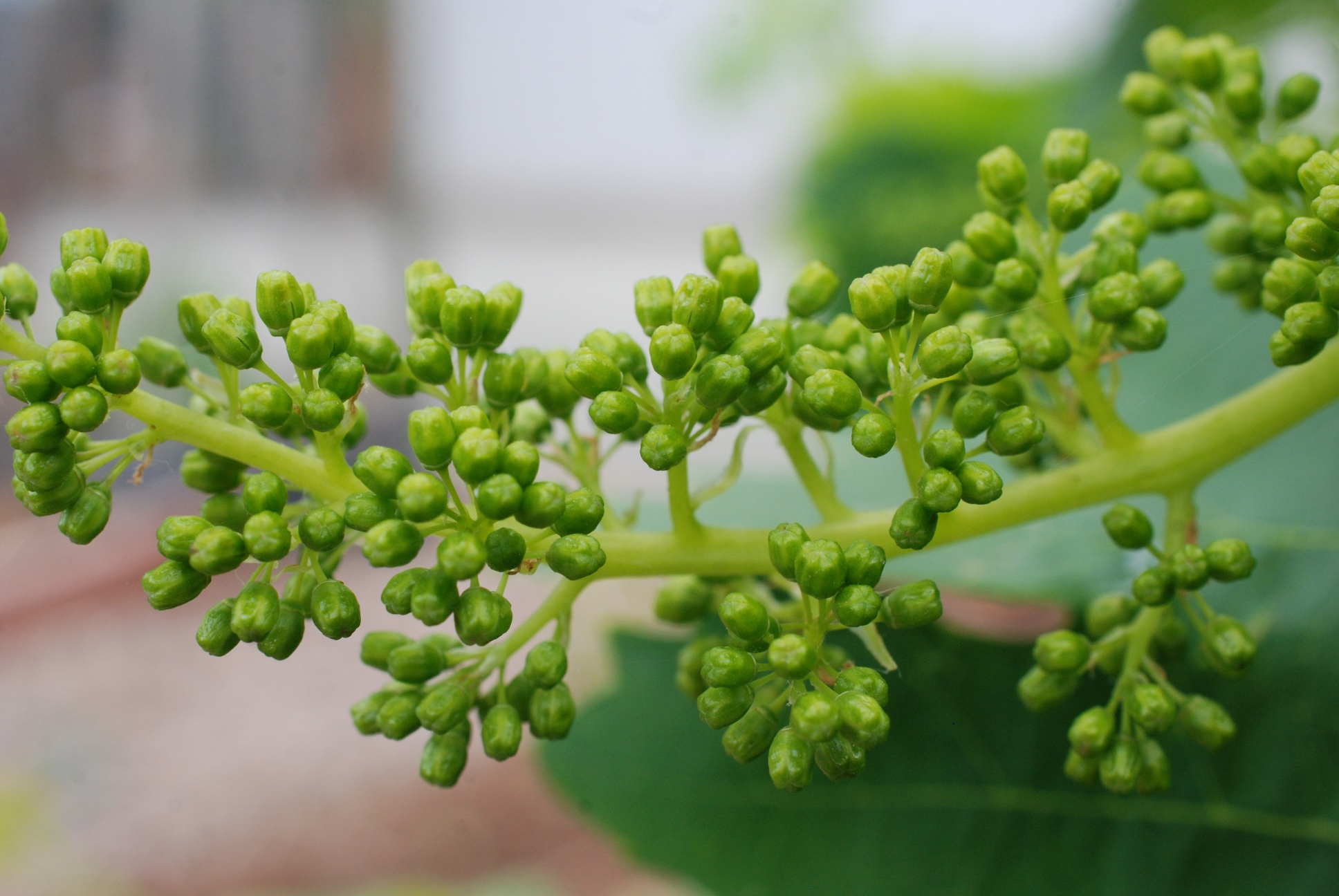 Grapes just forming.
Grapes just forming.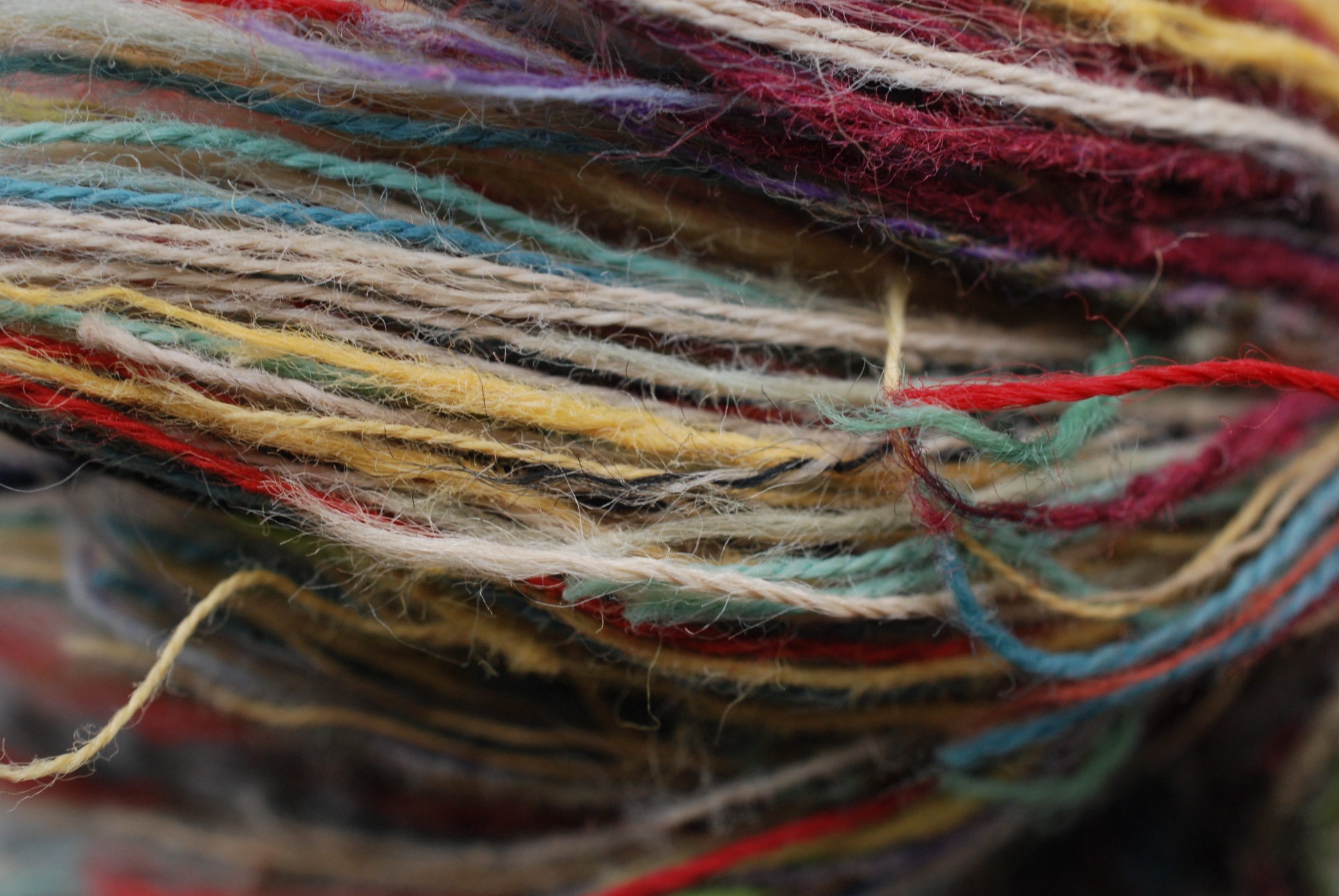 The rope part of Ginny's Toy.
The rope part of Ginny's Toy.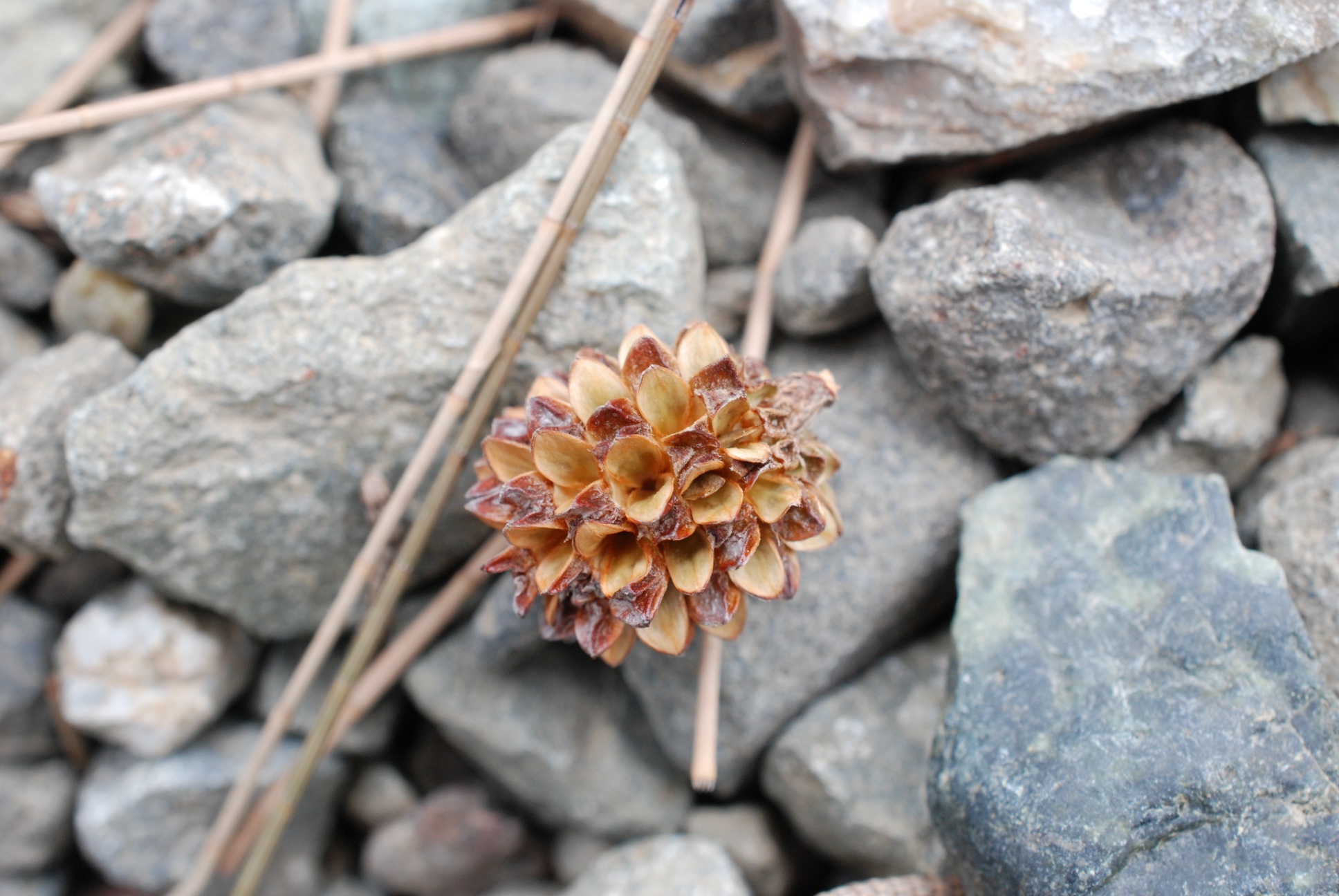 Dried up "cone" from sheoak tree.
Dried up "cone" from sheoak tree.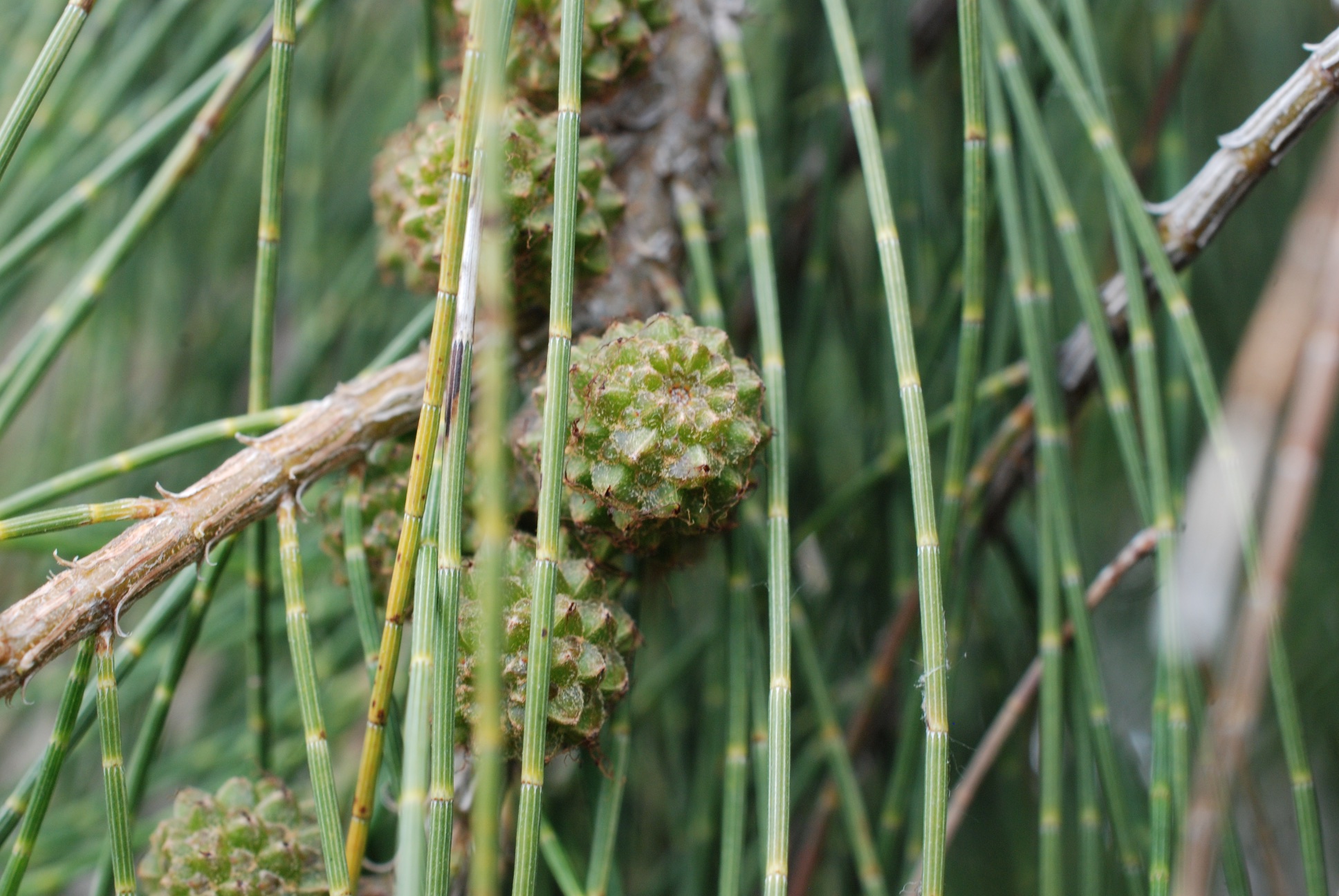 That "cone" on the tree.
That "cone" on the tree. Can you guess this one? Answer below the next photo.
Can you guess this one? Answer below the next photo.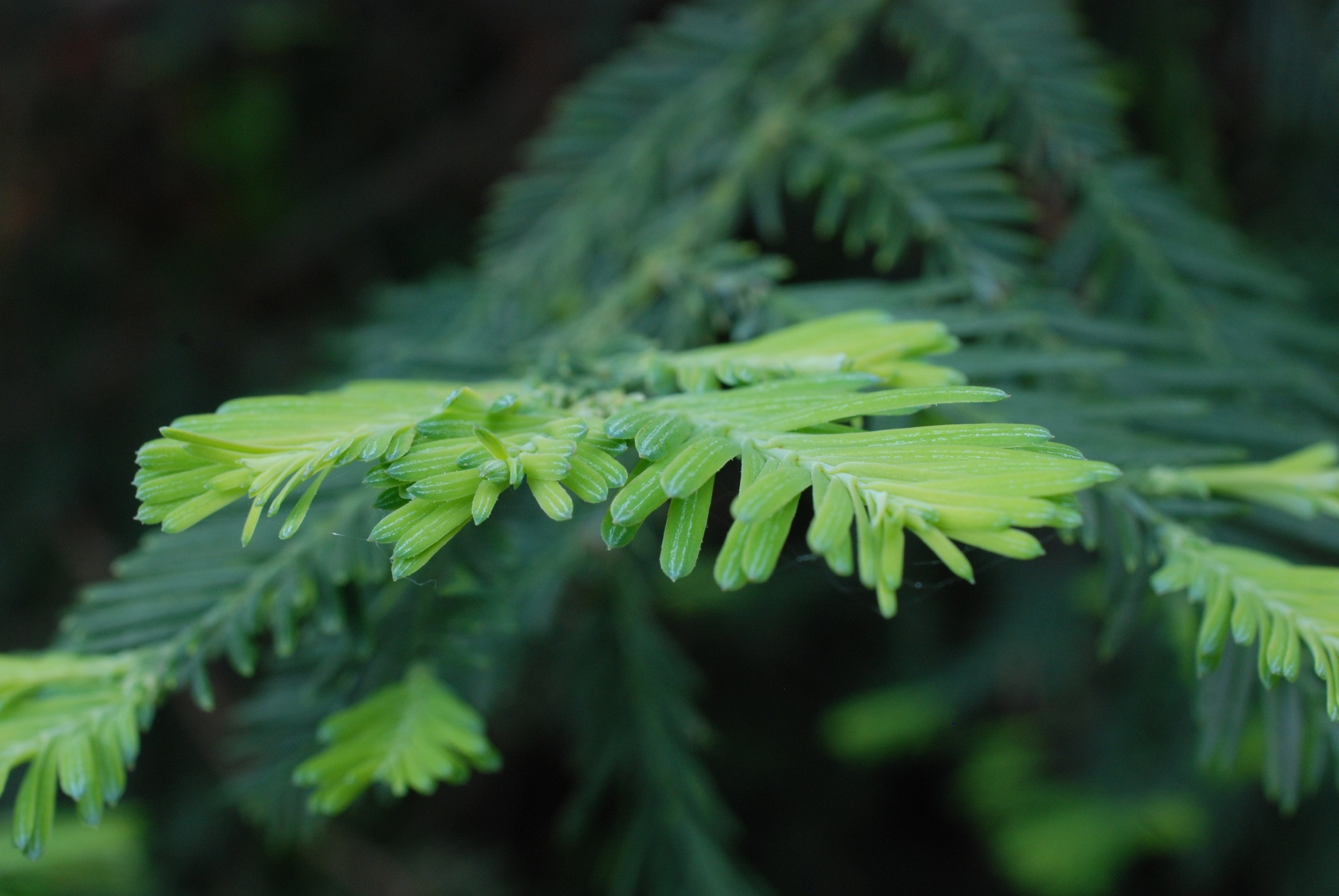 This is the new growth on the redwood tree. That photo above is the joint in a ram skull.
This is the new growth on the redwood tree. That photo above is the joint in a ram skull.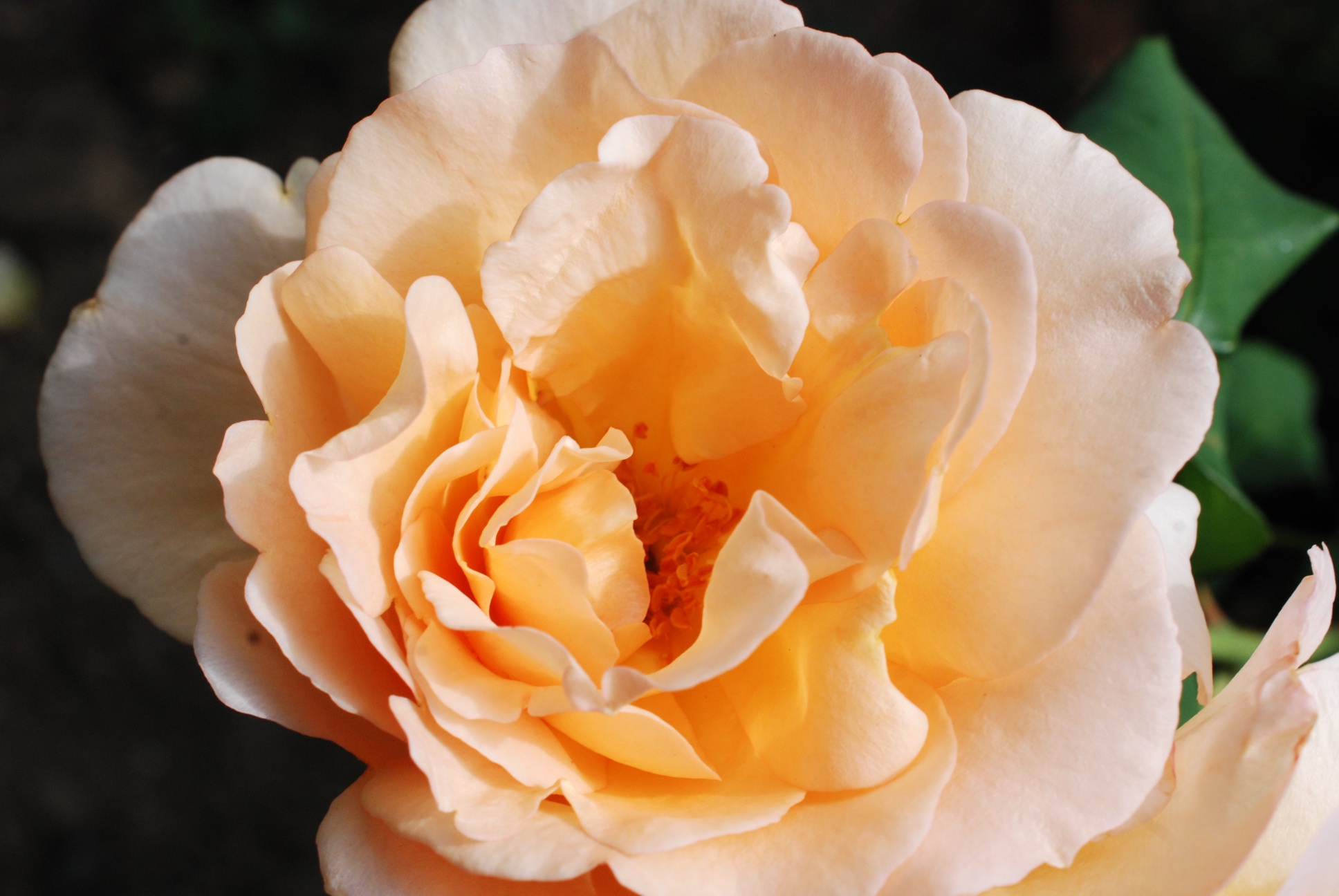 Rose.
Rose.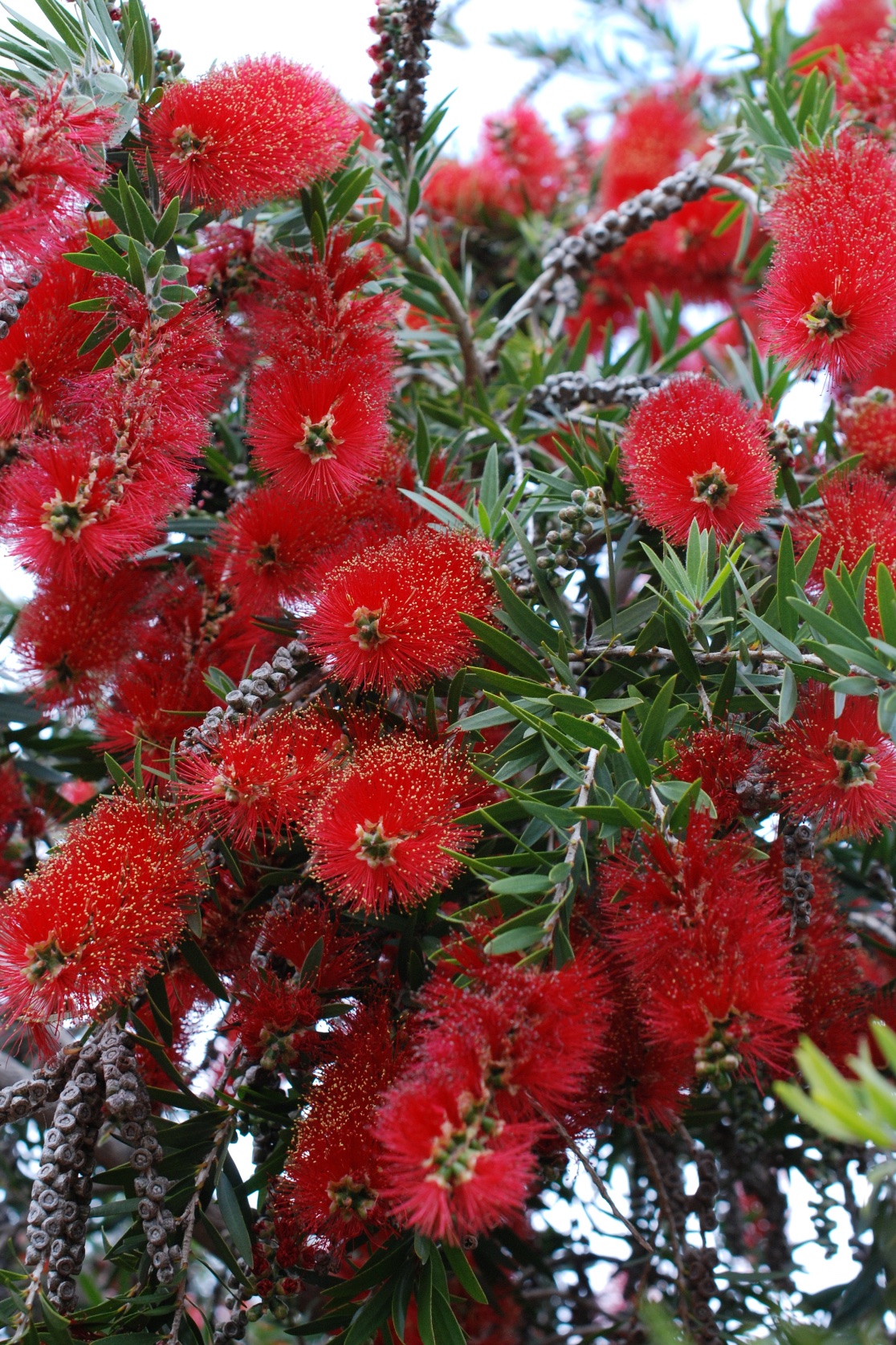 This bottlebrush is covered with flowers this year.
This bottlebrush is covered with flowers this year.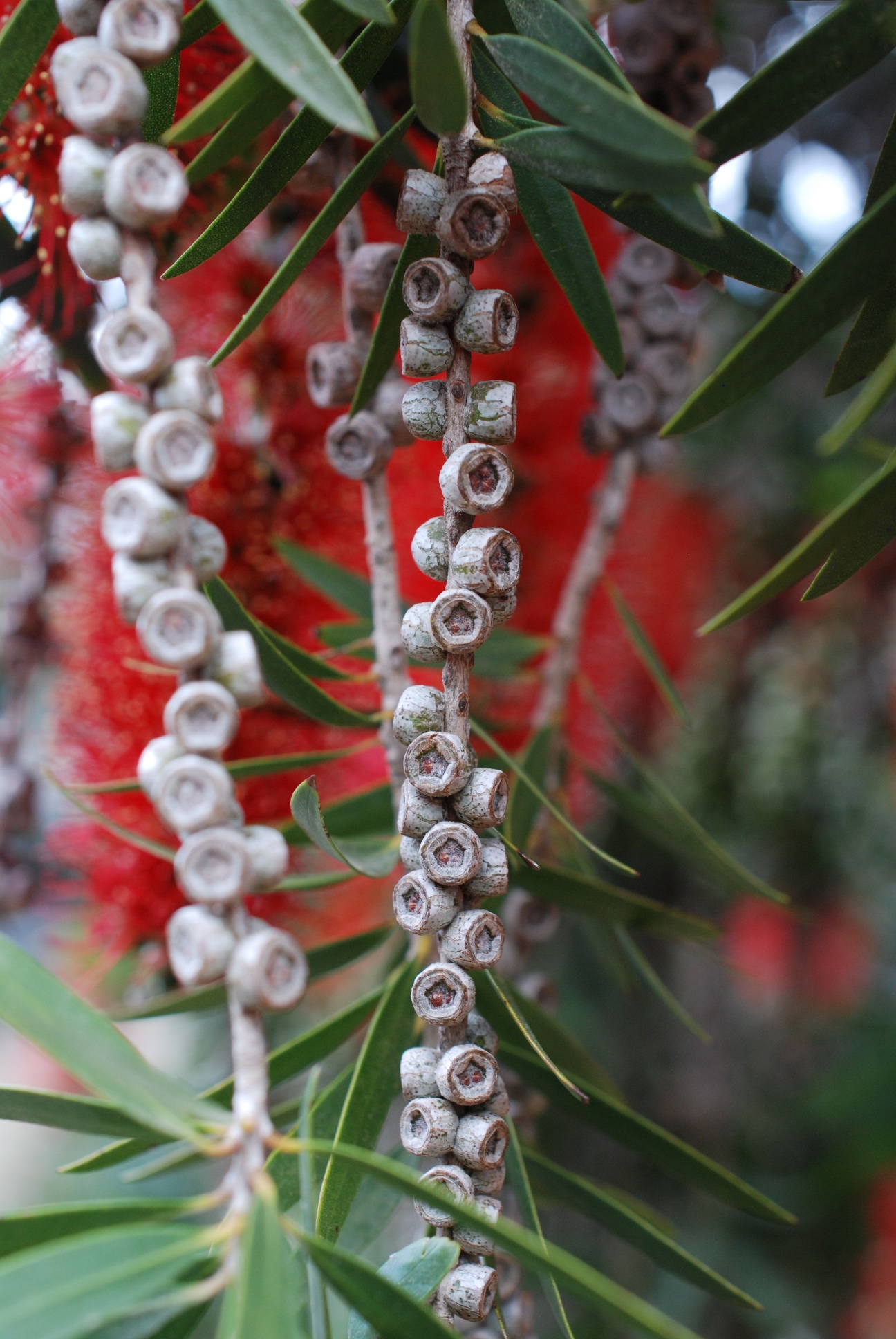 This is what is left from last year's flowers.
This is what is left from last year's flowers.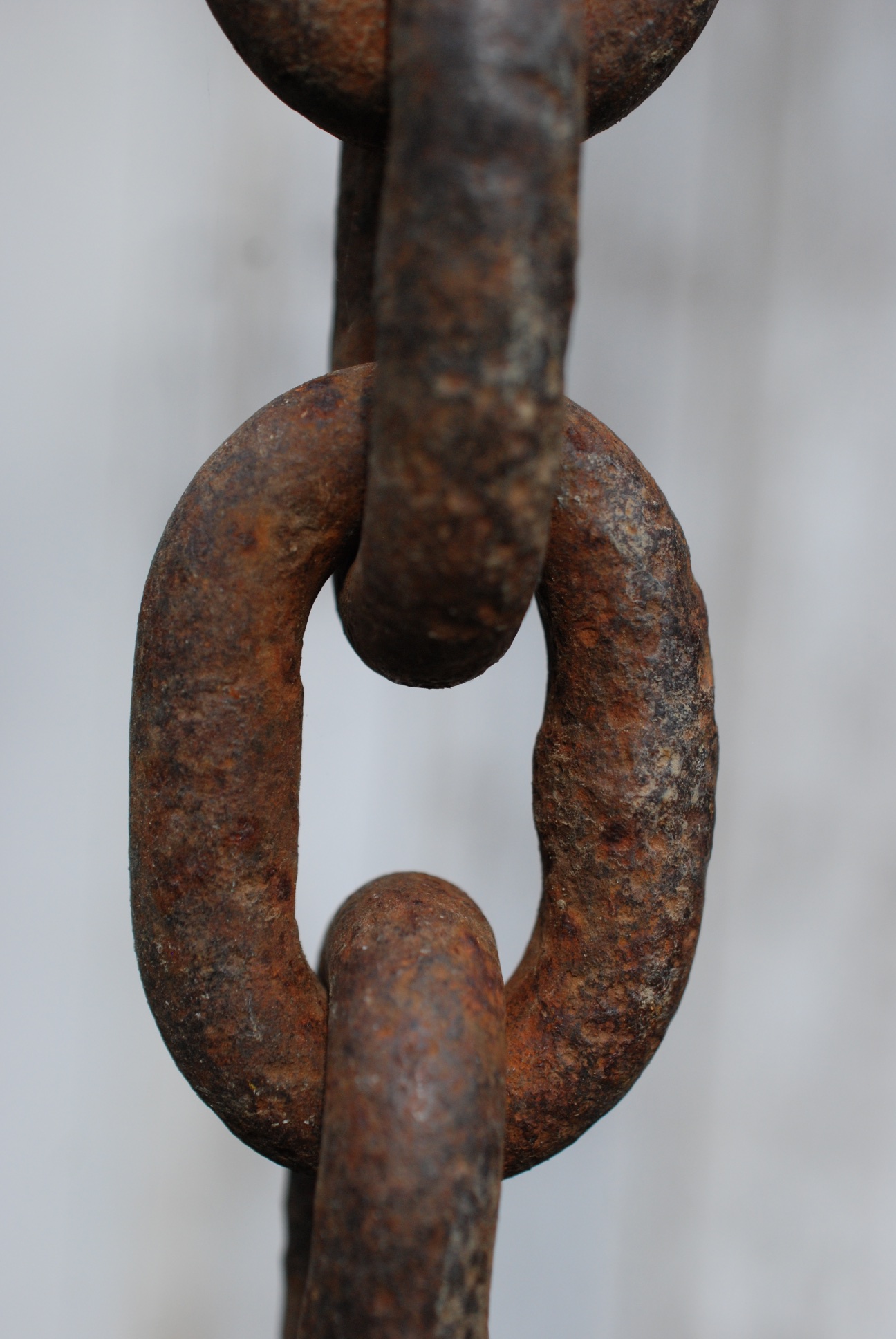 Chain.
Chain. I took the camera Across the Road too. This is a blackberry flower.
I took the camera Across the Road too. This is a blackberry flower. Hoverfly on a blackberry leaf.
Hoverfly on a blackberry leaf.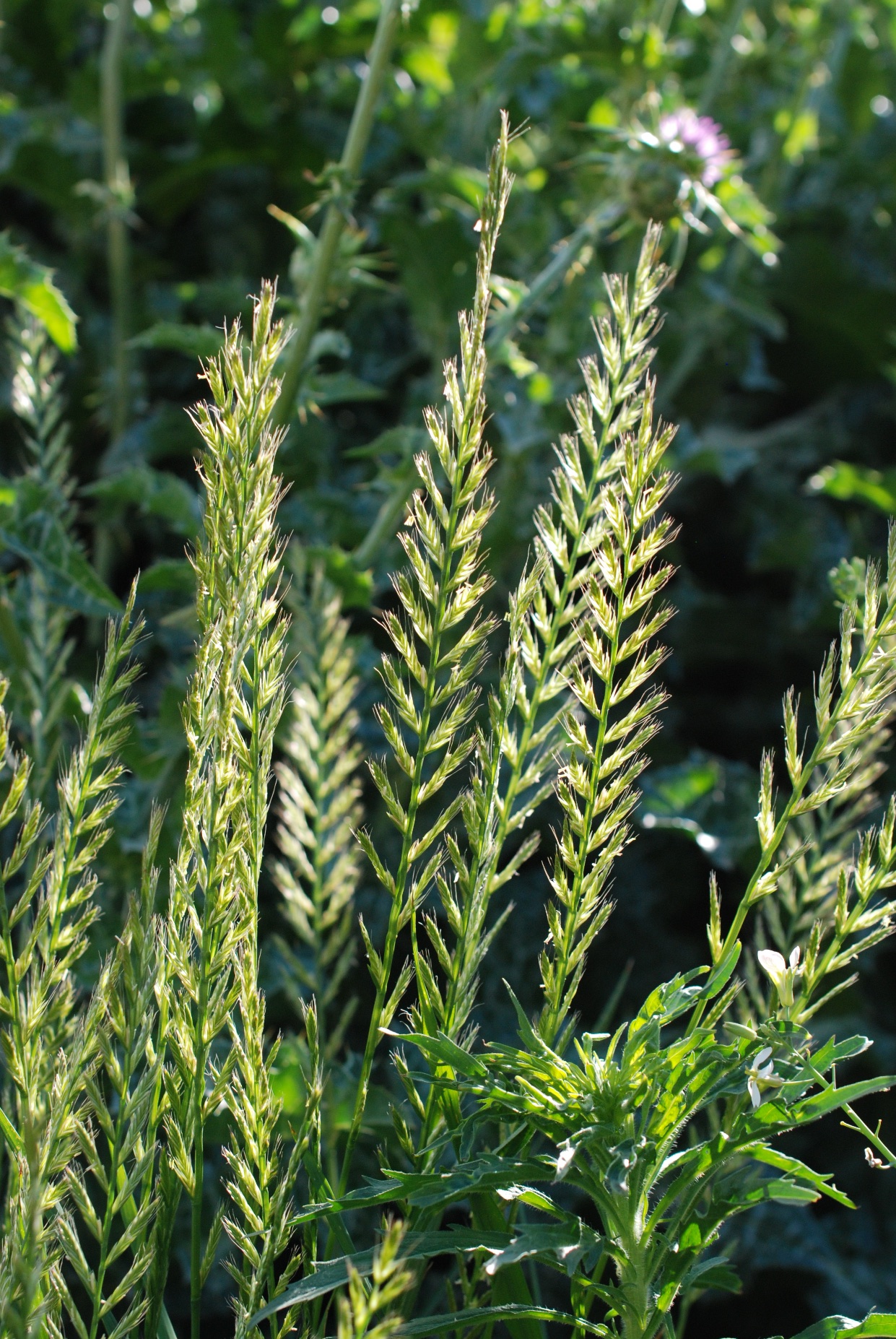 Grass flowering.
Grass flowering. Buckeye flowers.
This lens isn't just good for close-ups. I got some fun photos of Ginny jumping for her Toy in the canal. Those will be in
Buckeye flowers.
This lens isn't just good for close-ups. I got some fun photos of Ginny jumping for her Toy in the canal. Those will be in 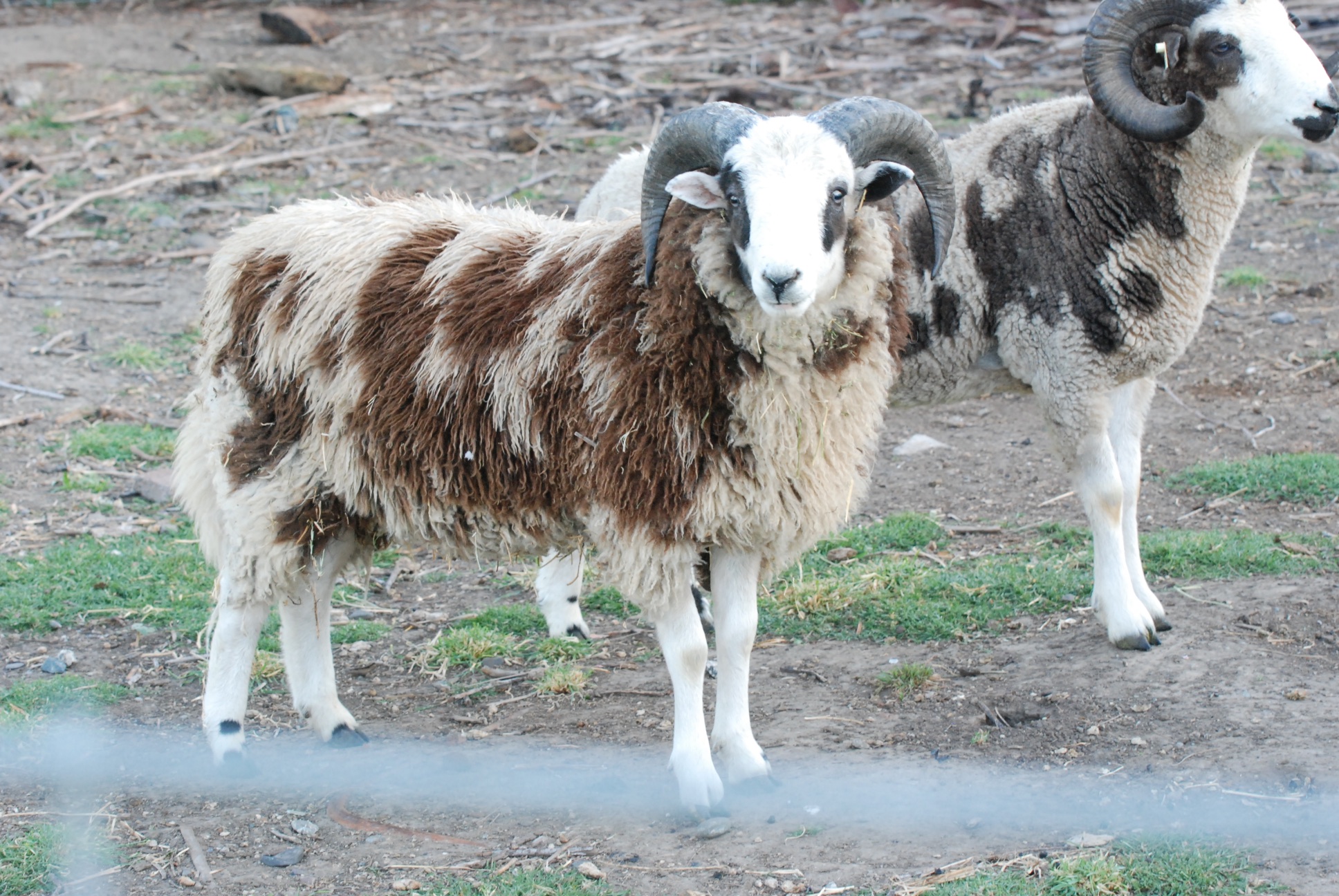 This is the 9 month old ram. He needs a name.
This is the 9 month old ram. He needs a name.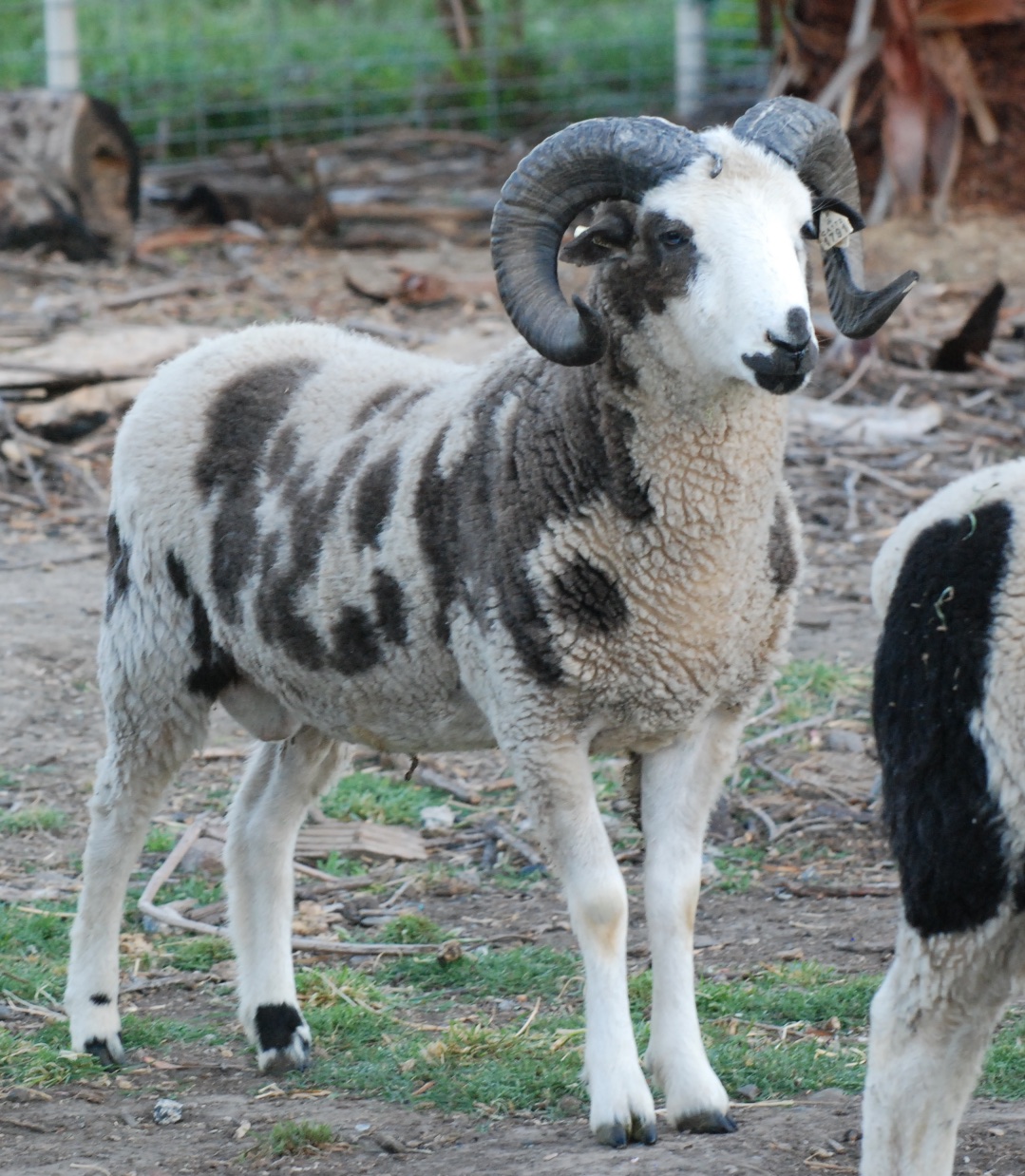 This is Meridian Nash. These rams have the same sire so I don't need both. I think this one will be for sale.
This is Meridian Nash. These rams have the same sire so I don't need both. I think this one will be for sale.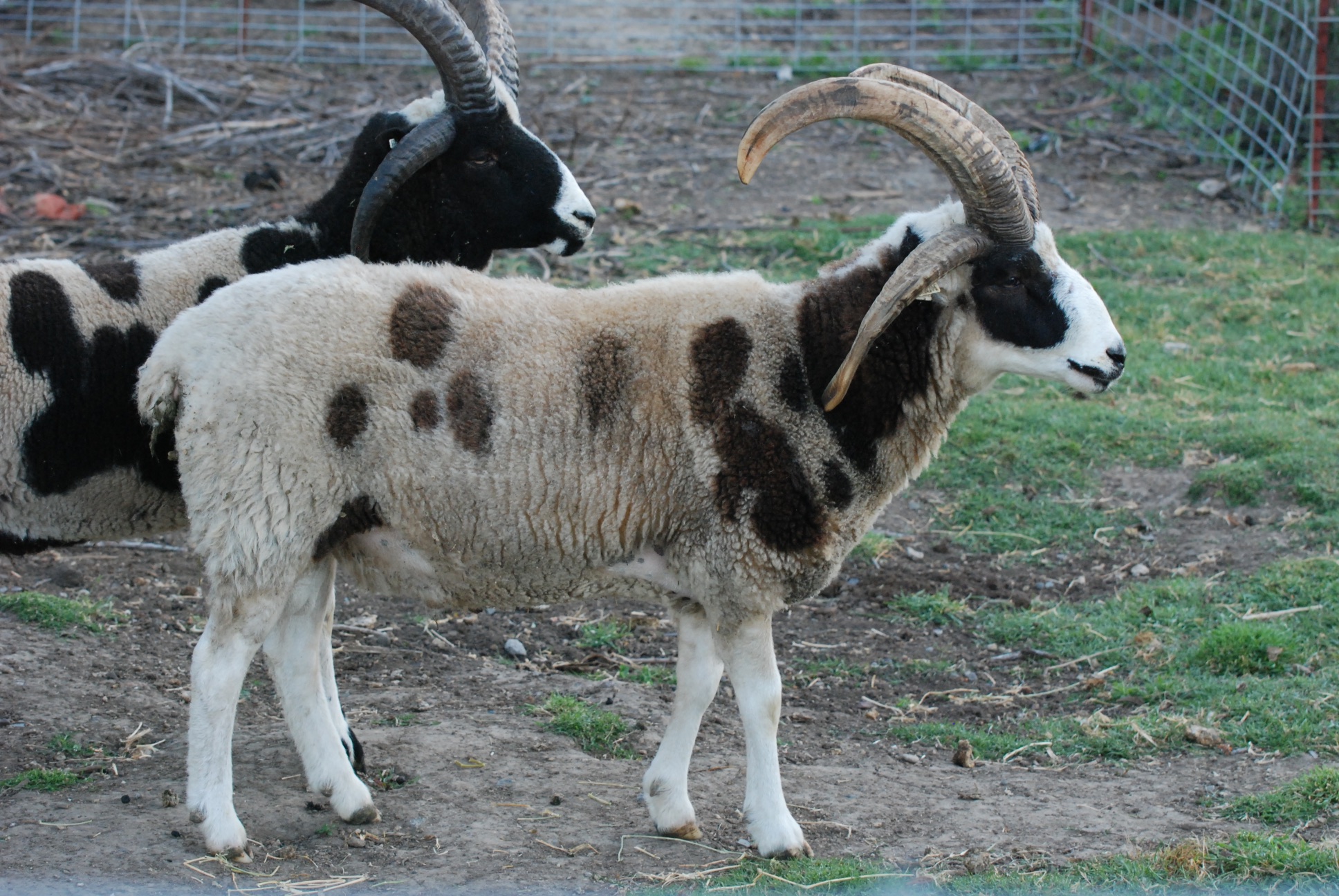 Puddleduck Ringo is also for sale. I have used him for two seasons and he needs to move on.
Puddleduck Ringo is also for sale. I have used him for two seasons and he needs to move on. Meridian Rotor.
Meridian Rotor. 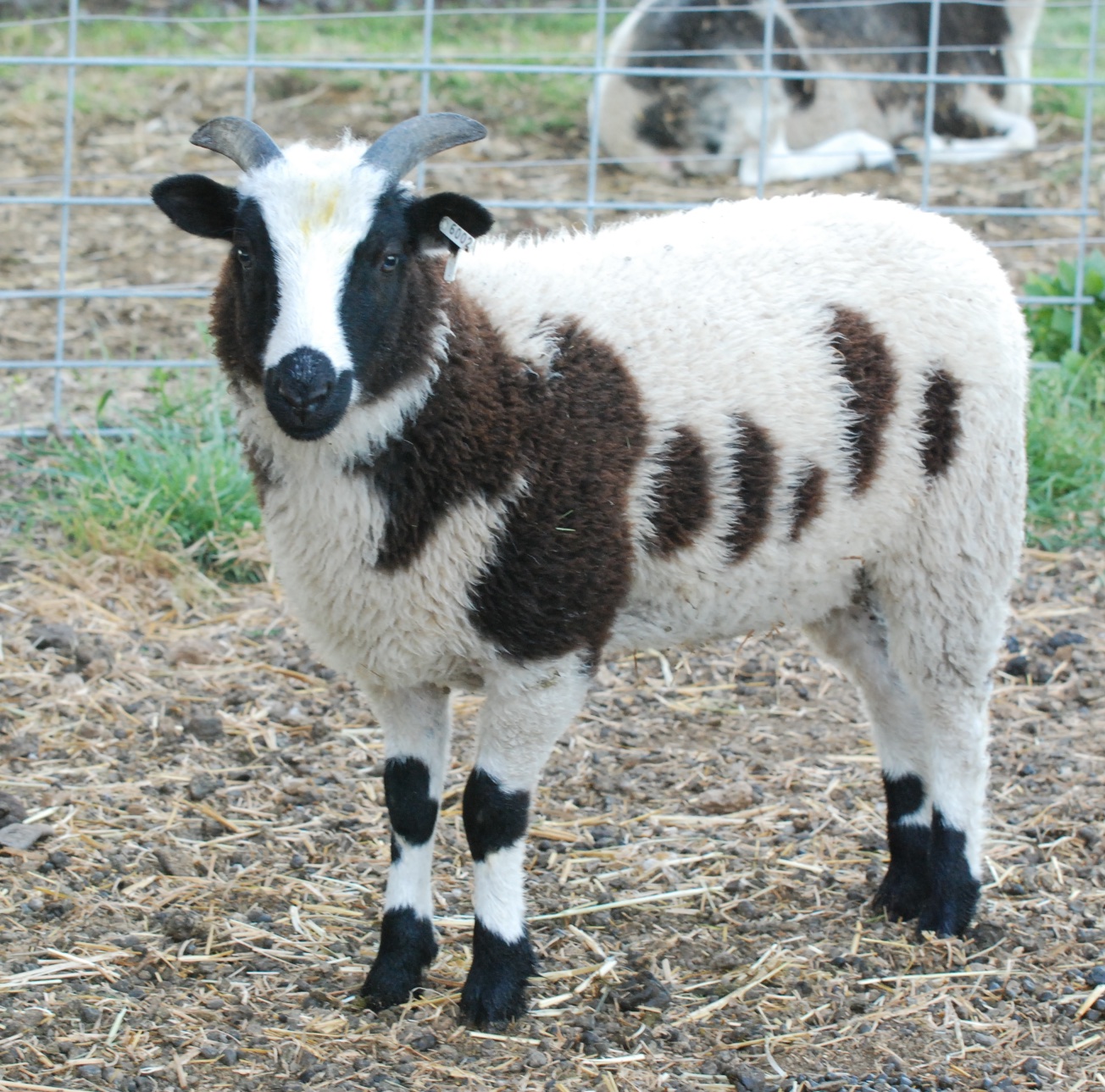 Isn't this a beautiful stylish ewe lamb? She was born a month before everyone else because the ram lambs weren't weaned soon enough. Too bad I don't know her sire. Her very cute baby pictures with her brother are in
Isn't this a beautiful stylish ewe lamb? She was born a month before everyone else because the ram lambs weren't weaned soon enough. Too bad I don't know her sire. Her very cute baby pictures with her brother are in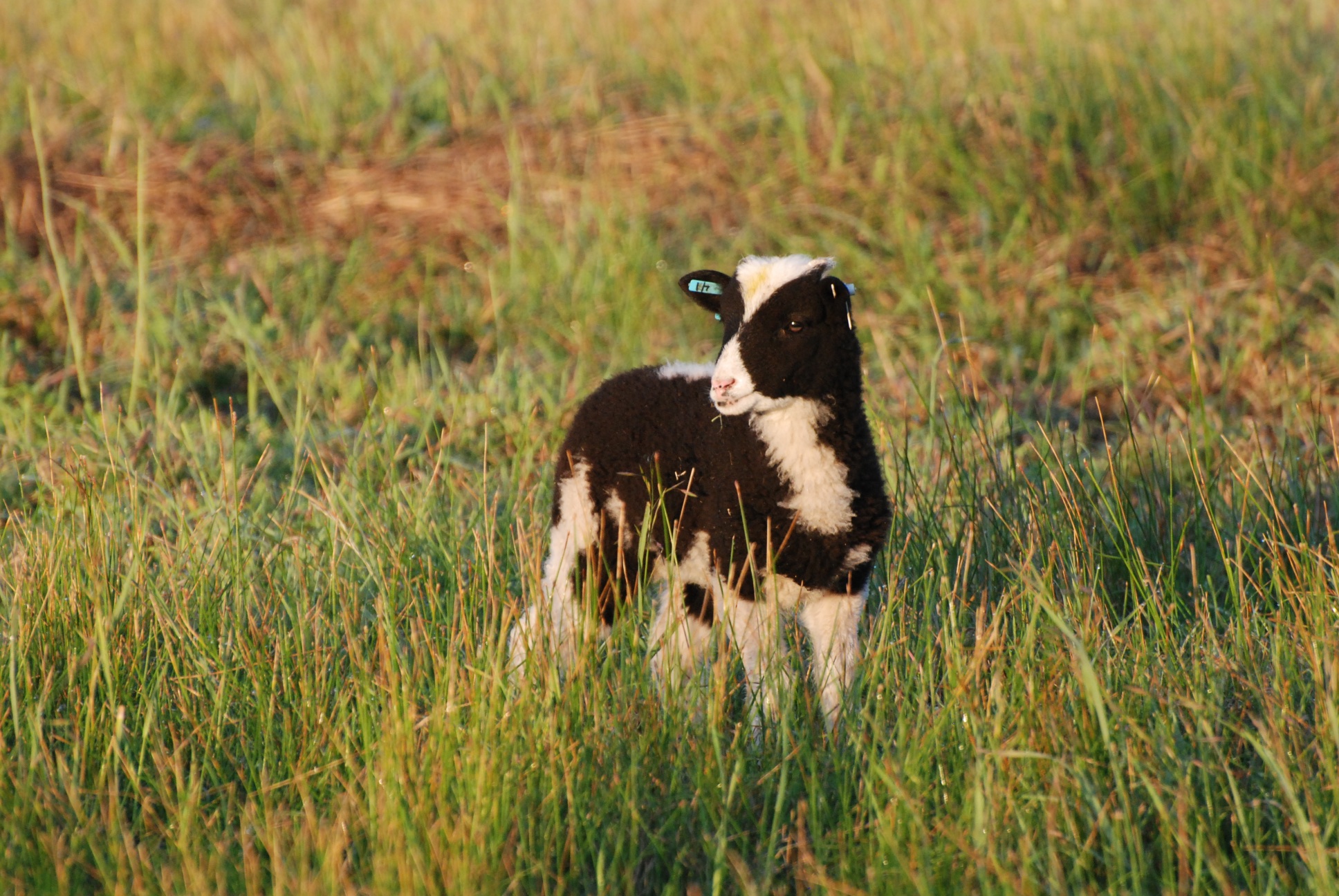 Lamb in early morning light. Meridian Vanessa x Meridian Rotor.
Lamb in early morning light. Meridian Vanessa x Meridian Rotor.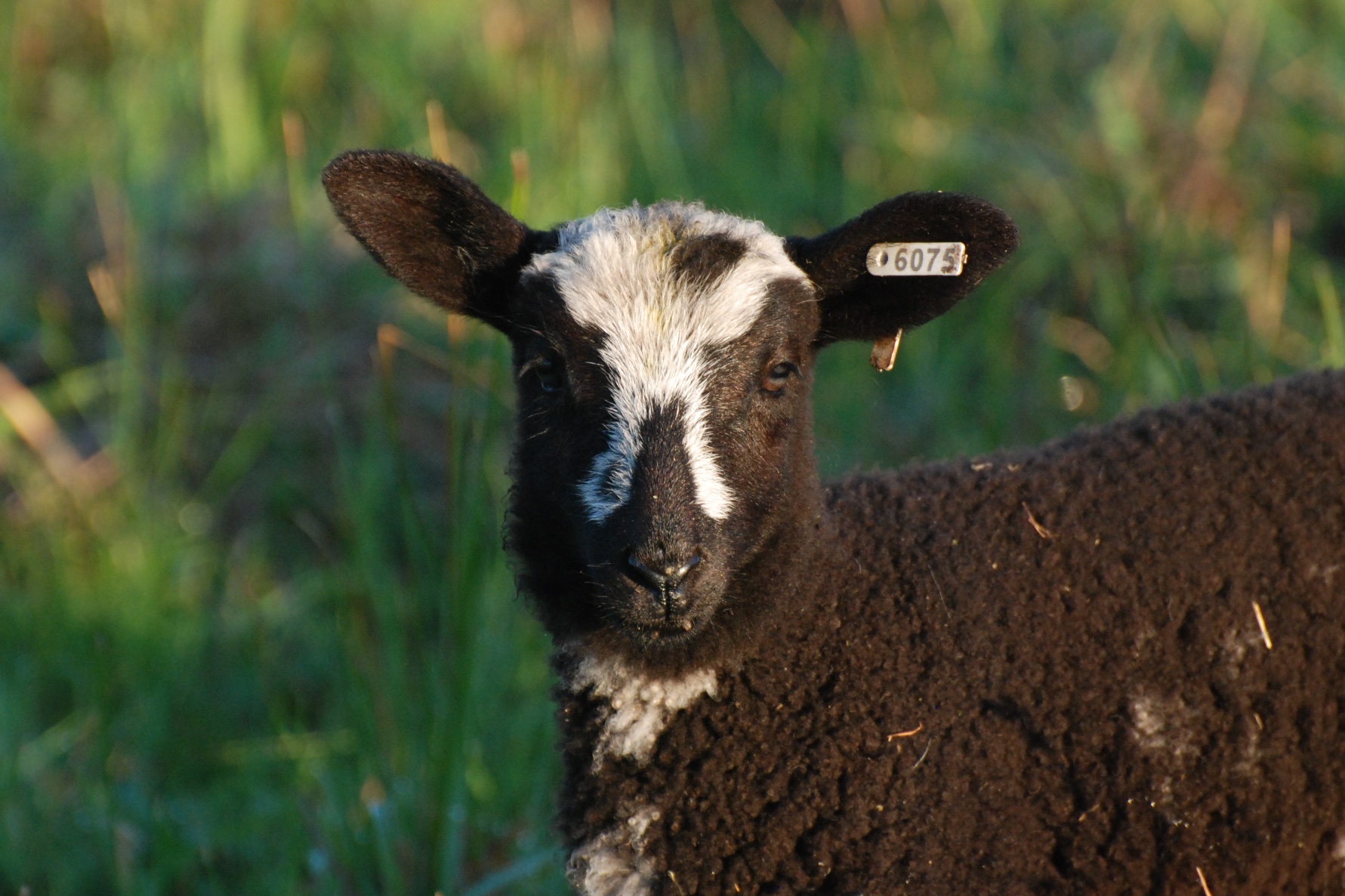 BFL-cross lamb. Love those BFL faces.
BFL-cross lamb. Love those BFL faces.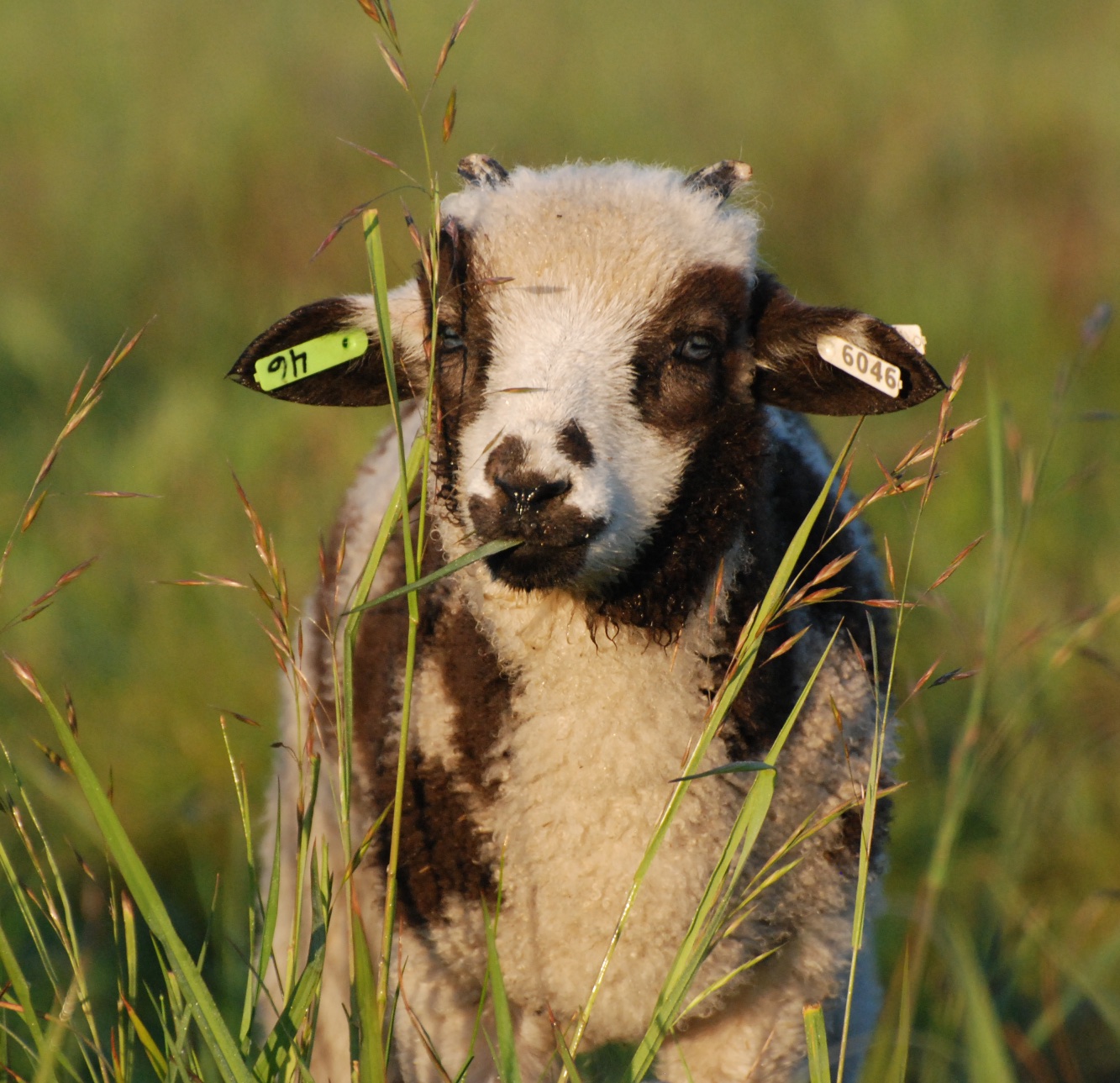 I'm keeping this lilac lamb. Mud Ranch's Foxglove x Meridian Nash.
I'm keeping this lilac lamb. Mud Ranch's Foxglove x Meridian Nash.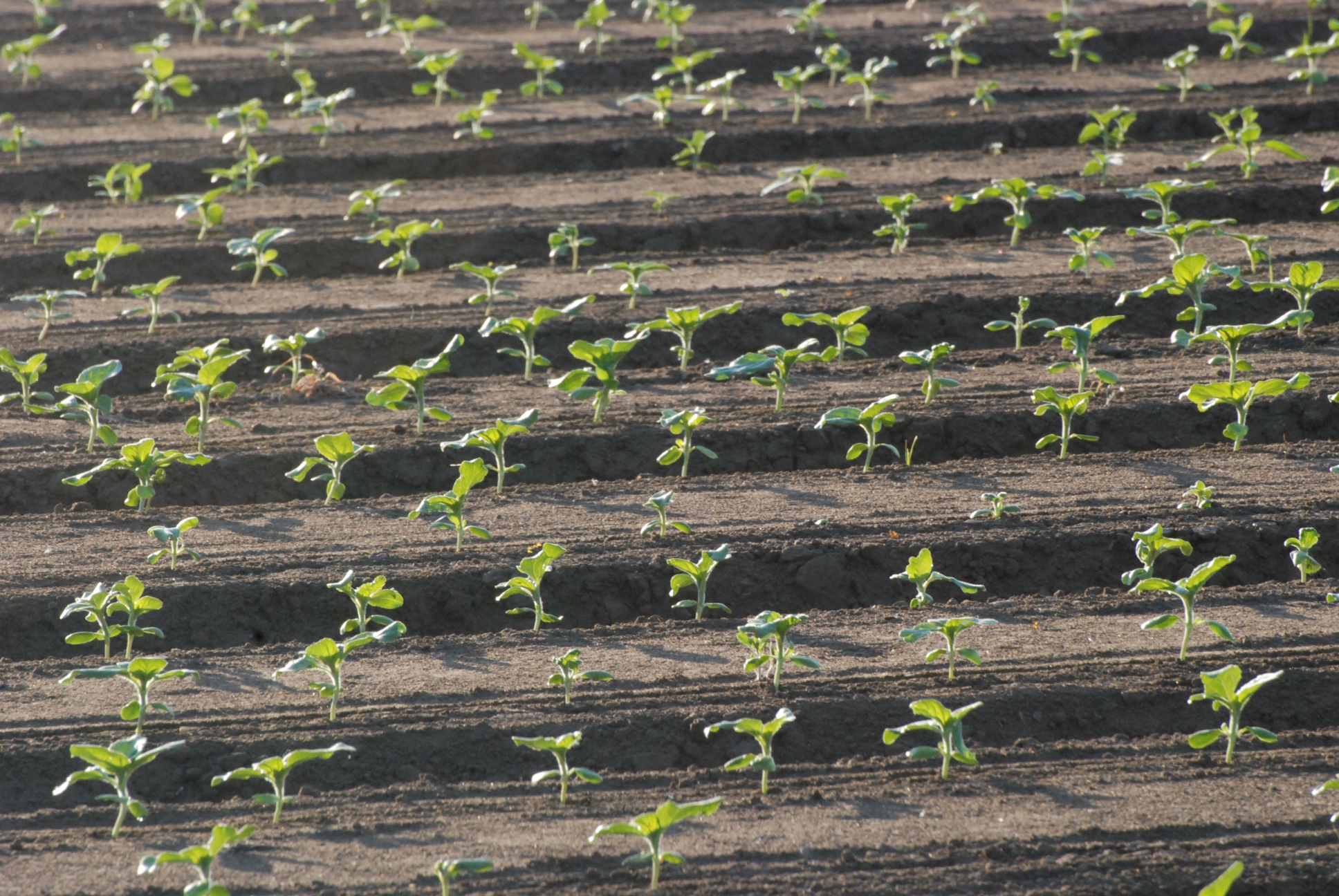 Not sheep, but the sunflowers Across the Road.
Not sheep, but the sunflowers Across the Road.
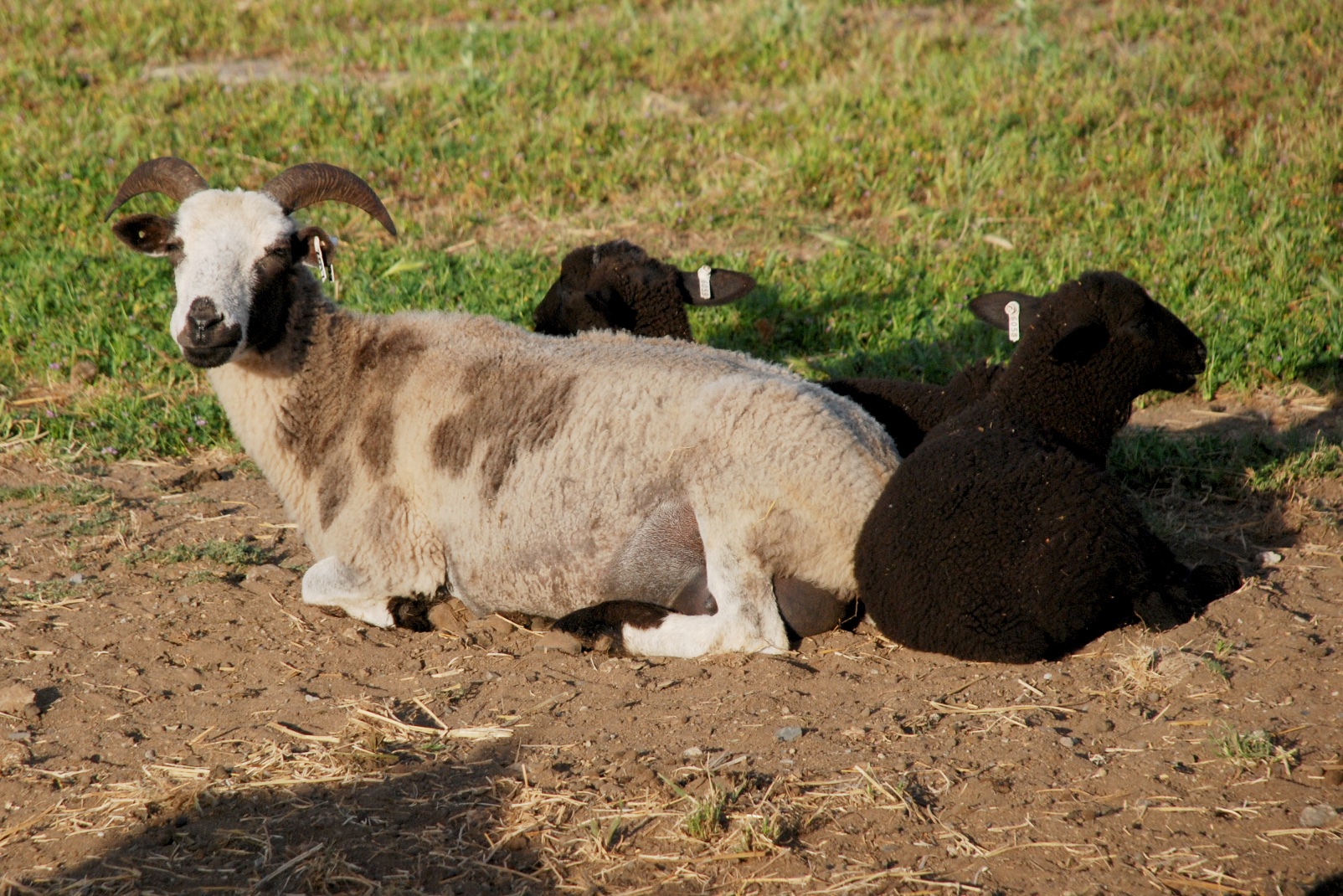 Ginseng and BFL-X lambs.
Ginseng and BFL-X lambs.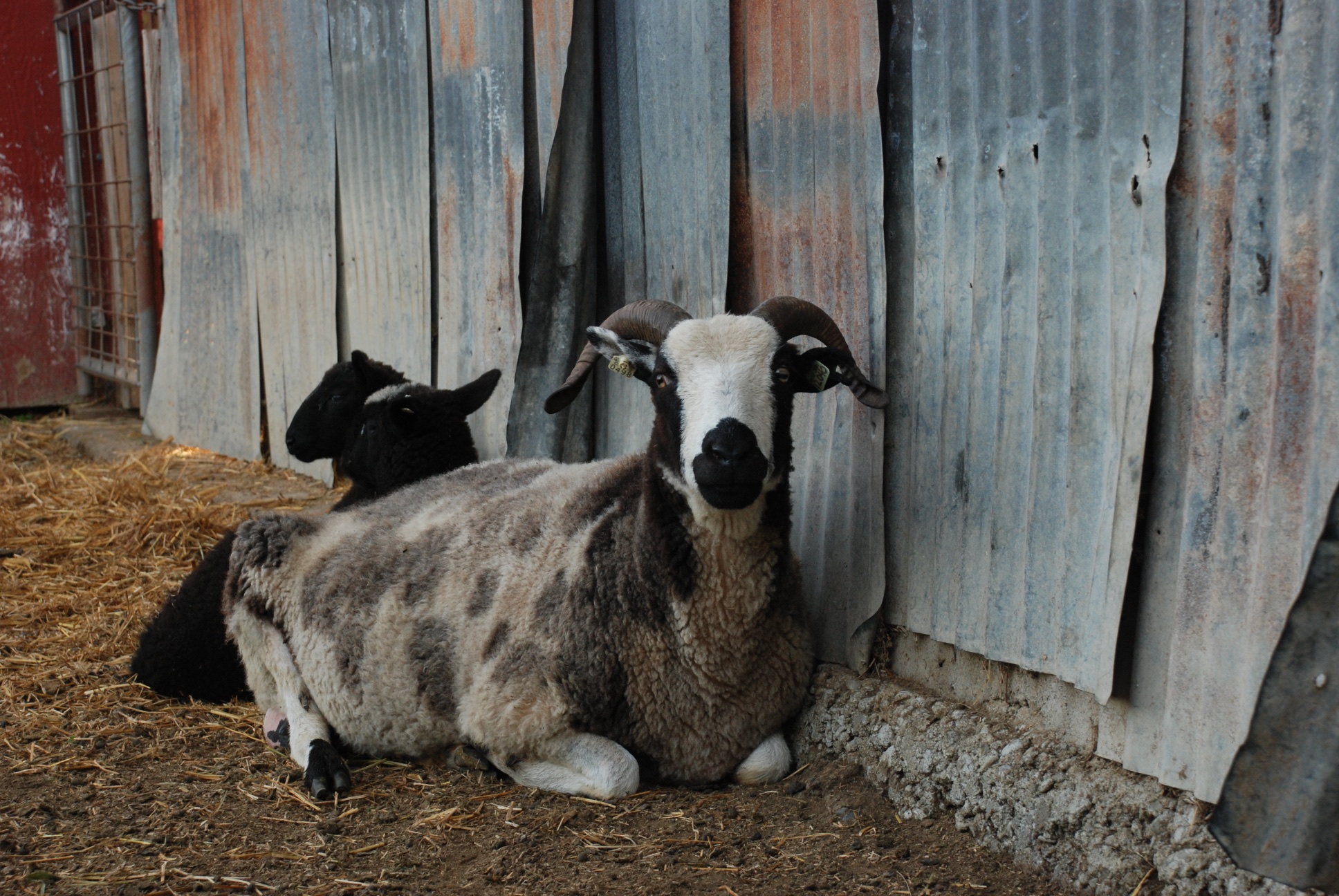 Fandango with lambs.
Fandango with lambs. Hot Lips and lamb.
Hot Lips and lamb. Alexandria and her lambs.
Alexandria and her lambs.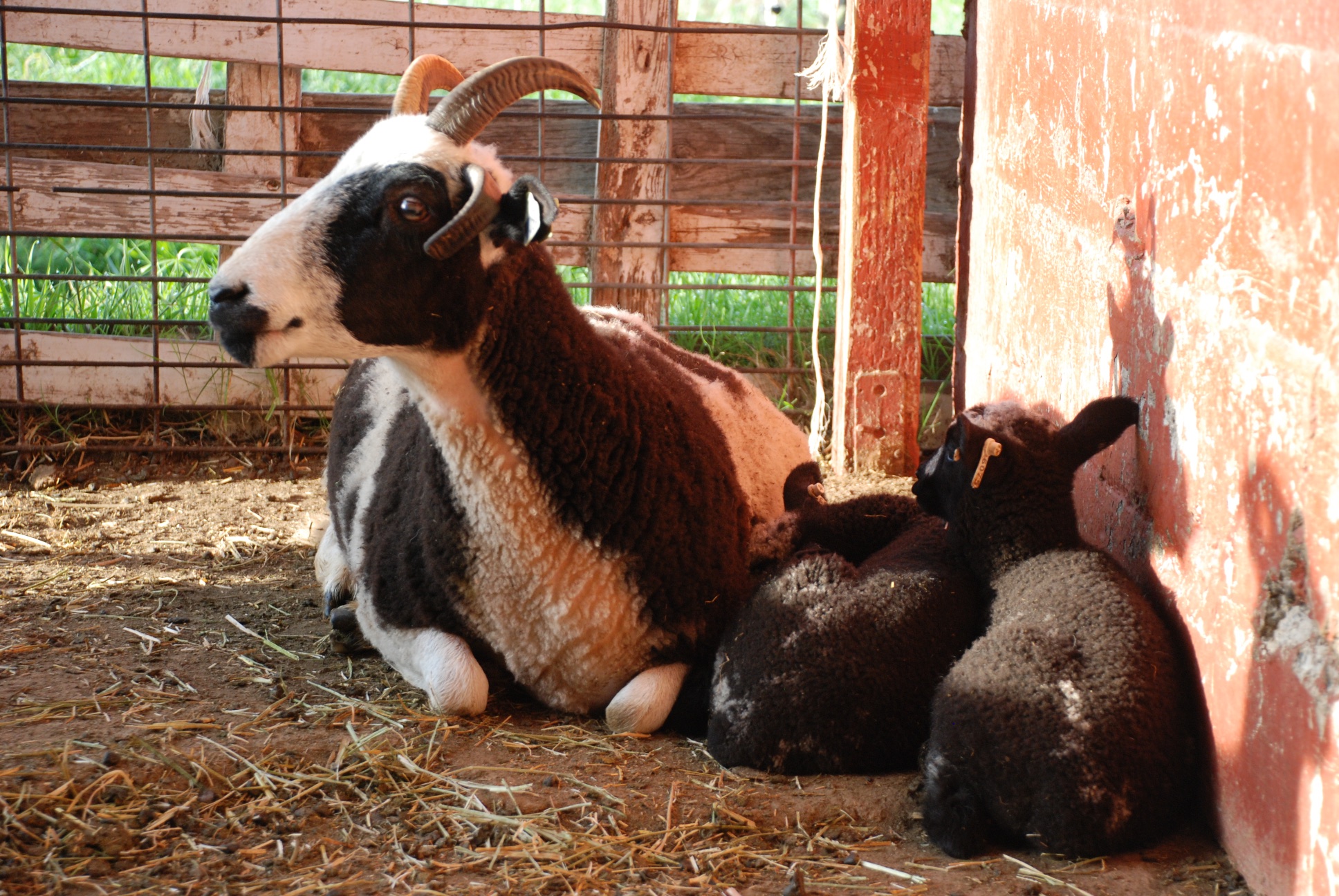 Isabelle with lambs.
Isabelle with lambs. Melinda and lambs.
Melinda and lambs.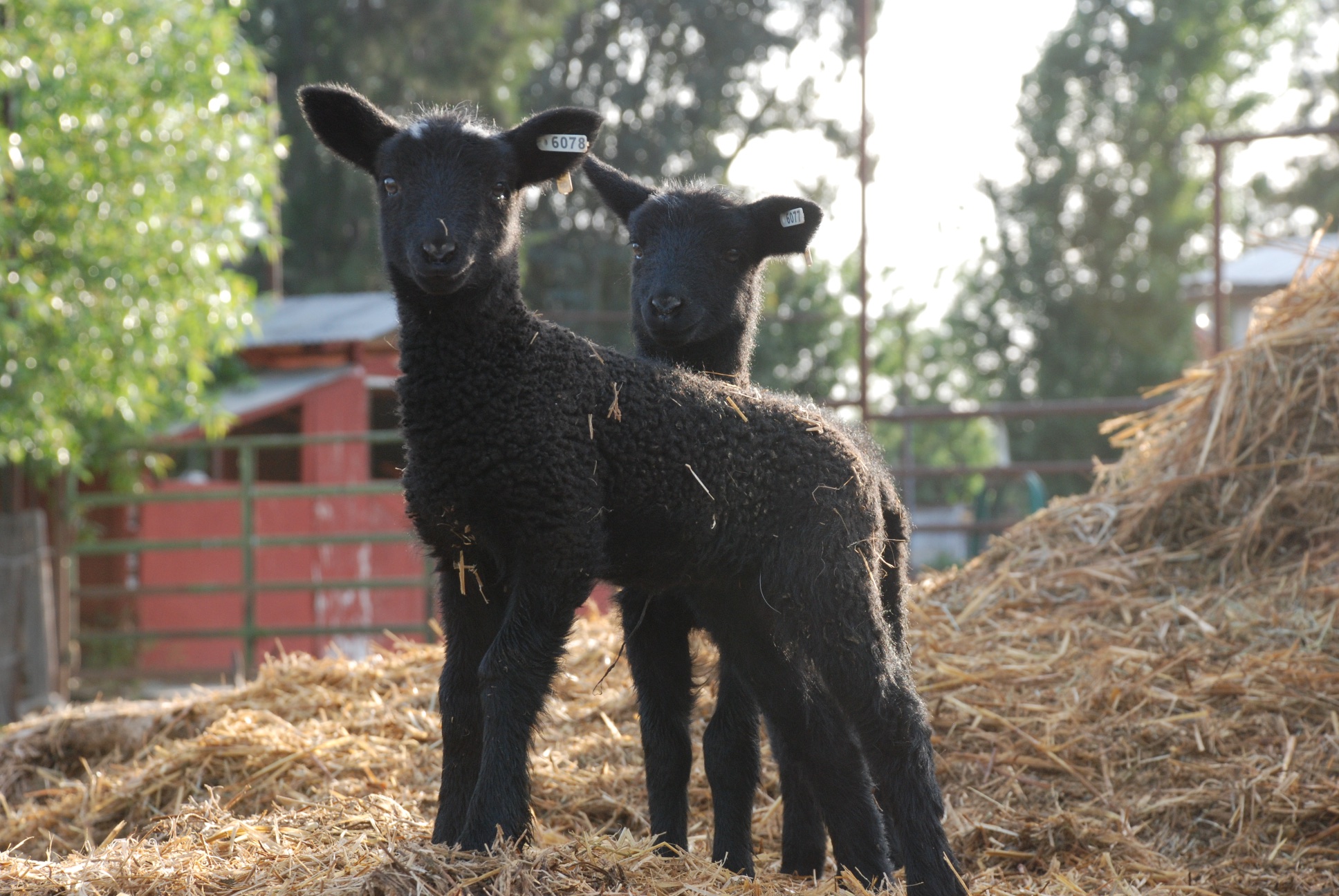 These were the last ones born this year.
These were the last ones born this year.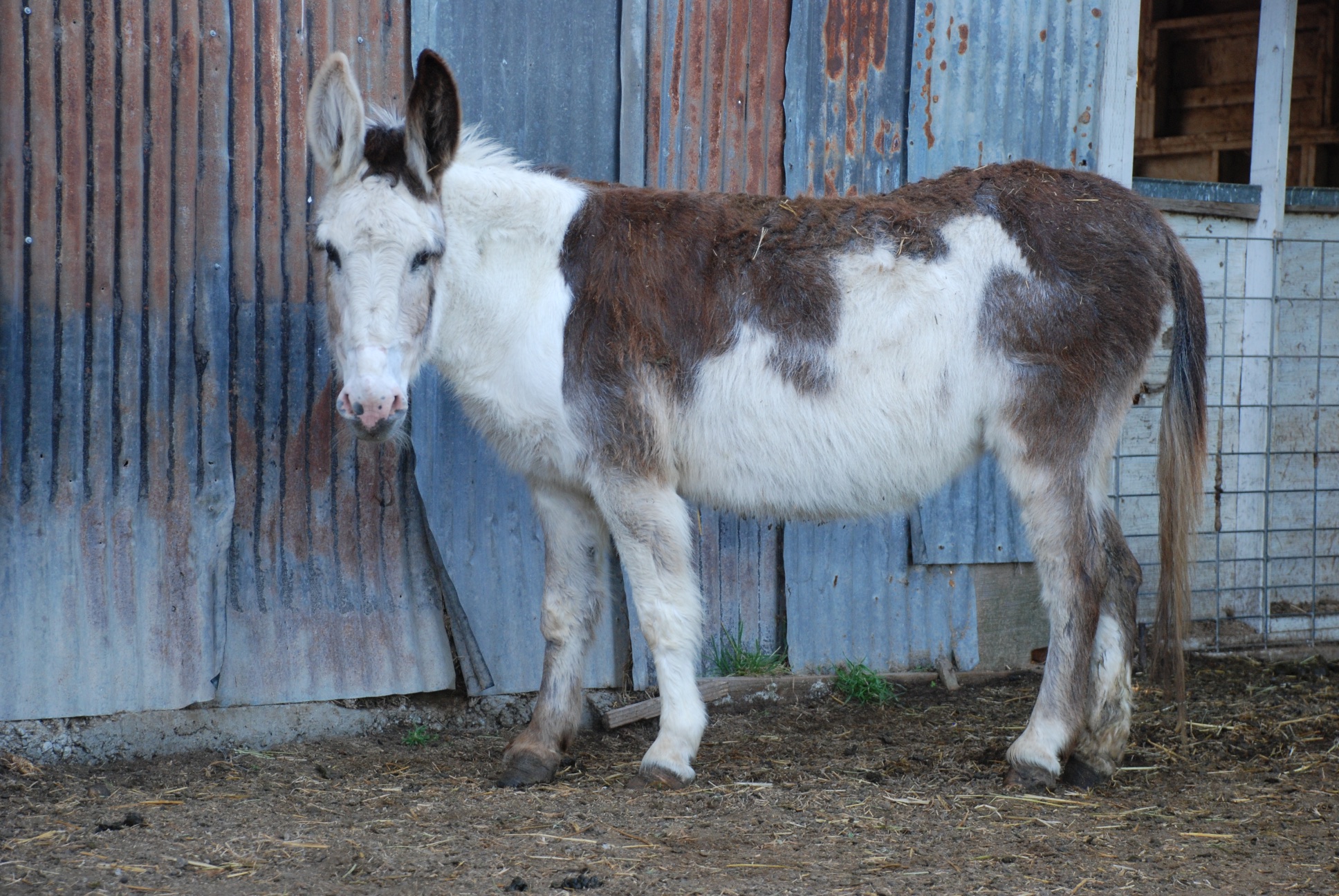 Amaryllis.
Amaryllis. Sheep looking hopeful as I climb back over the gate.
Sheep looking hopeful as I climb back over the gate.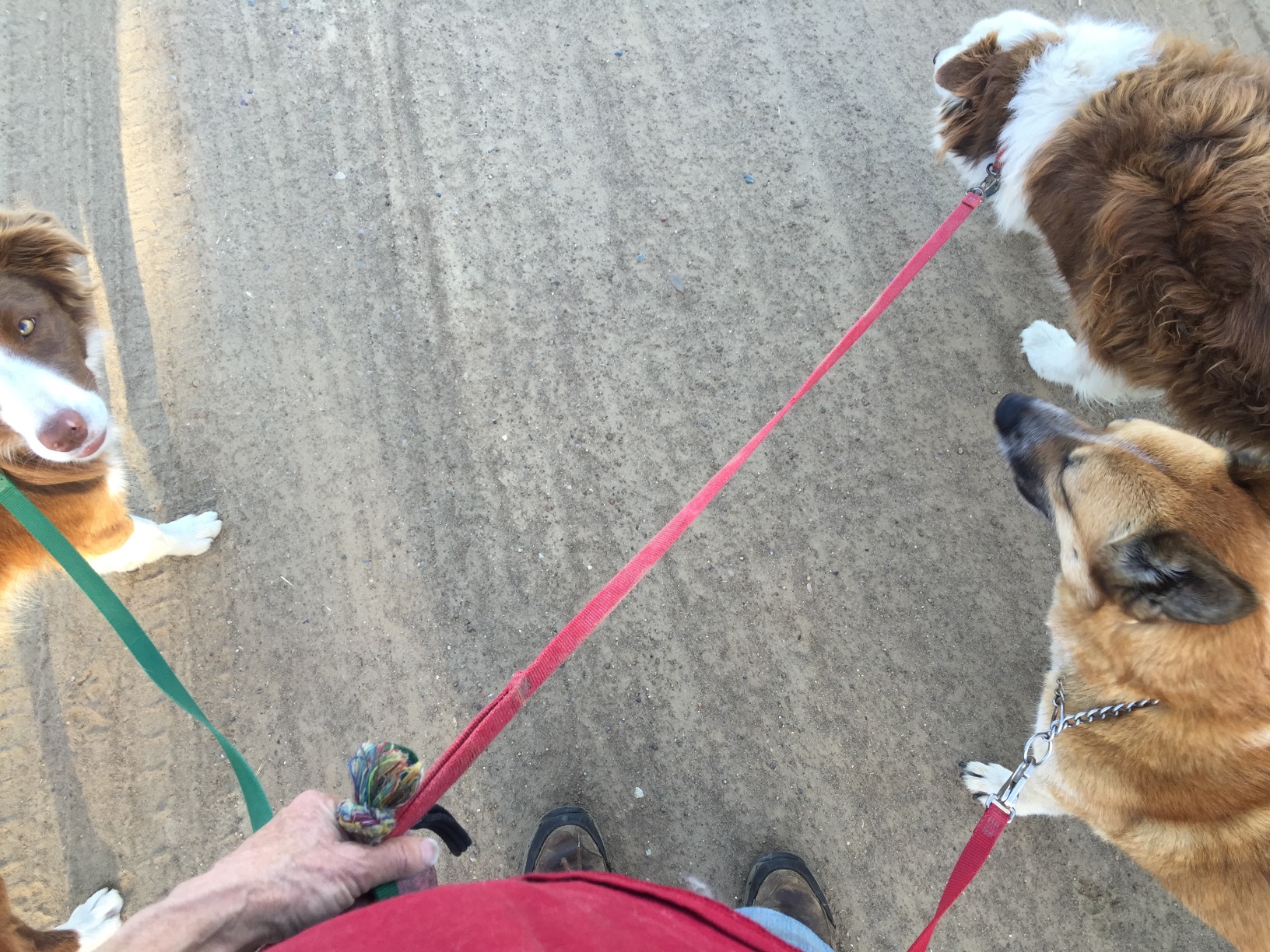 This was taken on the first walk a few weeks ago. The dogs are on the leash until we get off of Meridian Road.
This was taken on the first walk a few weeks ago. The dogs are on the leash until we get off of Meridian Road.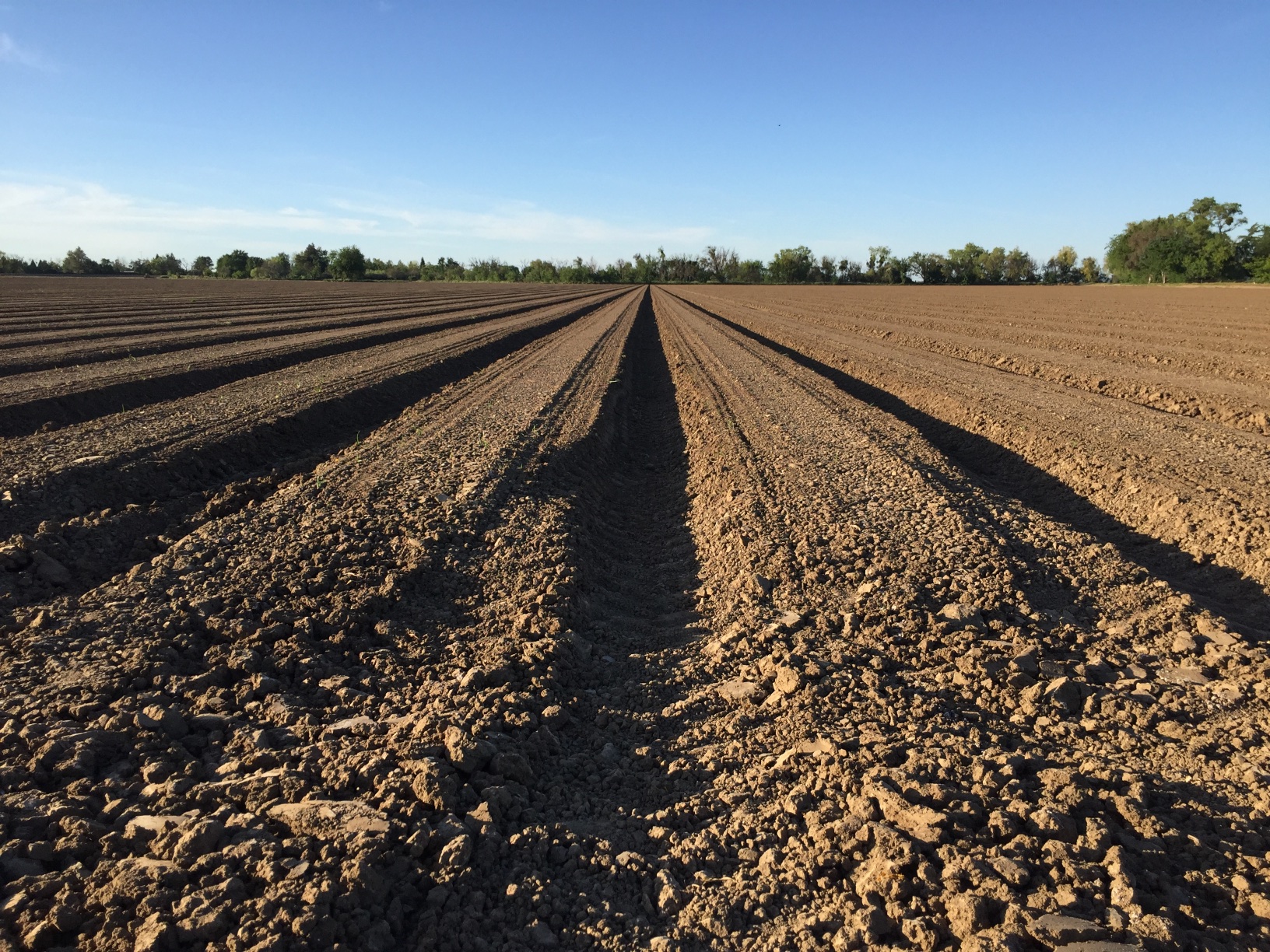 The field was bedded up and planted about two weeks ago.
The field was bedded up and planted about two weeks ago.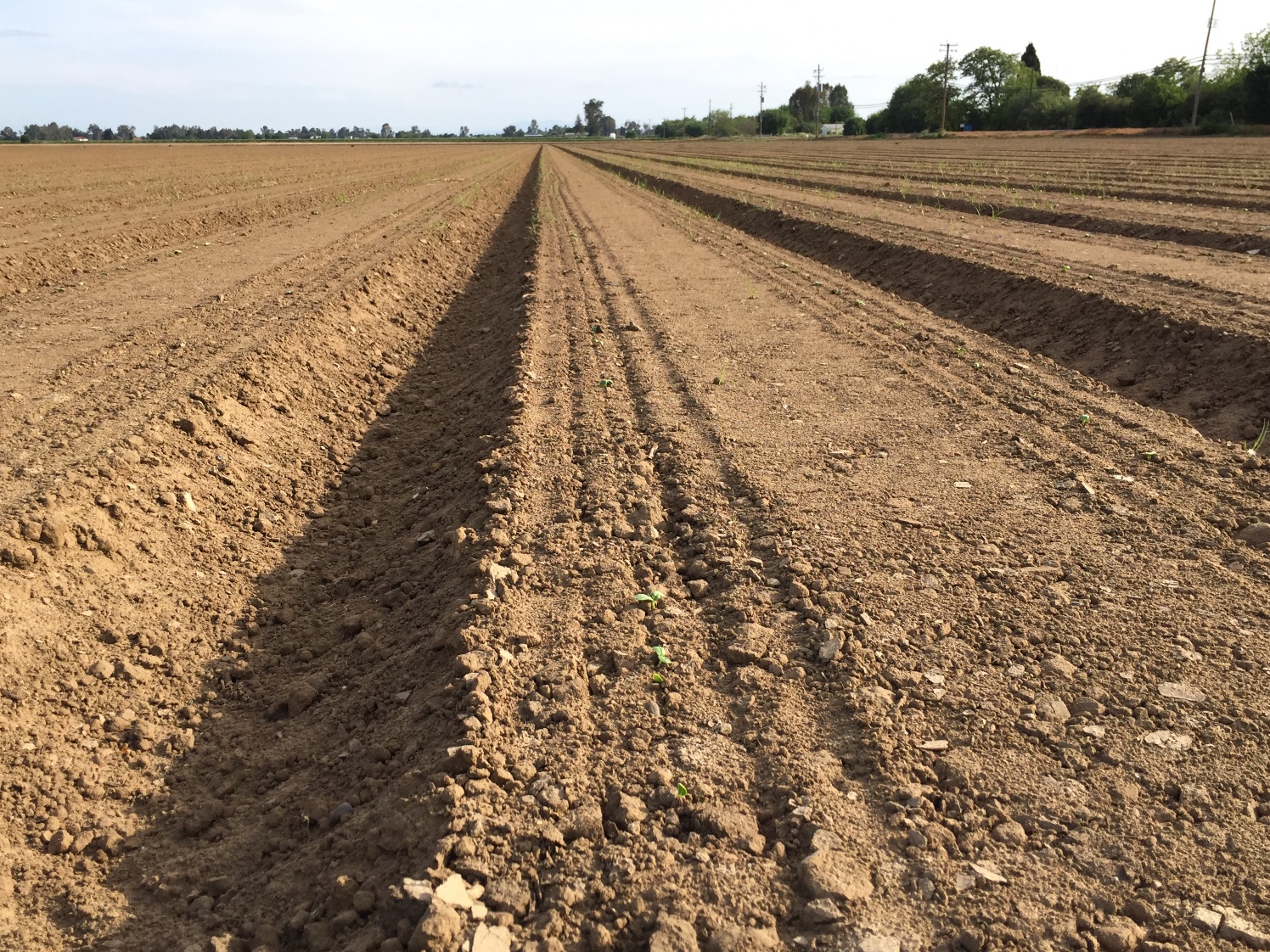 Can you see the sprouts when you look at one of the lines almost right in the middle of the photo? Those are sunflowers.
Can you see the sprouts when you look at one of the lines almost right in the middle of the photo? Those are sunflowers. The most exciting thing for the dogs is that the canals were filled about a week ago.
The most exciting thing for the dogs is that the canals were filled about a week ago. On the last walk I noticed that Rusty spent more time than usual in the water. He usually just goes in when he's hot and gets out again, but this time he spent time cruising (the best way to describe his half walking/half swimming) up the canal. I think his hips are bothering him so much that it felt better to move that way.
On the last walk I noticed that Rusty spent more time than usual in the water. He usually just goes in when he's hot and gets out again, but this time he spent time cruising (the best way to describe his half walking/half swimming) up the canal. I think his hips are bothering him so much that it felt better to move that way.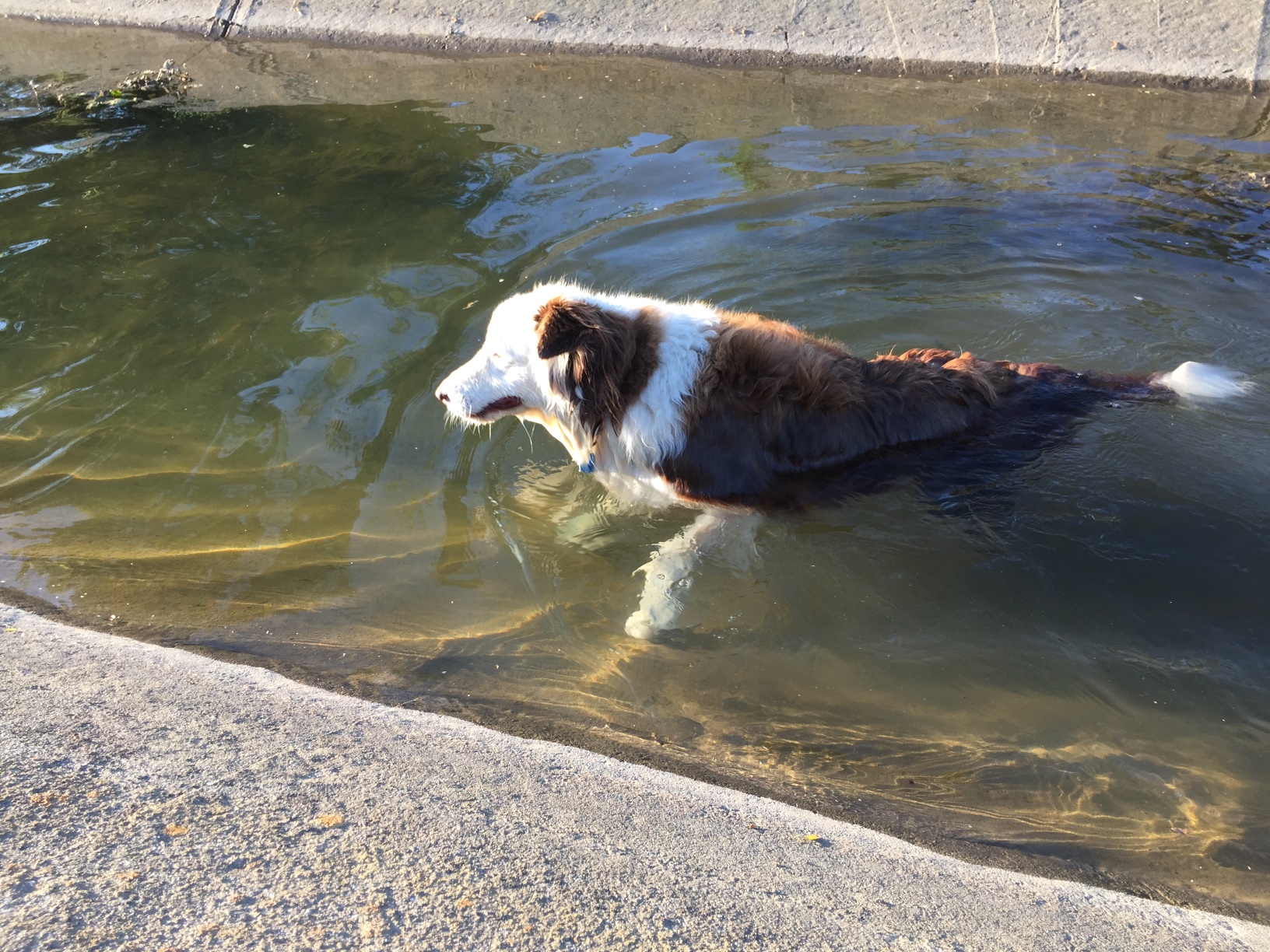 He also needs help getting out now. Last year I helped Ginny out. This year it will be Rusty.
He also needs help getting out now. Last year I helped Ginny out. This year it will be Rusty.  Wet dog.
Wet dog.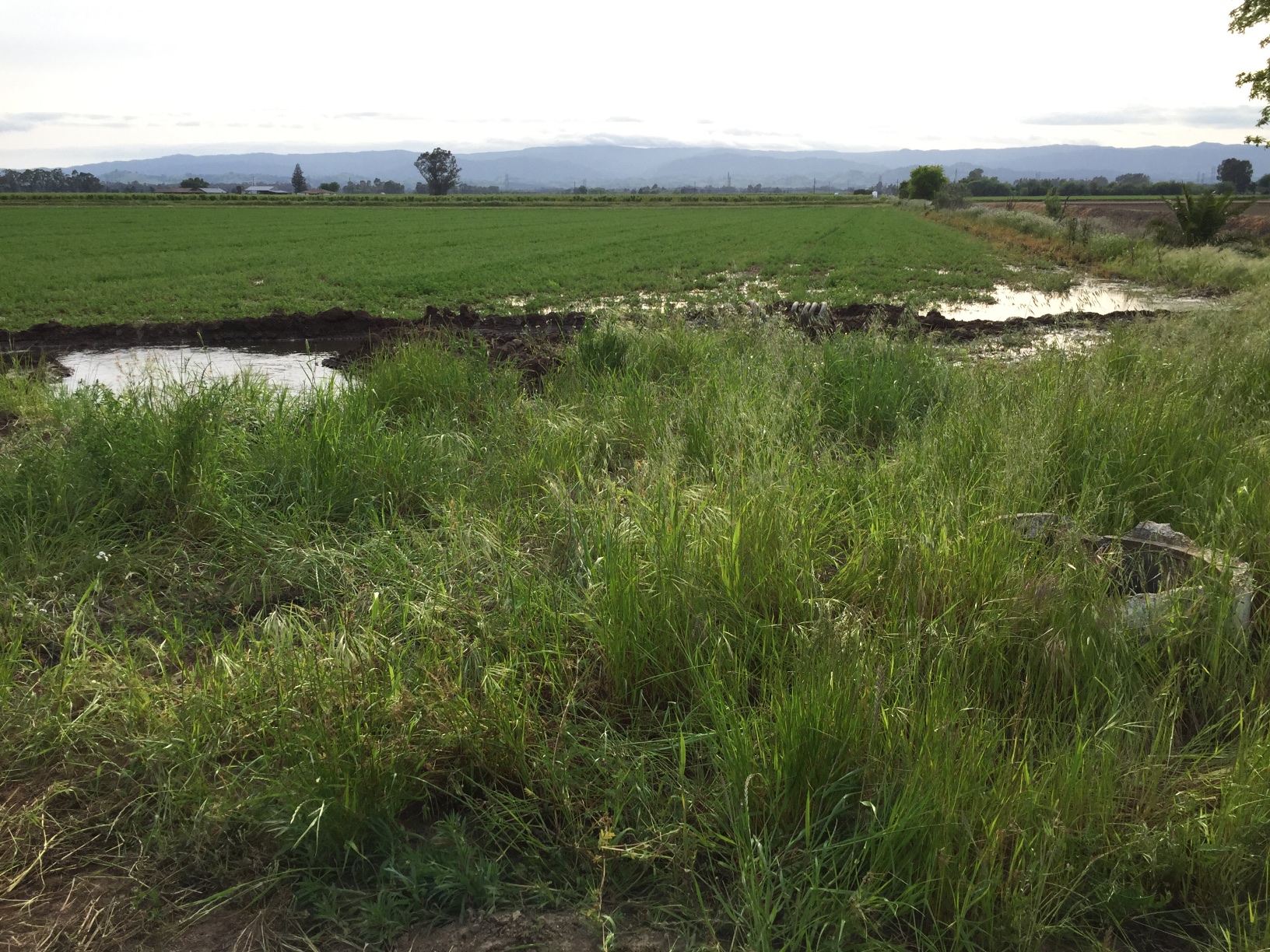 The alfalfa has been cut and baled once already and is now being irrigated.
The alfalfa has been cut and baled once already and is now being irrigated.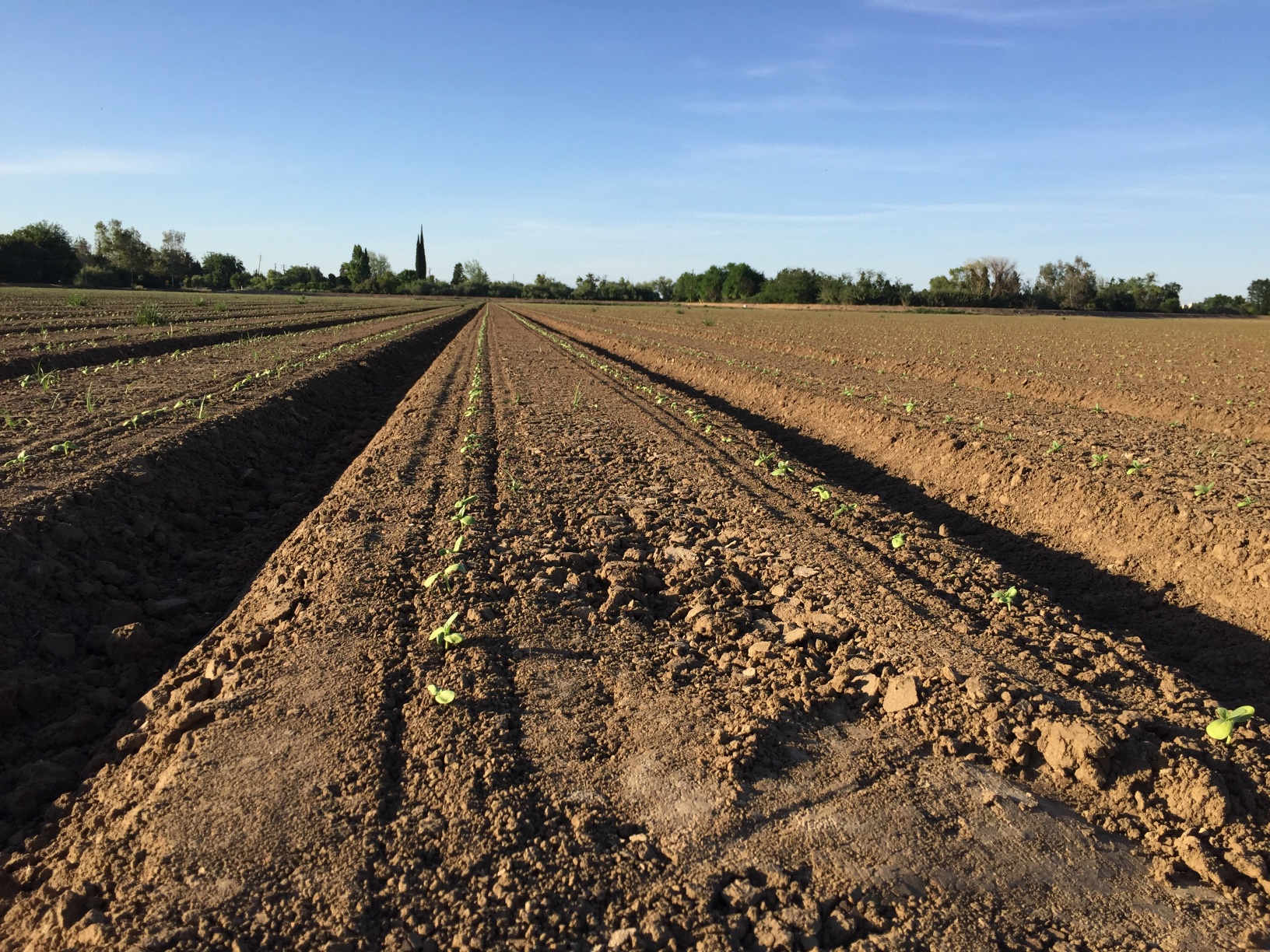 Here is another week's growth of the sunflowers.
Here is another week's growth of the sunflowers.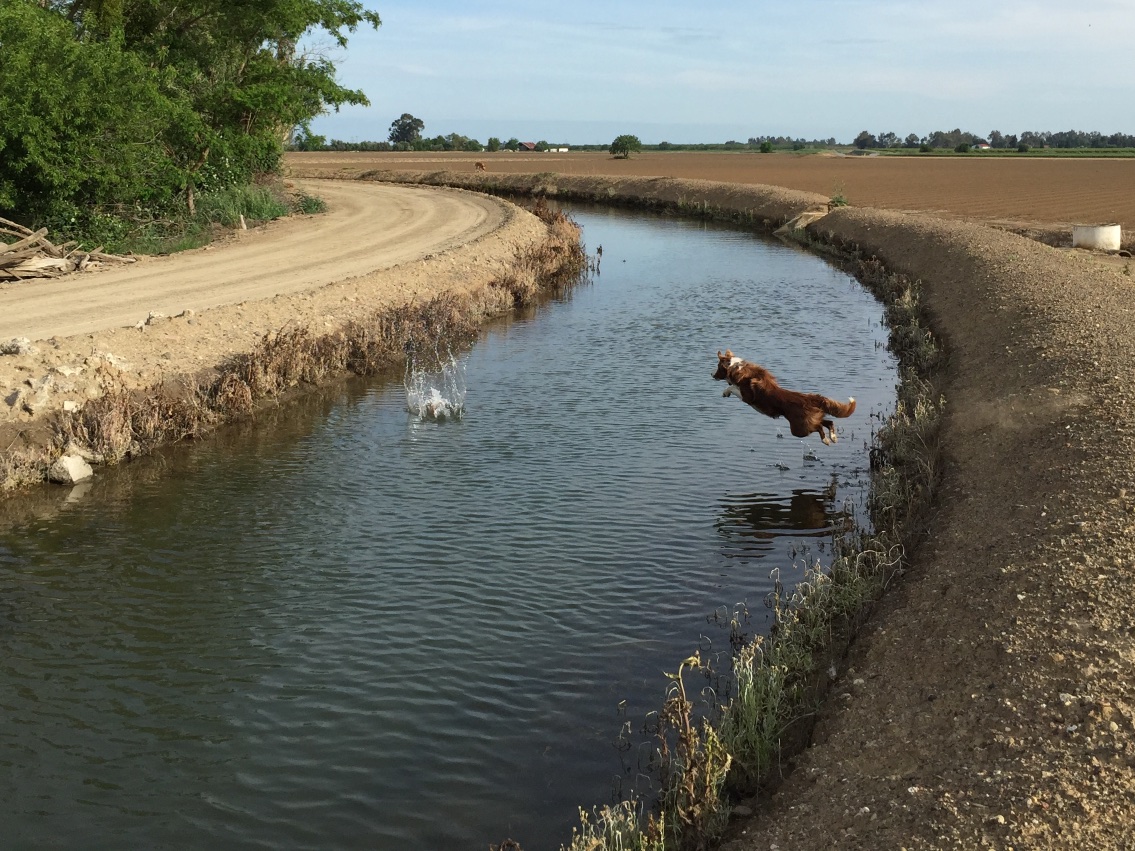 The best surprise for Ginny I think is that she got to chase the Toy into the water again. Rusty will have more of these photos on
The best surprise for Ginny I think is that she got to chase the Toy into the water again. Rusty will have more of these photos on  Kind of like
Kind of like  I got home from Modesto and went to the barn about 8 p.m. These lambs had been born within the hour. I don't know why this ewe took so long. She was marked as bred during the first week of lambing. I suspect that she miscarried and it took her 6 weeks to cycle again. Faulkner was the clean-up ram so all the last lambs are crossbreds.
I got home from Modesto and went to the barn about 8 p.m. These lambs had been born within the hour. I don't know why this ewe took so long. She was marked as bred during the first week of lambing. I suspect that she miscarried and it took her 6 weeks to cycle again. Faulkner was the clean-up ram so all the last lambs are crossbreds. This is my lambing board. I'll have the stats figured out at a later date.
This is my lambing board. I'll have the stats figured out at a later date. This photo doesn't do justice to the pile of stuff. Most of them are still out in the aisle. A couple of people stopped by and were amazed that I actually fit it all in. What you don't notice in the photo because of the black drapes are the 16 gridwall panels that create the booth. Those get heavier every year.
This photo doesn't do justice to the pile of stuff. Most of them are still out in the aisle. A couple of people stopped by and were amazed that I actually fit it all in. What you don't notice in the photo because of the black drapes are the 16 gridwall panels that create the booth. Those get heavier every year. I got to Modesto about 4:30 p.m., worked until 8:40 on Thursday and then from about 9:30 to 1:30 today. The show opened at 2. Here is a tour of my booth:
I got to Modesto about 4:30 p.m., worked until 8:40 on Thursday and then from about 9:30 to 1:30 today. The show opened at 2. Here is a tour of my booth: Rusty's Yarn faces the aisle.
Rusty's Yarn faces the aisle. On the 3-grid tower in the middle I have the Meow and Woof yarns...
On the 3-grid tower in the middle I have the Meow and Woof yarns... ...Sprout yarns...
...Sprout yarns... ...and Mountain Meadows, all fingering weight yarns with sample scarves.
...and Mountain Meadows, all fingering weight yarns with sample scarves. Around the inside of the booth is the Timm Ranch yarn with blankets I wove and Mary's beautiful shawl. There are Jacob sheepskins too--only a few left.
Around the inside of the booth is the Timm Ranch yarn with blankets I wove and Mary's beautiful shawl. There are Jacob sheepskins too--only a few left. Moving to the left there is the Jacob yarn and Imperial Yarn Company's "Anna", a wool/cotton yarn that weaves up quickly (at 5 epi).
Moving to the left there is the Jacob yarn and Imperial Yarn Company's "Anna", a wool/cotton yarn that weaves up quickly (at 5 epi). Going around the back wall I have rigid heddle looms from Ashford and Schacht and the Ashford "Katie", which is a wonderful very portable 8-shaft table loom.
Going around the back wall I have rigid heddle looms from Ashford and Schacht and the Ashford "Katie", which is a wonderful very portable 8-shaft table loom. Purl & Loop Stash Blaster looms and Swatch Maker looms are brand new. Next to them are the Zoom looms with the critter kits that use squares made on the them.
Purl & Loop Stash Blaster looms and Swatch Maker looms are brand new. Next to them are the Zoom looms with the critter kits that use squares made on the them. Coming around the corner I have photo notecards, buttons, and Meridian Jacobs bags and aprons.
Coming around the corner I have photo notecards, buttons, and Meridian Jacobs bags and aprons. I have added to the horn buttons. My son helped finish off another batch.
I have added to the horn buttons. My son helped finish off another batch. Last there is Cormo Sport yarn dyed by Sincere Sheep. You can see one of the samples that I wove. It is incredibly soft and spongy (not a good wool term, but is it better than squishy? I probably need a different adjective, but it's late.) I brought Power Scour, etc with me but barely found room for a few bottles.
I left an awful lot home but tried to bring mostly things that I didn't think other vendors would have. I left home books and most of the equipment and had to gamble on which yarns to bring. I hope that tonight's TV news coverage of the "yarn bombing" in Modesto (that I haven't seen but heard about) will bring customers to the show tomorrow and make this all worthwhile.
Last there is Cormo Sport yarn dyed by Sincere Sheep. You can see one of the samples that I wove. It is incredibly soft and spongy (not a good wool term, but is it better than squishy? I probably need a different adjective, but it's late.) I brought Power Scour, etc with me but barely found room for a few bottles.
I left an awful lot home but tried to bring mostly things that I didn't think other vendors would have. I left home books and most of the equipment and had to gamble on which yarns to bring. I hope that tonight's TV news coverage of the "yarn bombing" in Modesto (that I haven't seen but heard about) will bring customers to the show tomorrow and make this all worthwhile.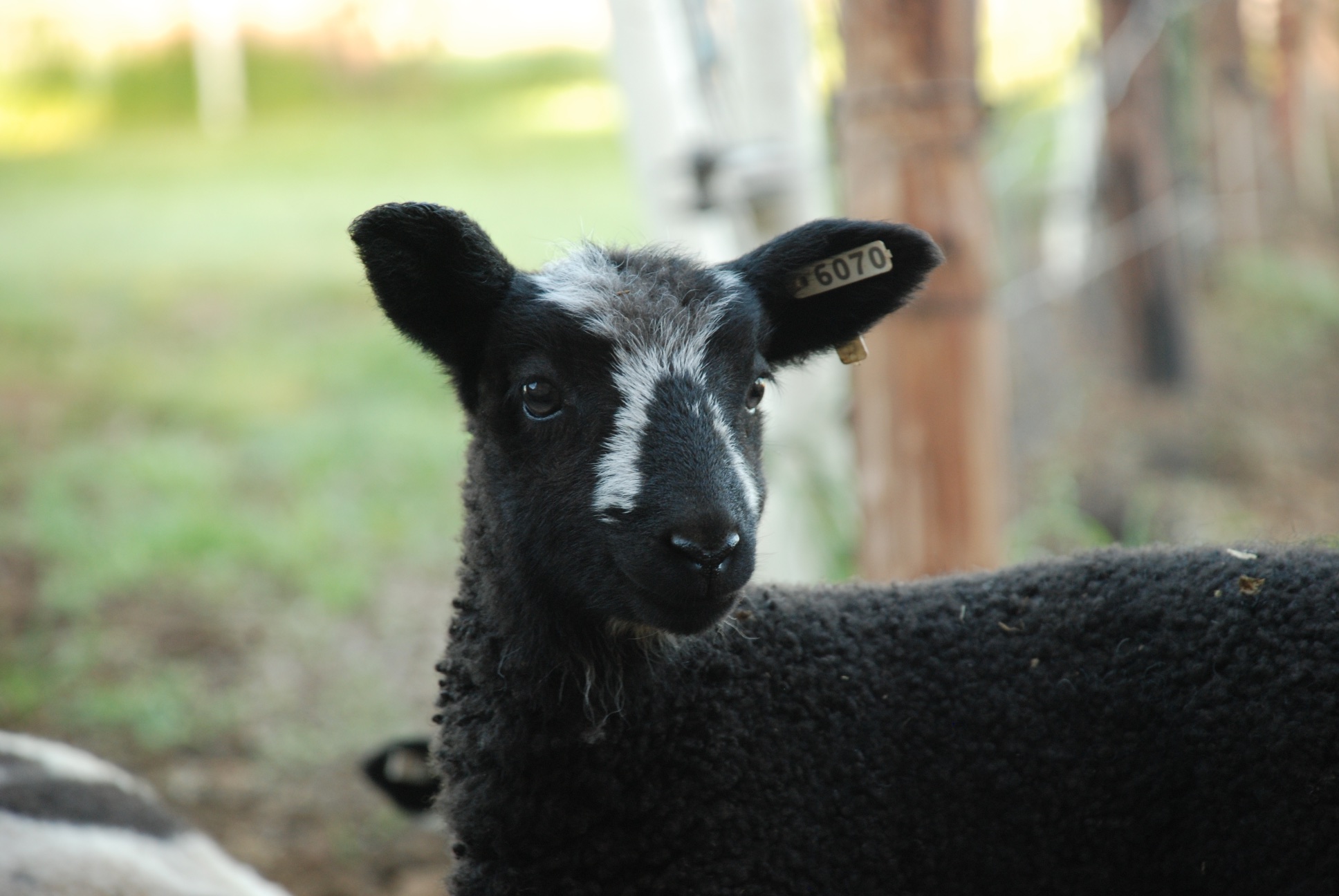
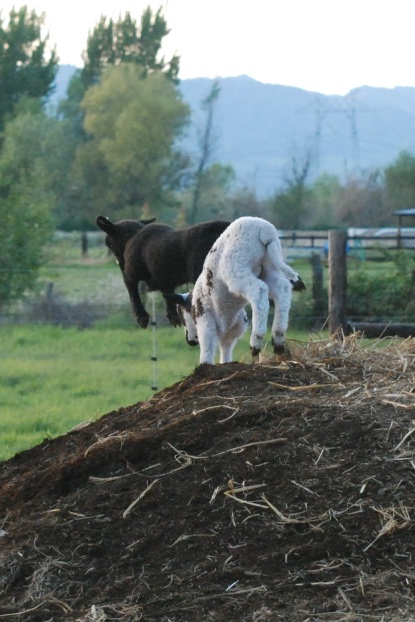
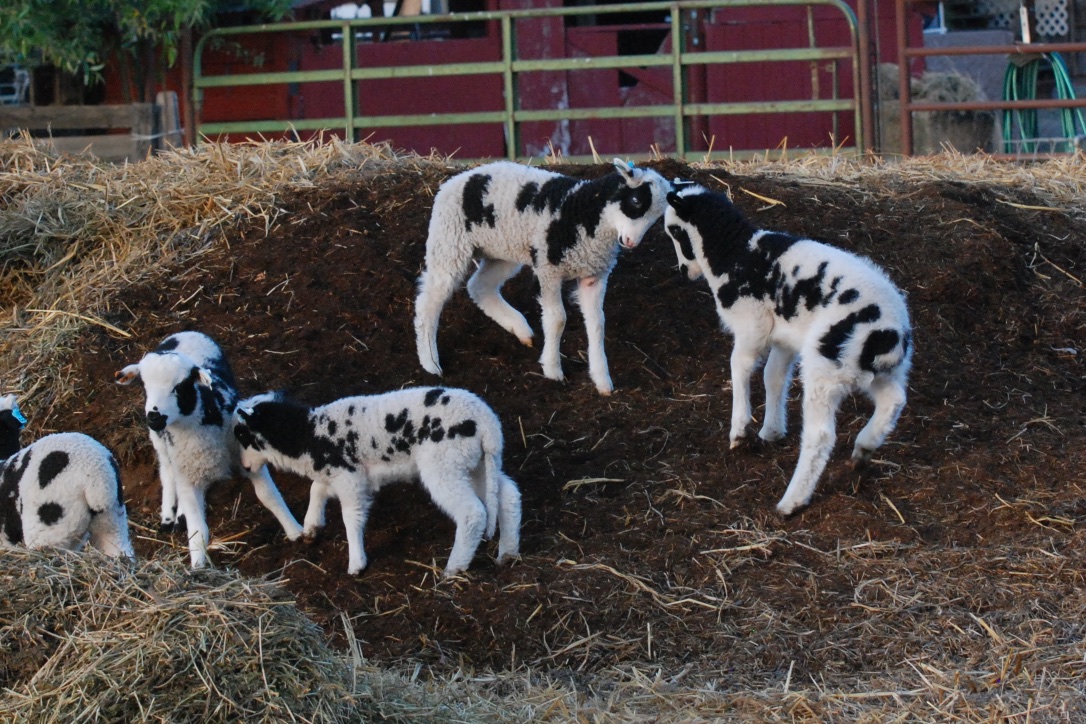
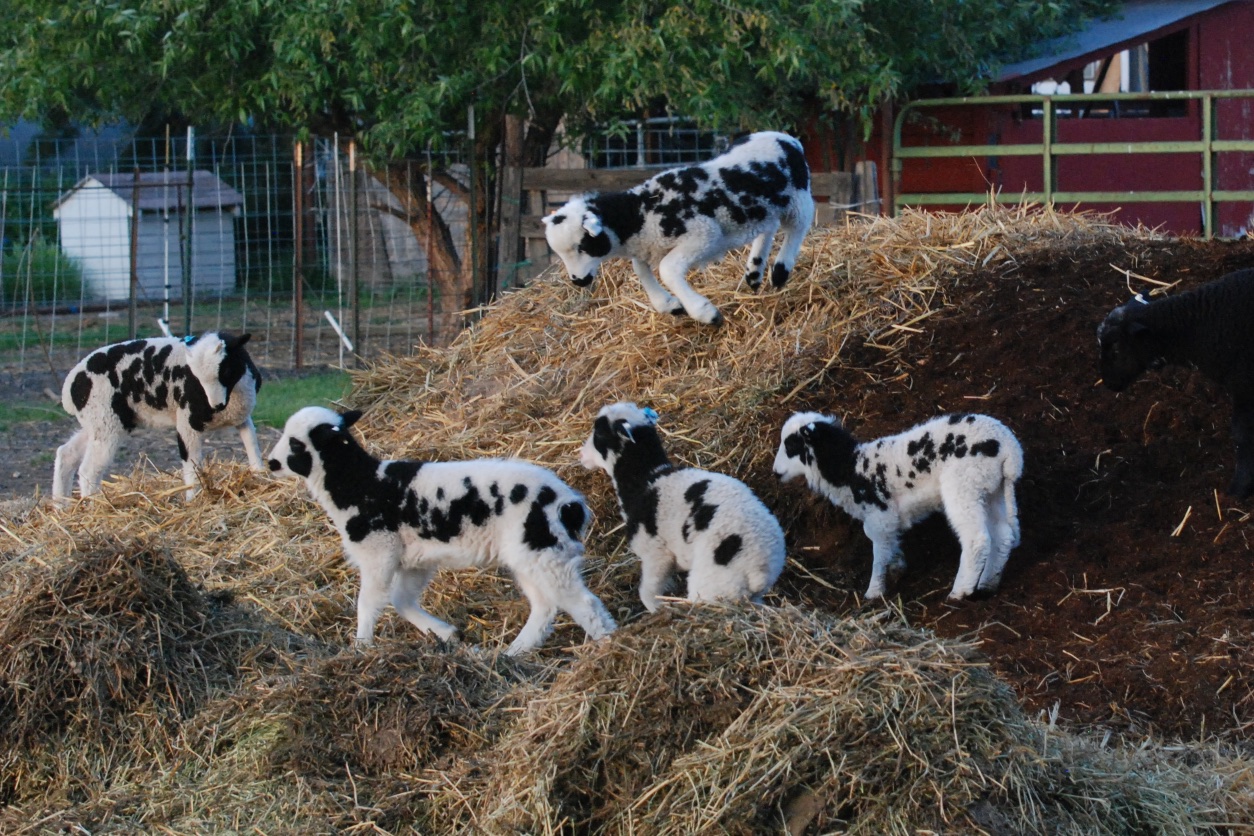

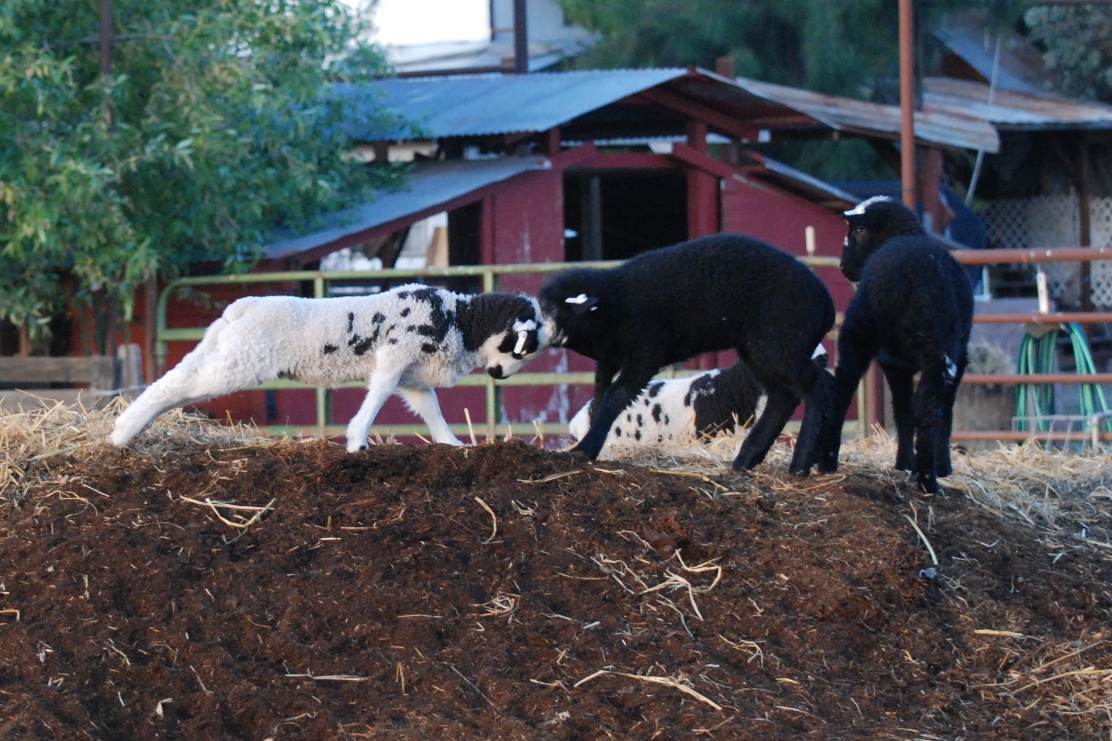
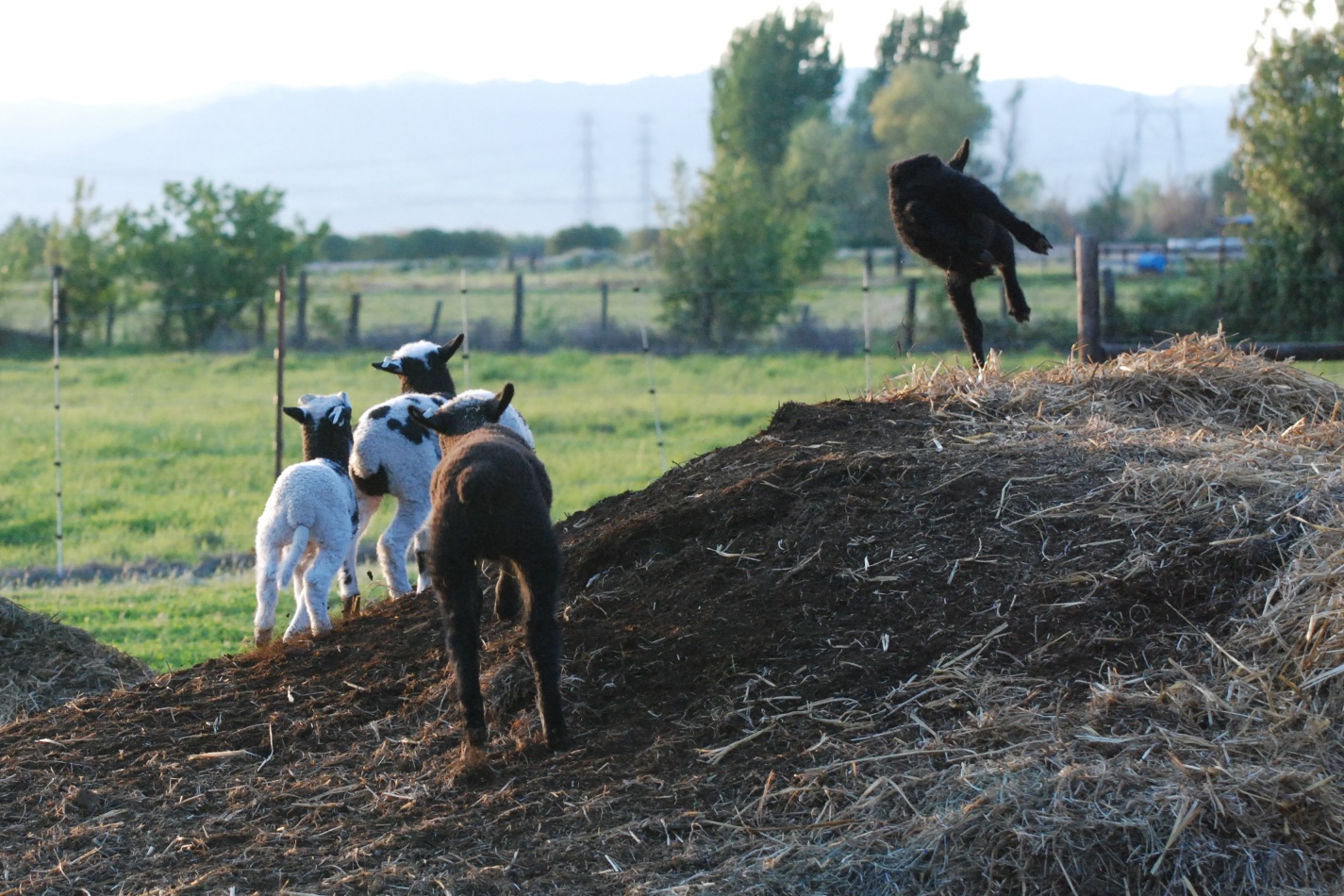


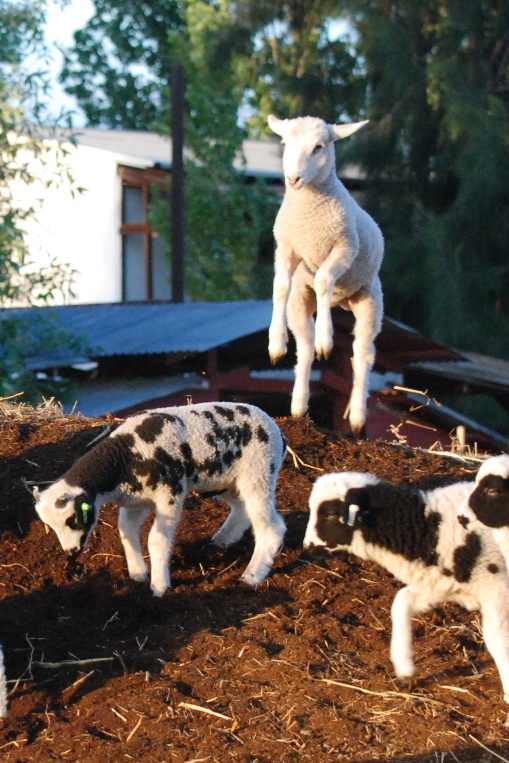
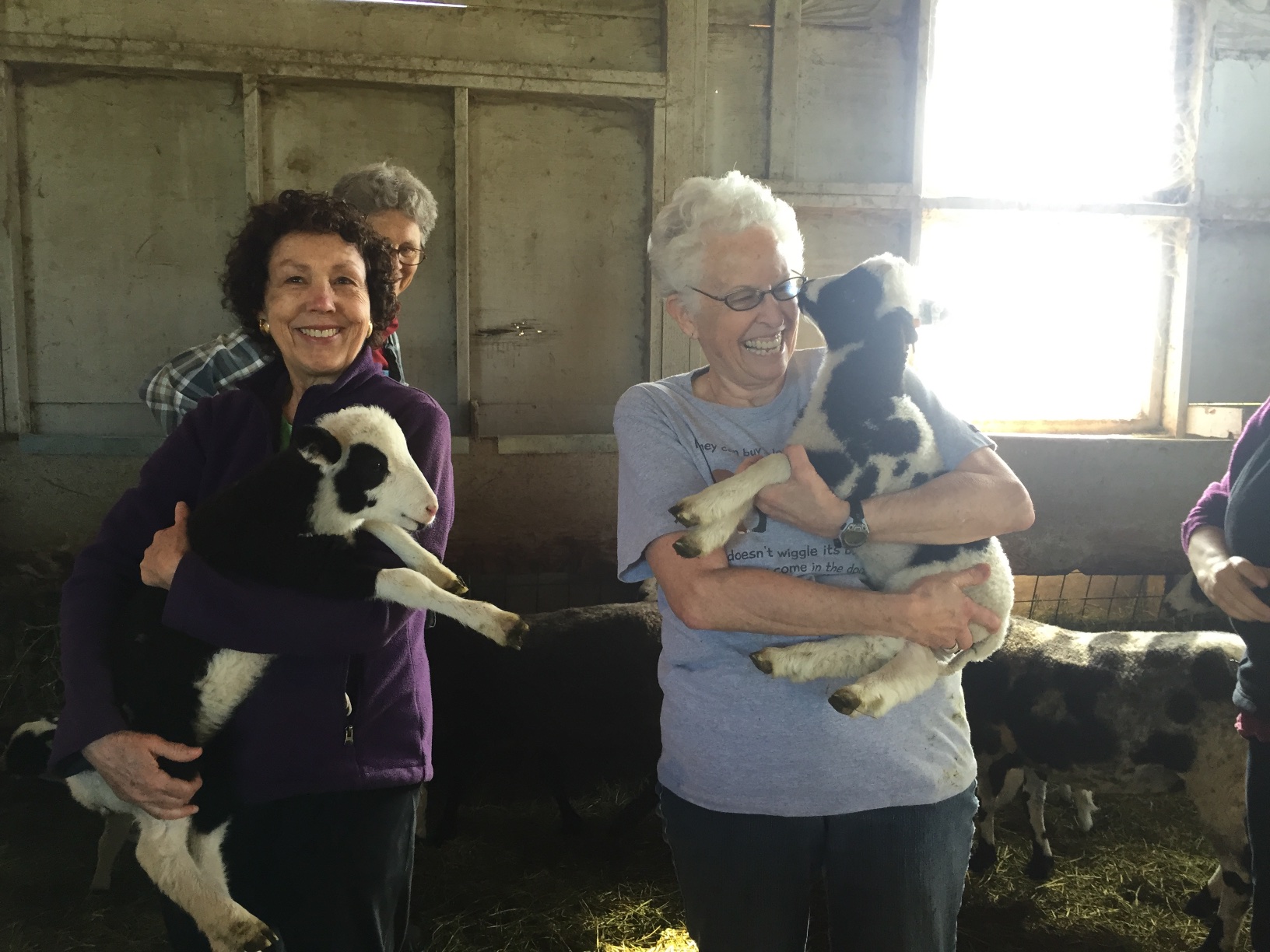 We caught all the lambs to check for number of horns and split eyelids (a trait that is sometimes seen in 4-horn lambs).
We caught all the lambs to check for number of horns and split eyelids (a trait that is sometimes seen in 4-horn lambs). 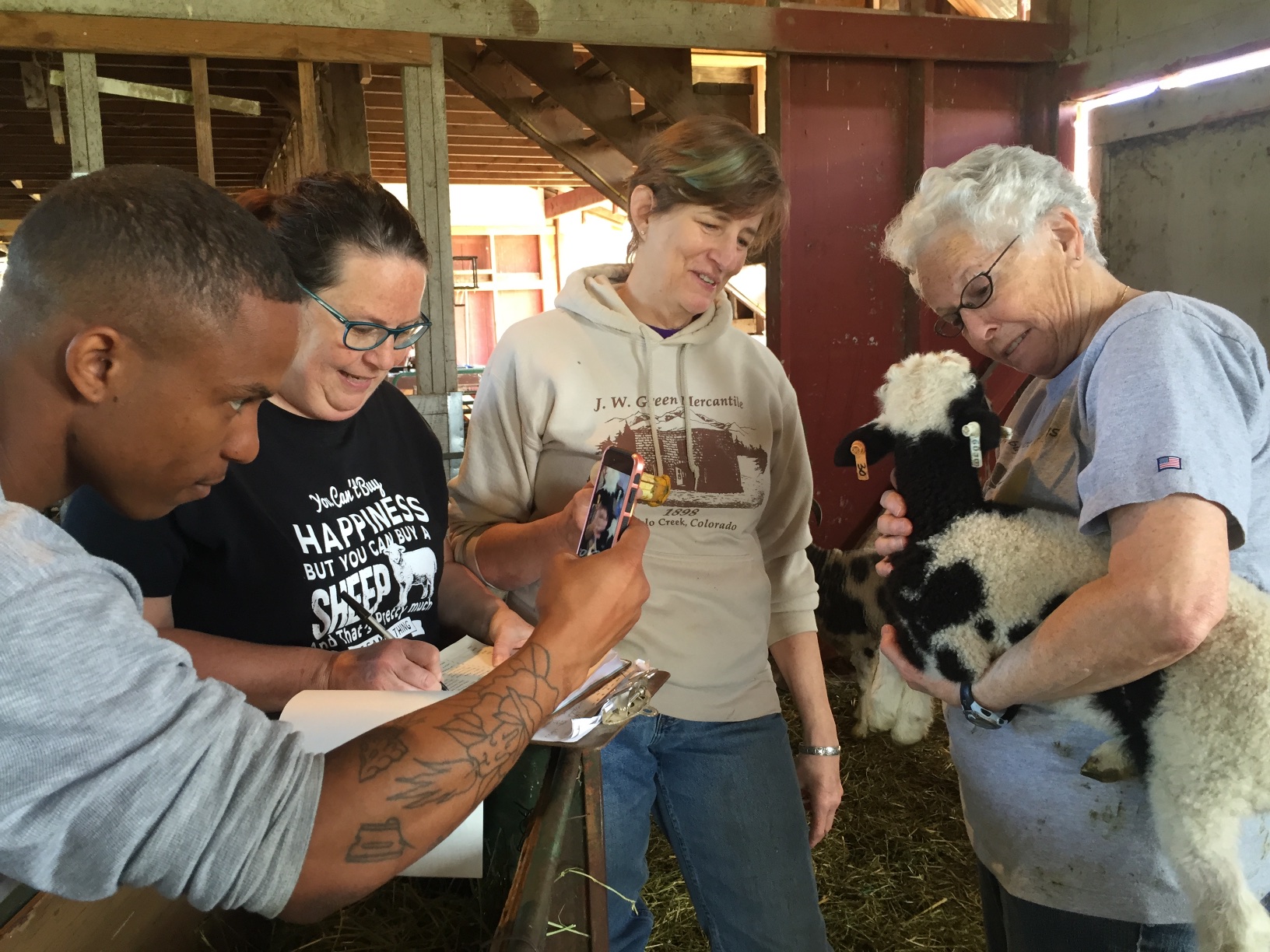 This was also a good time to check the paperwork and make sure that I had recorded the gender and sires correctly.
This was also a good time to check the paperwork and make sure that I had recorded the gender and sires correctly.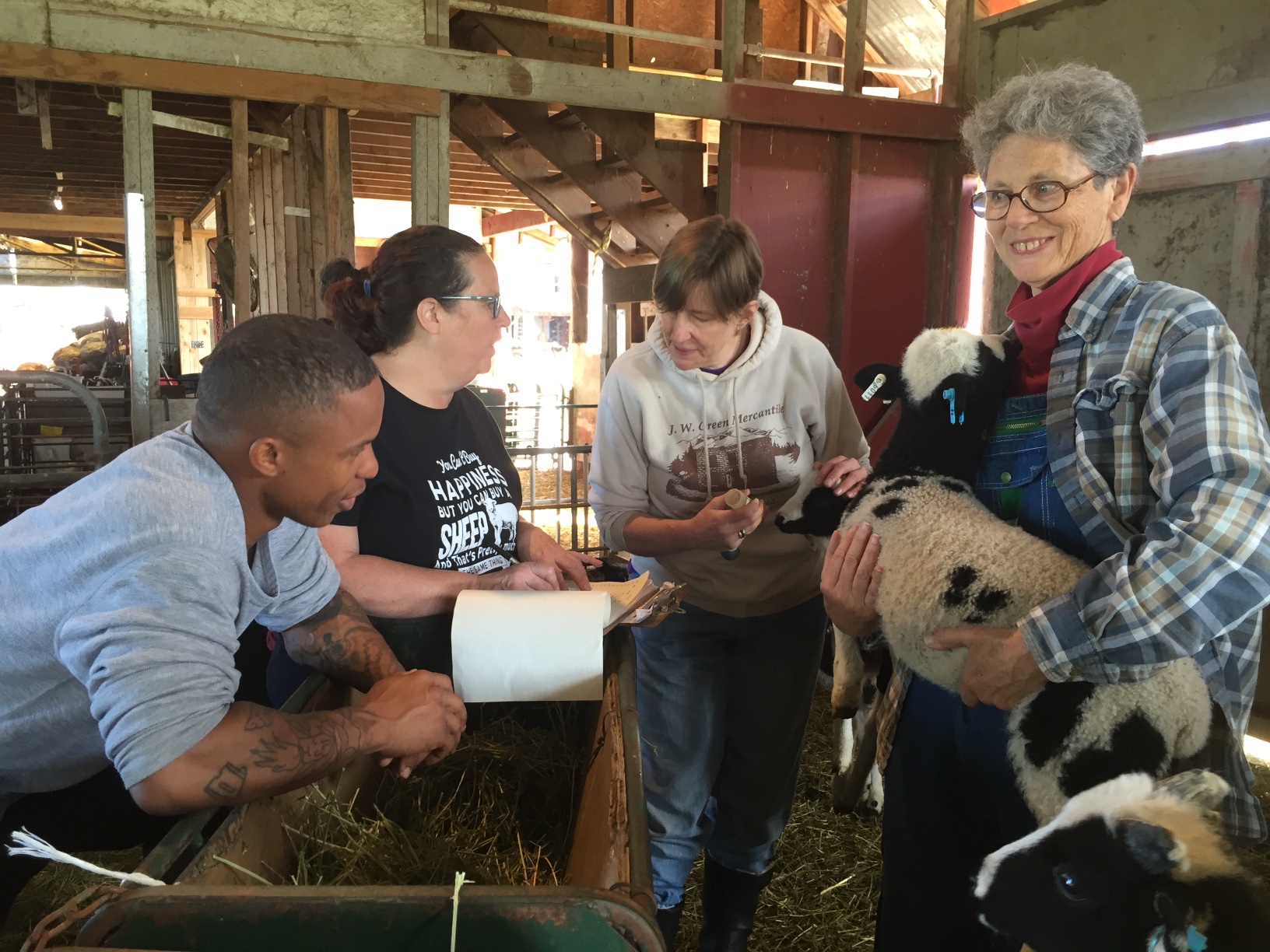 My neighbor who recently purchased sheep was here also to get some hands-on experience. He told me that a recently purchased goat had kidded that morning and he wasn't sure the kid had nursed.
My neighbor who recently purchased sheep was here also to get some hands-on experience. He told me that a recently purchased goat had kidded that morning and he wasn't sure the kid had nursed. I went to his place at lunchtime to check on the kid and while he held the doe (very skittish) I got the kid nursing.
I went to his place at lunchtime to check on the kid and while he held the doe (very skittish) I got the kid nursing.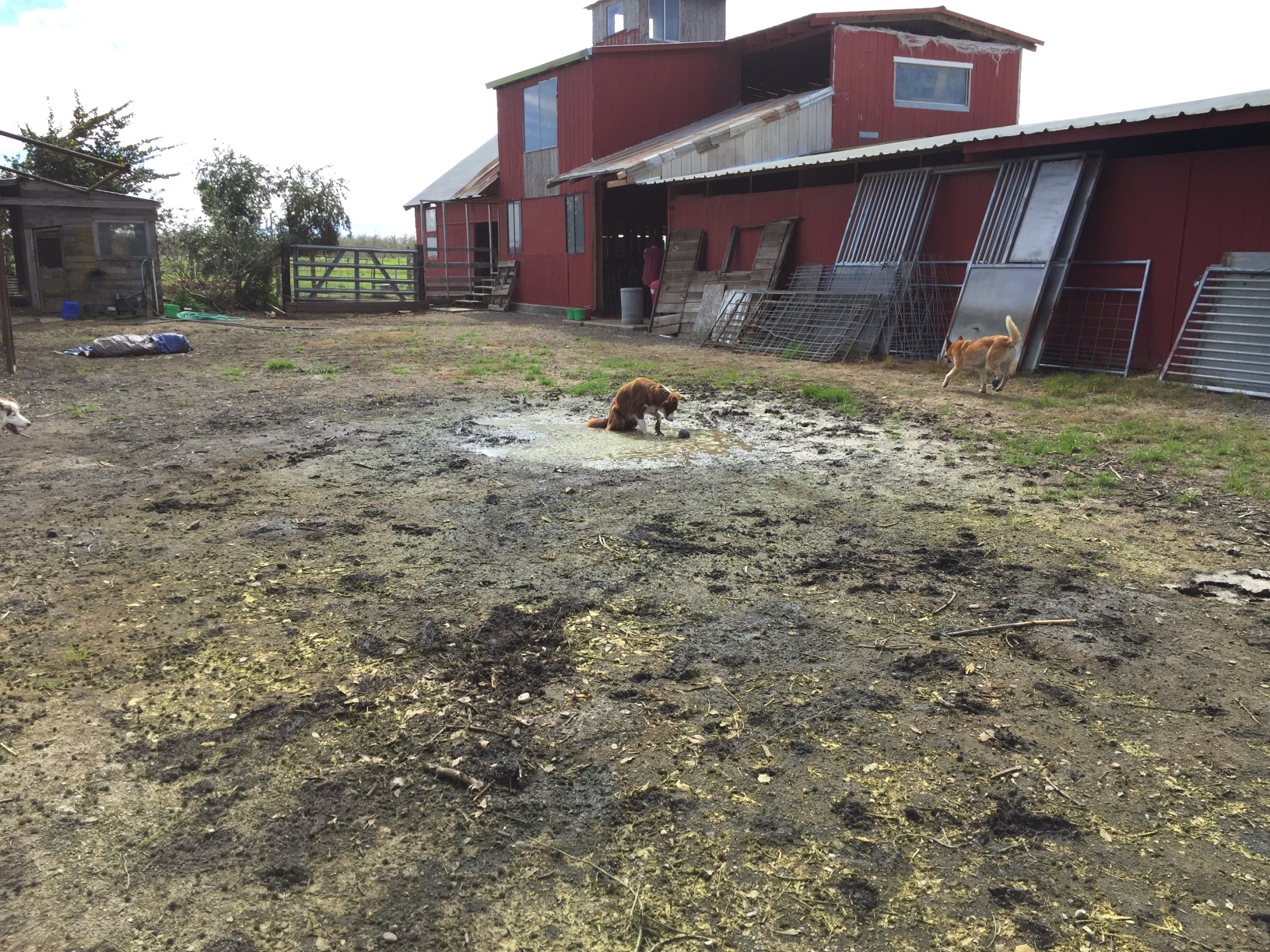 Back at our place, we finished moving sheep around. I moved "Ginny's flock" of wethers and she was so hot when she was finished that she found the only accessible mud puddle to sit in.
Back at our place, we finished moving sheep around. I moved "Ginny's flock" of wethers and she was so hot when she was finished that she found the only accessible mud puddle to sit in.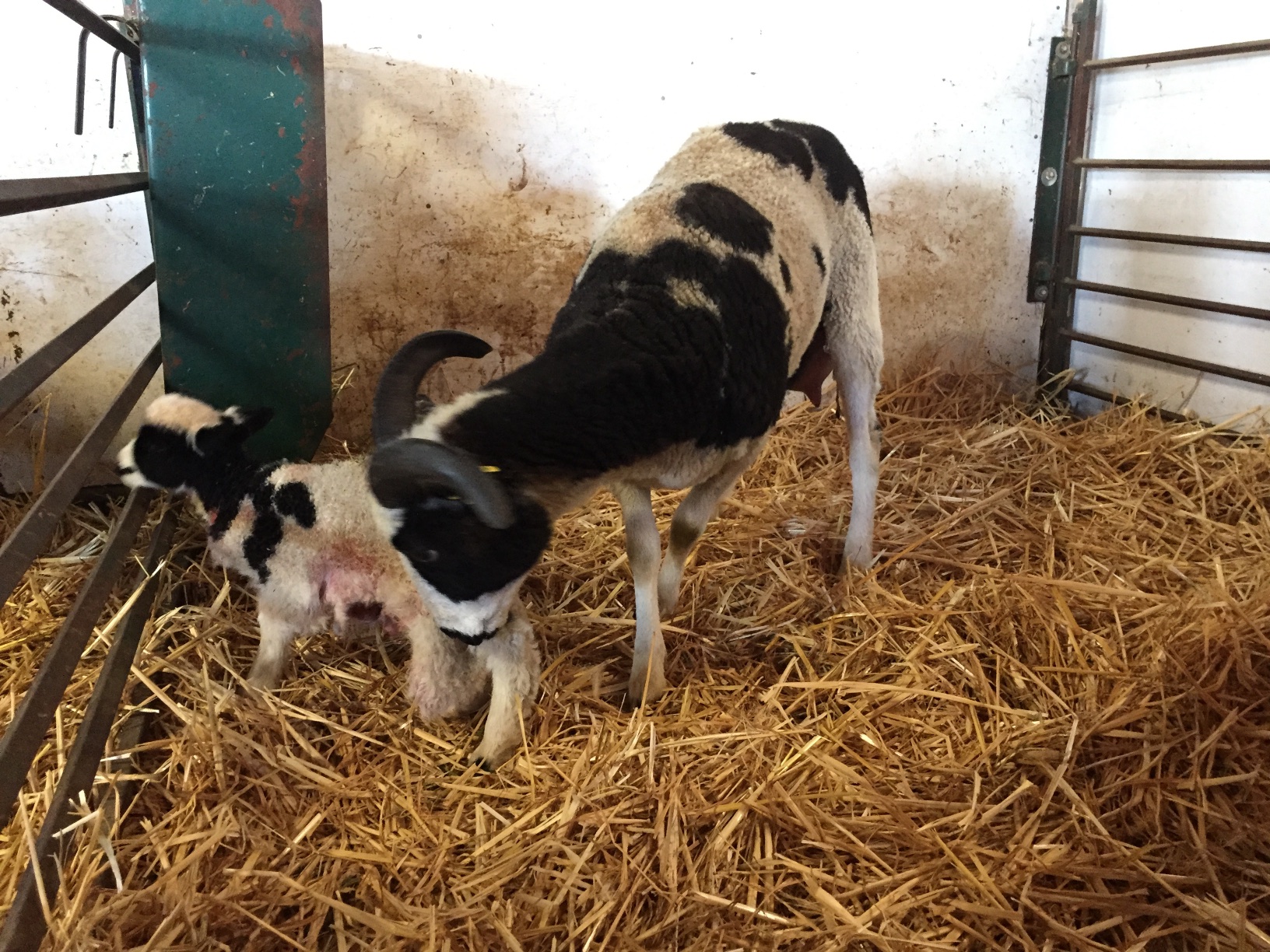 Last in the afternoon we decided to try grafting a lamb onto a ewe whose lamb had been killed the day before. I had debated it that day and at the time didn't want to deal with it. But I had some new twins and though it was worth a try. This method of grafting is not as pleasant or as satisfying as "slime" grafting where you just cover the adopted baby in the birth fluids so that the mom will think the lamb is hers. With this method there is a dead lamb and you need to use it's skin to cover the adoptive lamb to trick the mom into thinking it's hers. That photo above is the lamb in the skin before I cut it to fit better. Bea, the young ewe, was unsure. The scent of her lamb was there but the sound wasn't right. The lamb didn't want to nurse at first and when it did Bea wasn't happy about it.
Last in the afternoon we decided to try grafting a lamb onto a ewe whose lamb had been killed the day before. I had debated it that day and at the time didn't want to deal with it. But I had some new twins and though it was worth a try. This method of grafting is not as pleasant or as satisfying as "slime" grafting where you just cover the adopted baby in the birth fluids so that the mom will think the lamb is hers. With this method there is a dead lamb and you need to use it's skin to cover the adoptive lamb to trick the mom into thinking it's hers. That photo above is the lamb in the skin before I cut it to fit better. Bea, the young ewe, was unsure. The scent of her lamb was there but the sound wasn't right. The lamb didn't want to nurse at first and when it did Bea wasn't happy about it.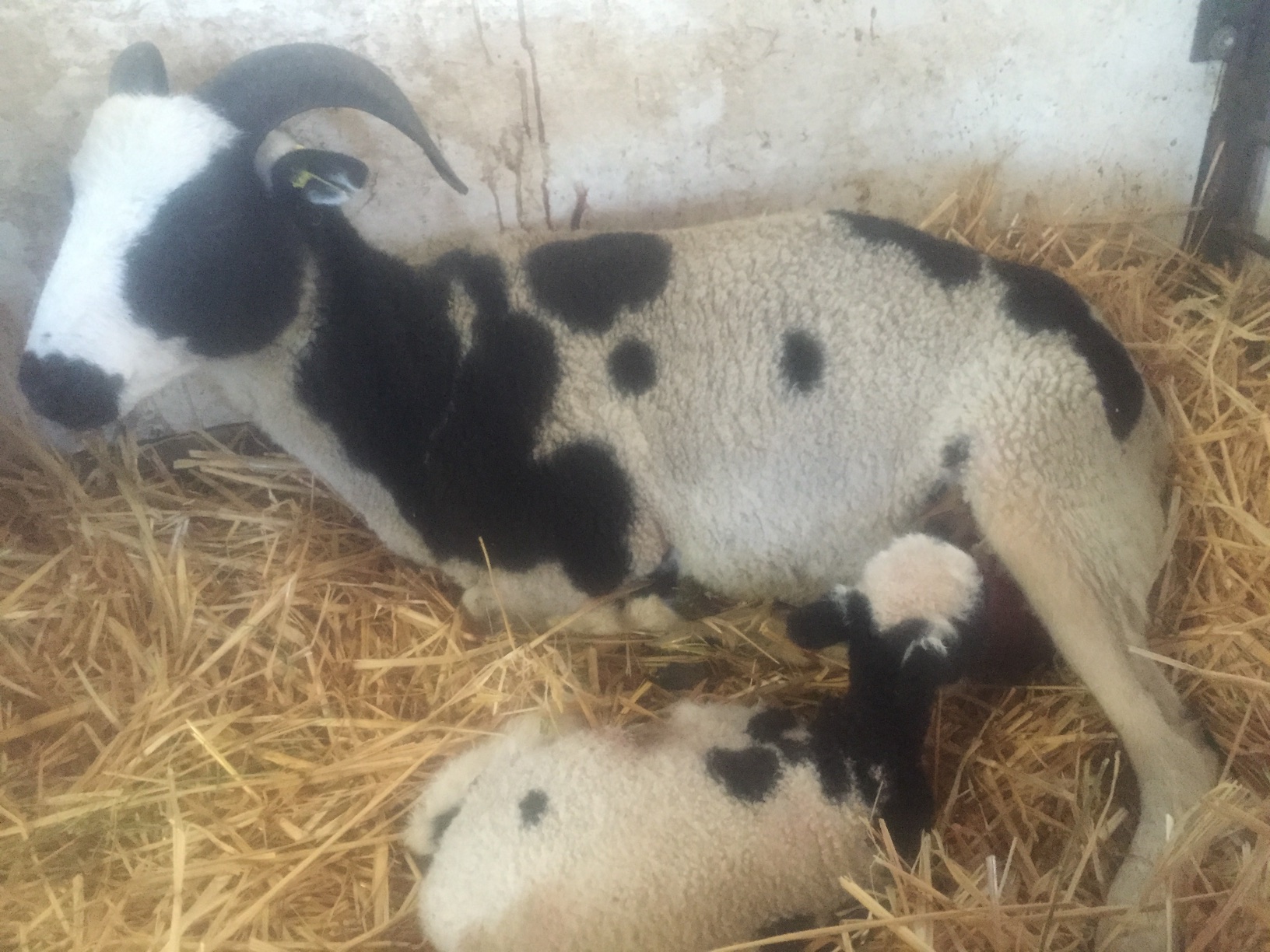 This photo is blurry because I must have smeared my iPhone lens while working with the lamb. When Bea finally lay down while trying to avoid me attaching the lamb to her teat I was able to get the lamb to nurse on the engorged udder. For a day or two I needed to halter her or just stand there.
This photo is blurry because I must have smeared my iPhone lens while working with the lamb. When Bea finally lay down while trying to avoid me attaching the lamb to her teat I was able to get the lamb to nurse on the engorged udder. For a day or two I needed to halter her or just stand there.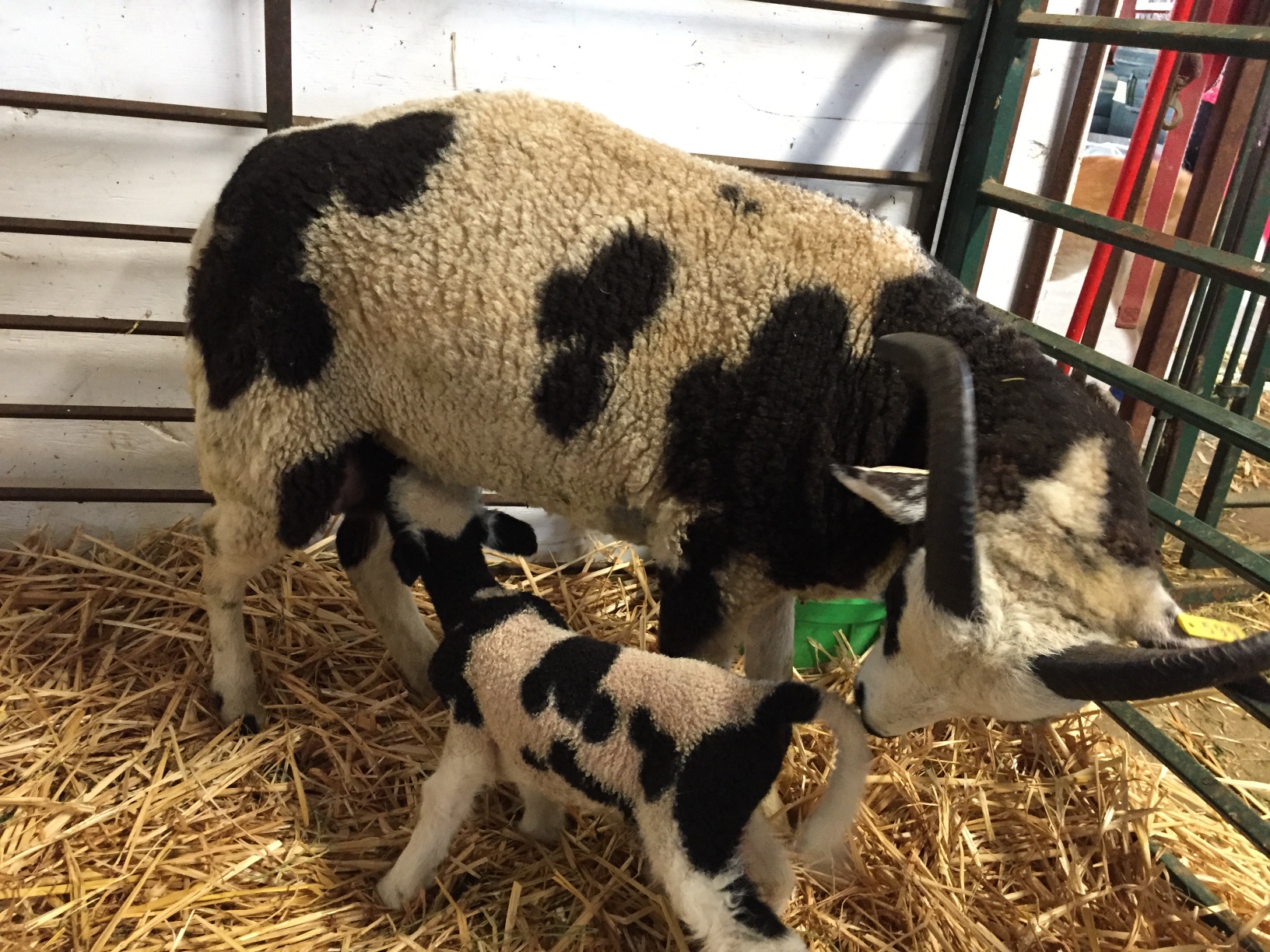 At this point Bea has completely claimed the lamb as her own. (The dead lamb's skin is gone in this photo--I took it off the next morning.)
At this point Bea has completely claimed the lamb as her own. (The dead lamb's skin is gone in this photo--I took it off the next morning.)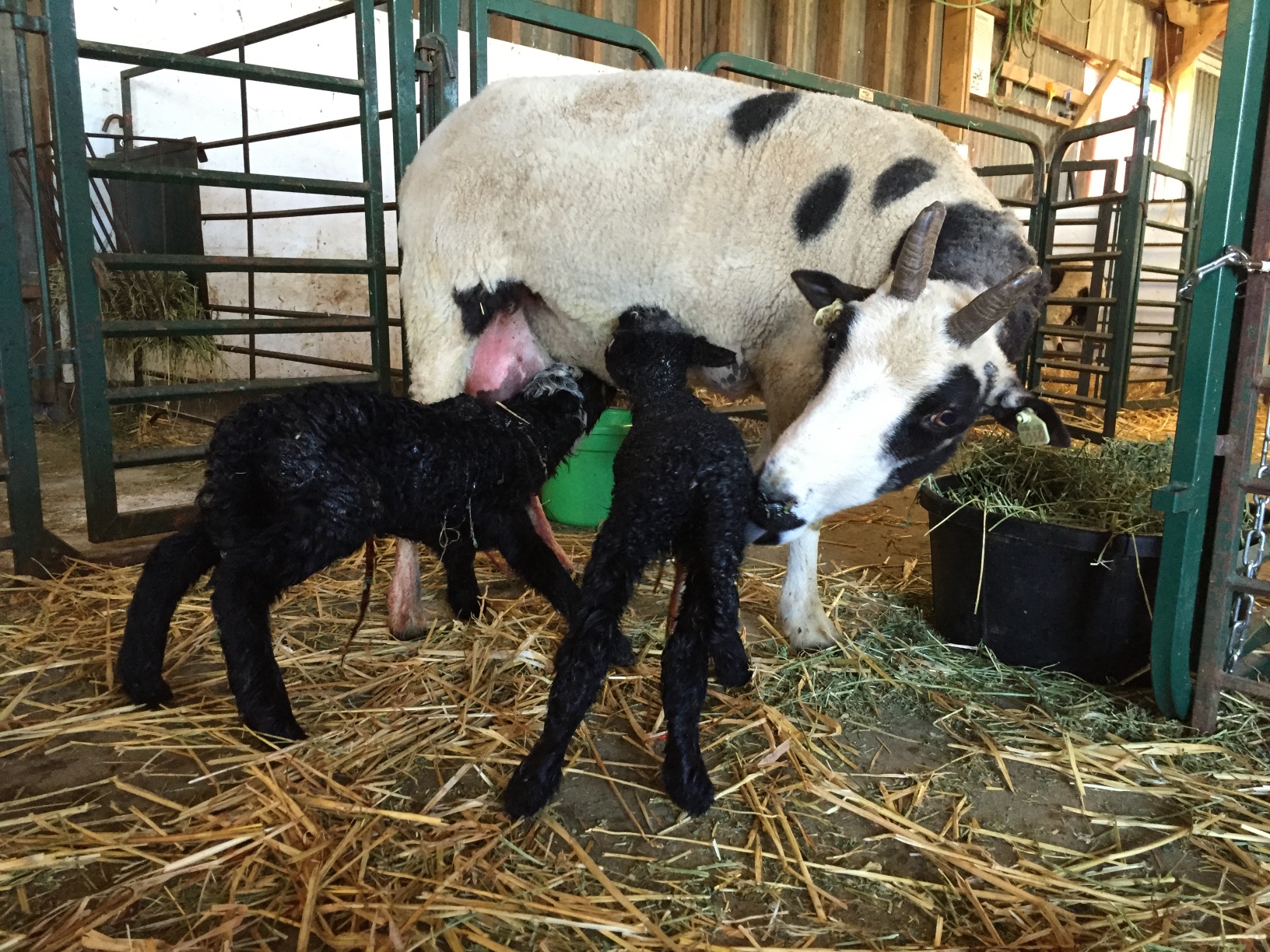 We were impatiently waiting for Jazz to lamb. I was sure that she would have triplets because she was so huge. She surprised me with twins the day after Farm Day. They are 9.6 and 12 pounds. At that size it's good there were only two of them.
We were impatiently waiting for Jazz to lamb. I was sure that she would have triplets because she was so huge. She surprised me with twins the day after Farm Day. They are 9.6 and 12 pounds. At that size it's good there were only two of them.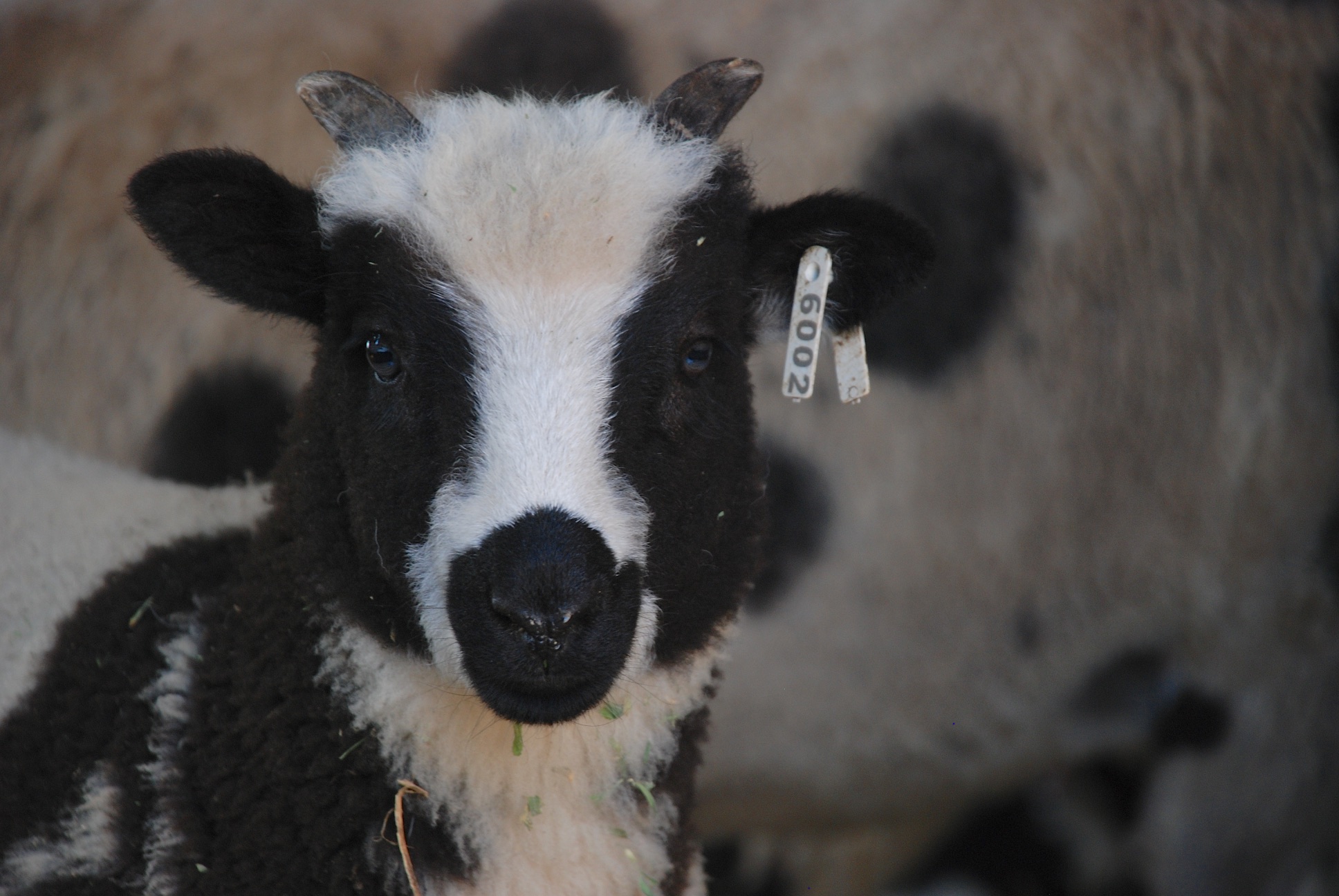


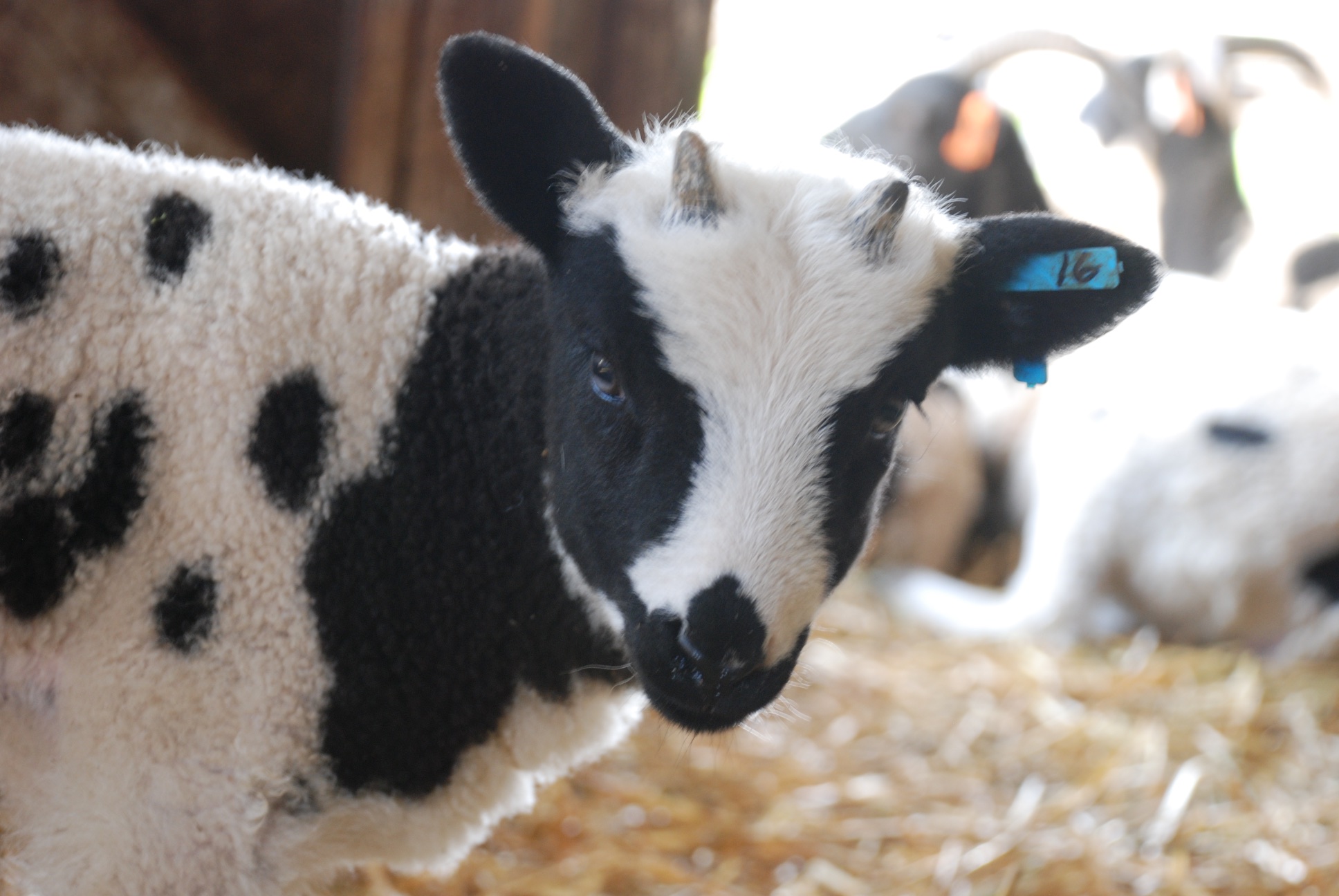
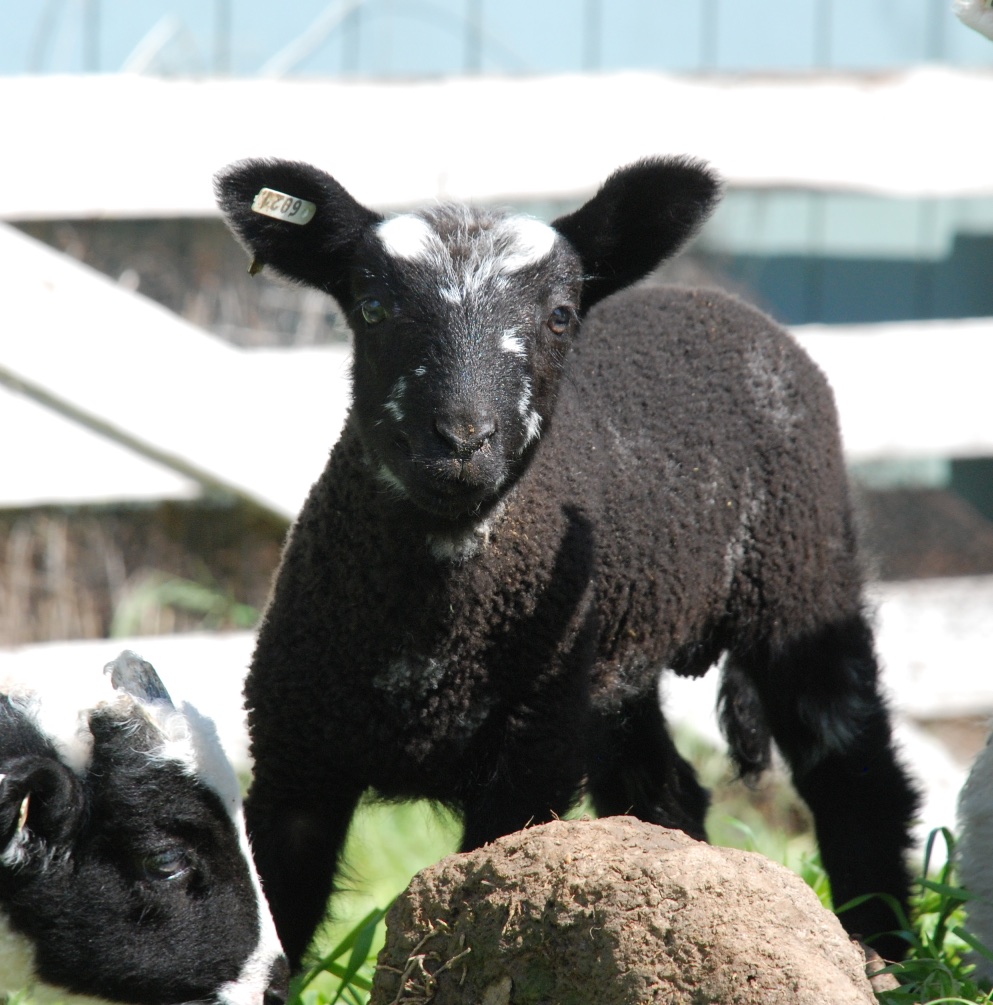
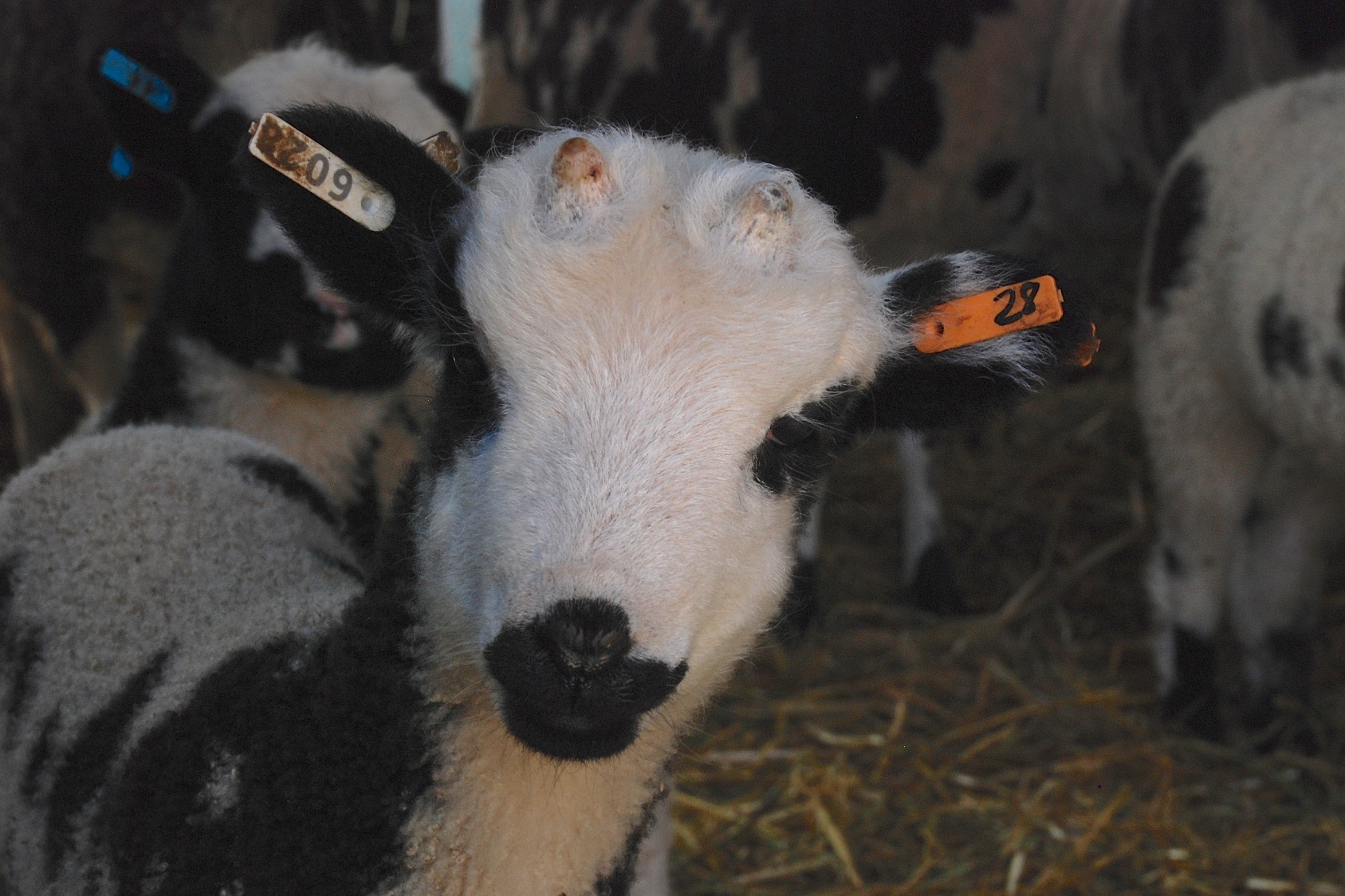

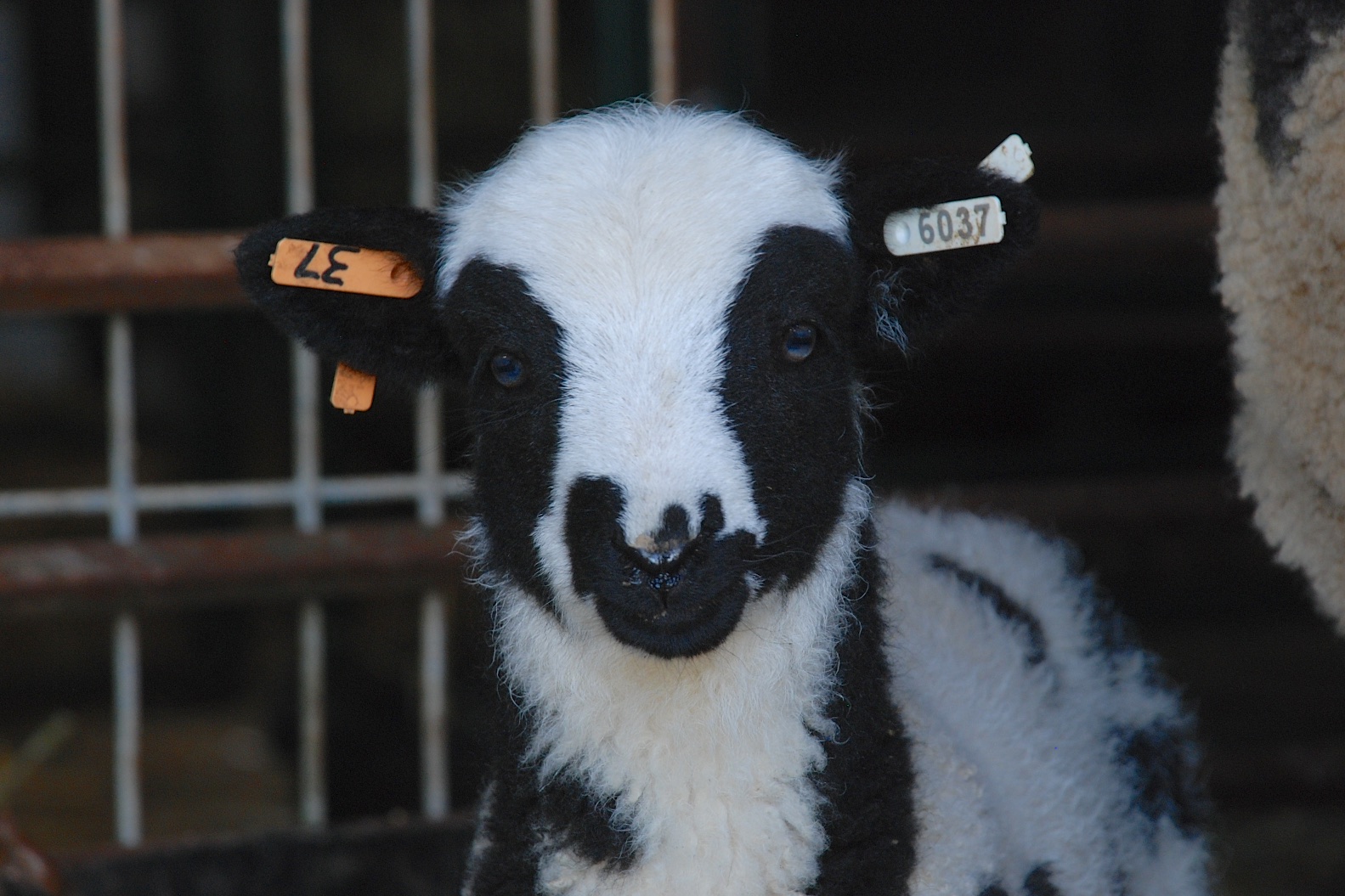
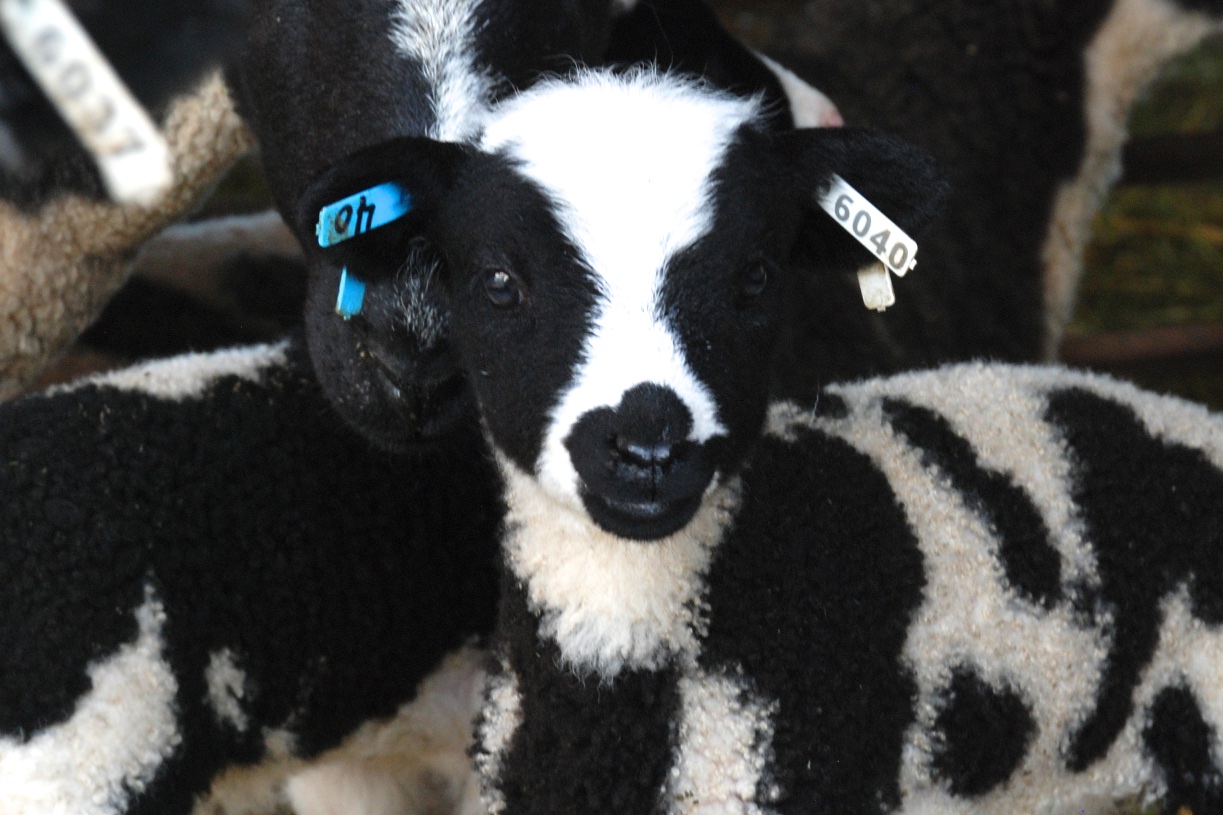
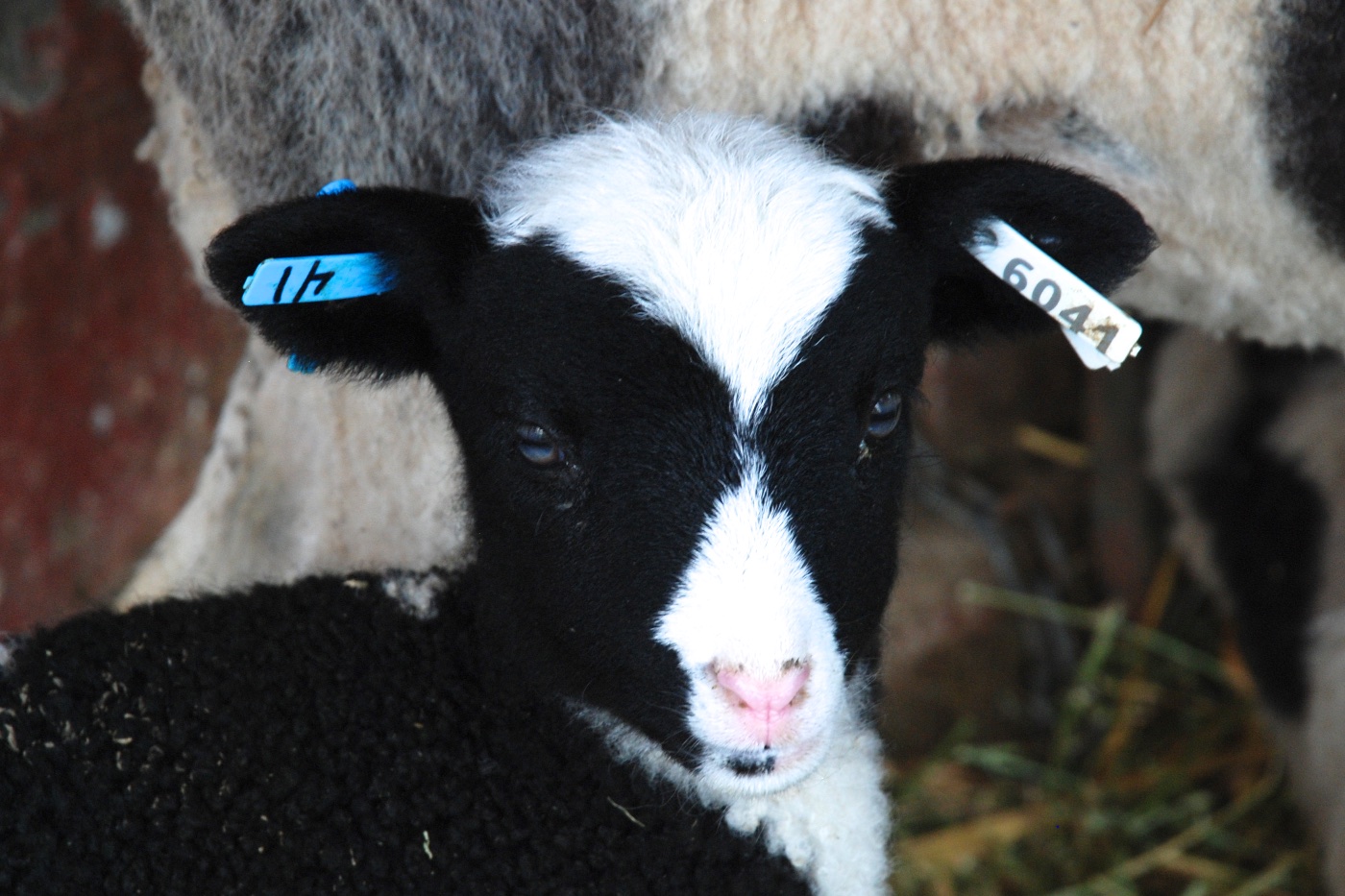
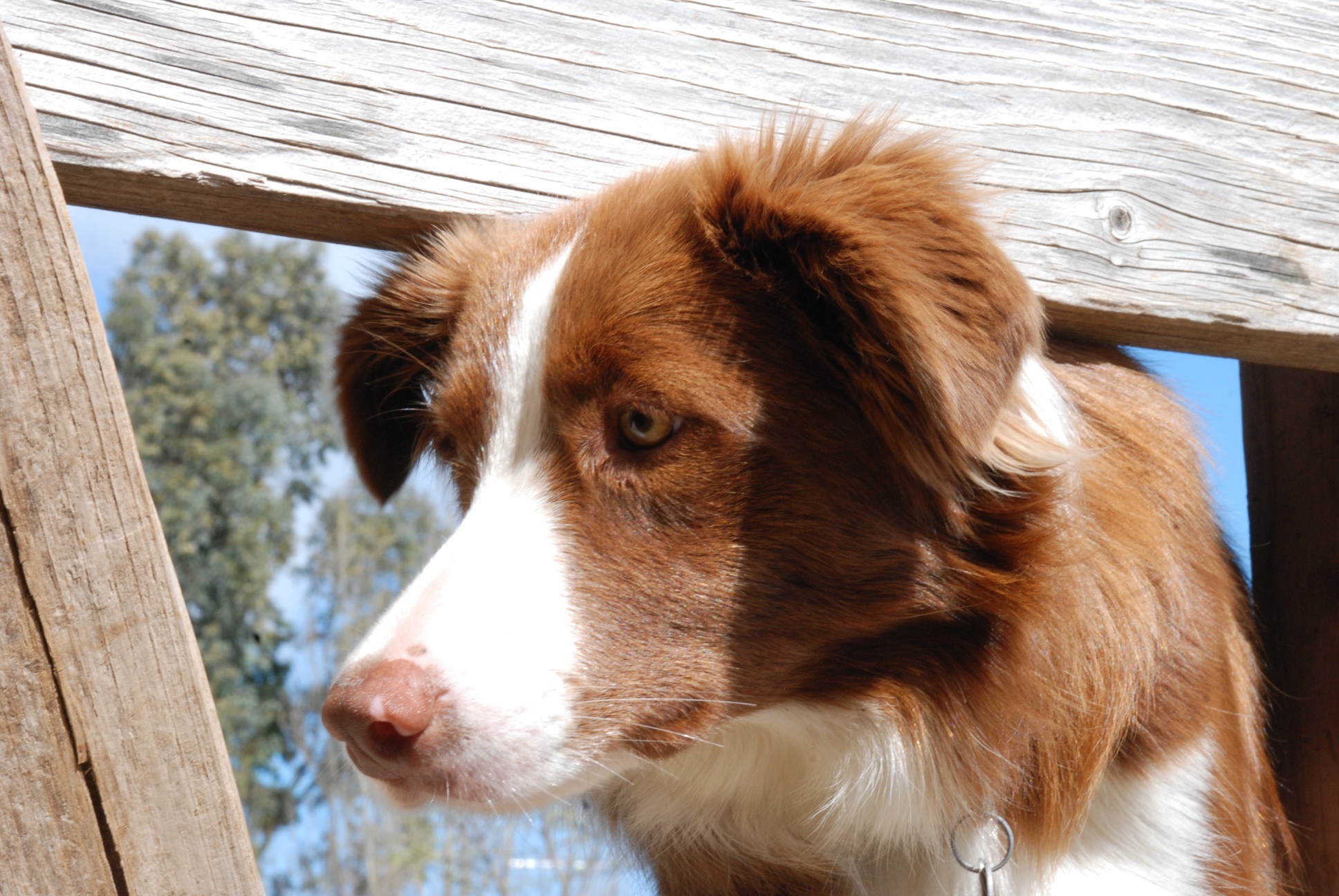
 Lilac twin ewes: Meridian Nash x Mud Ranch's Foxglove.
Lilac twin ewes: Meridian Nash x Mud Ranch's Foxglove. Esmerelda's twins, 75% Jacob/25% BFL.
Esmerelda's twins, 75% Jacob/25% BFL.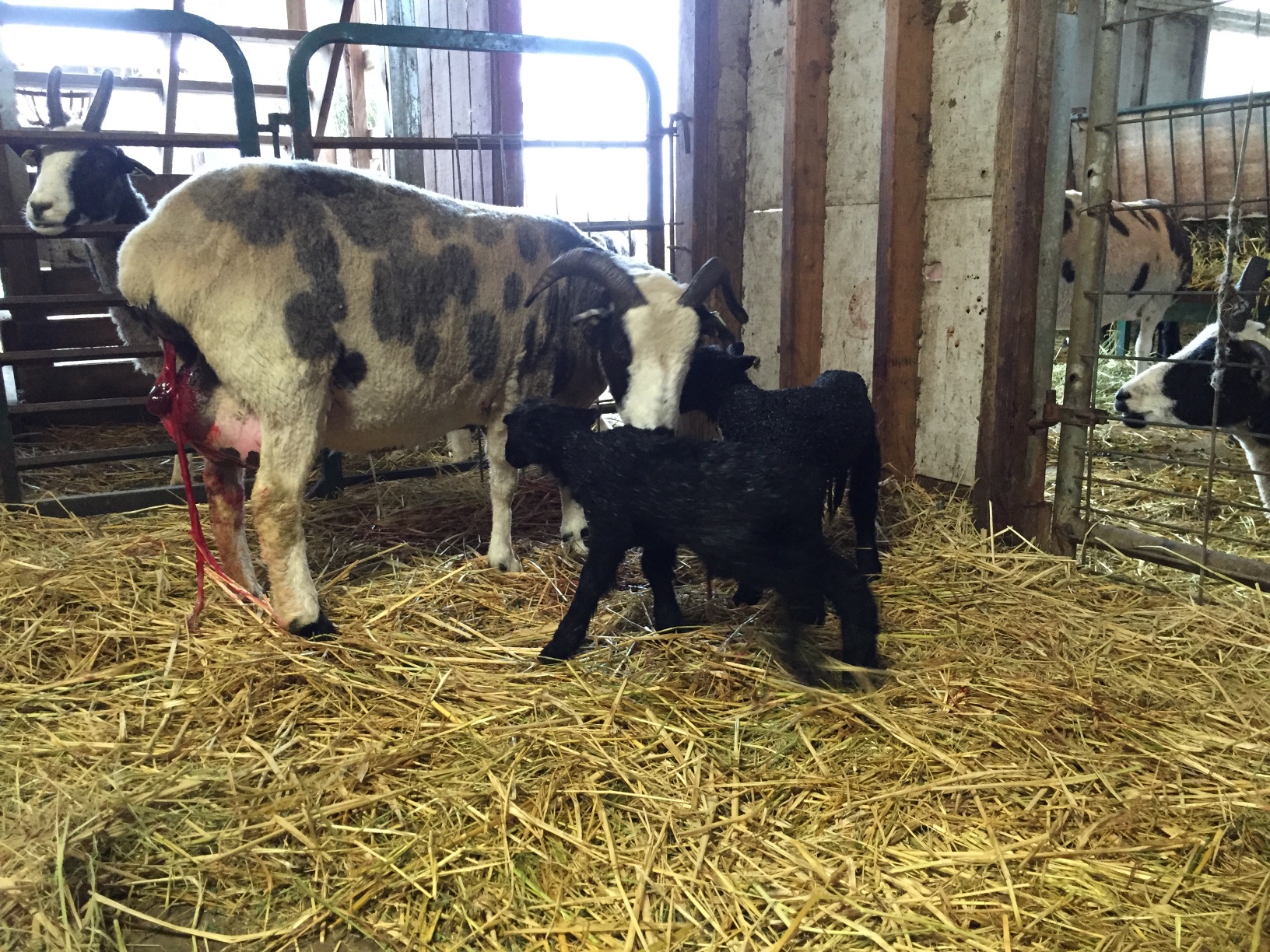 Fandango's BFL/Jacob twins.
Fandango's BFL/Jacob twins.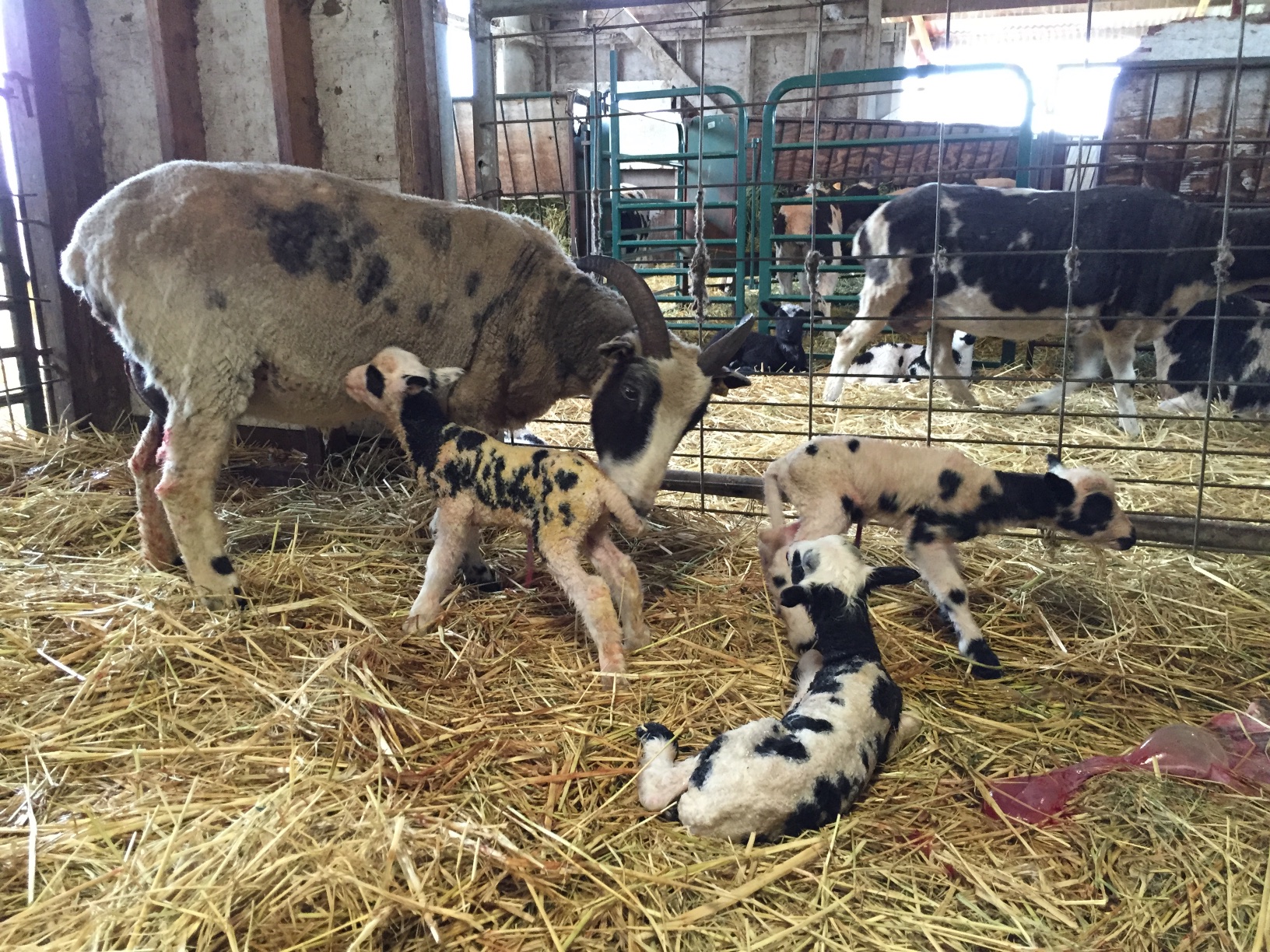 This morning's lilac triplet rams: Meridian Nash x Meridian Celeste. These bring the count to 55.
And look who came to the barn with me this morning...
This morning's lilac triplet rams: Meridian Nash x Meridian Celeste. These bring the count to 55.
And look who came to the barn with me this morning... ...in her camo boots and pj's.
...in her camo boots and pj's.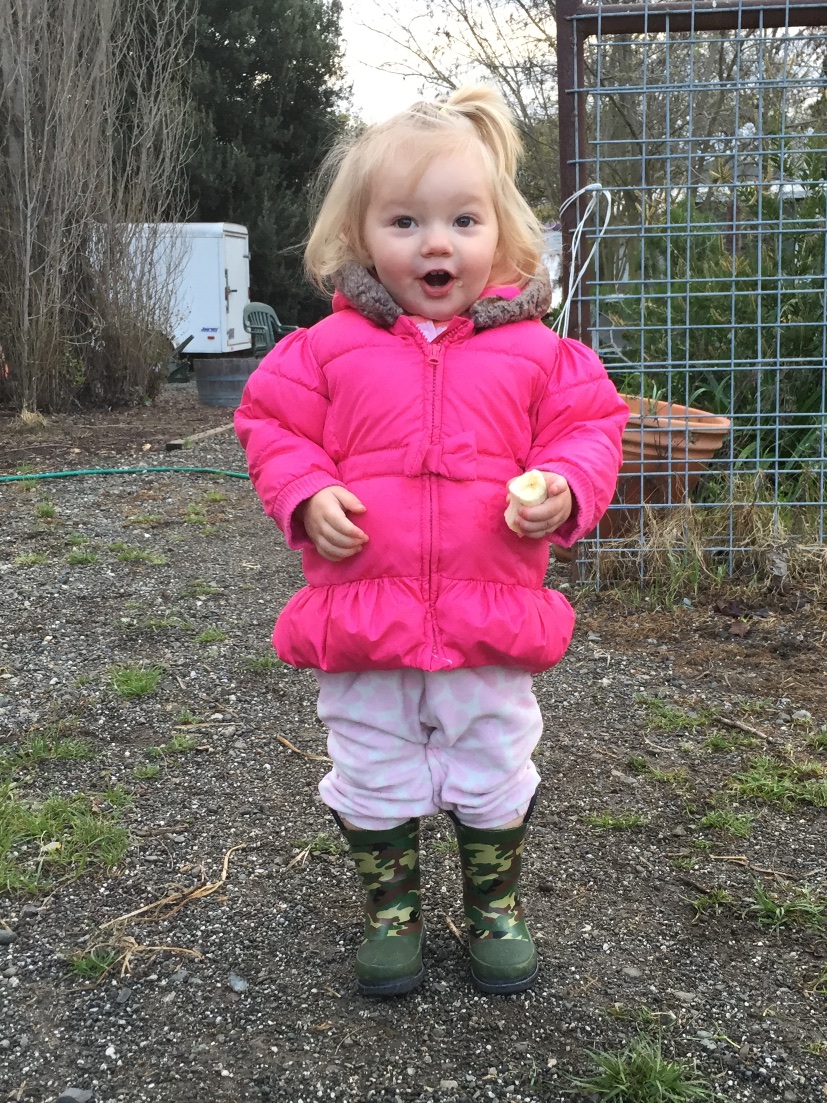 Kirby will be helping me in the barn for the next couple of days.
Kirby will be helping me in the barn for the next couple of days. This was a class about weaving with rayon chenille, a yarn with a reputation of being difficult to work with. I set up 4 warping frames on temporary structures and the fifth person used the one I have mounted on the wall.
This was a class about weaving with rayon chenille, a yarn with a reputation of being difficult to work with. I set up 4 warping frames on temporary structures and the fifth person used the one I have mounted on the wall. After the looms were warped and ready to go I was surprised that it wasn't all that crowded with five looms. Each person chose a different combination of colors for their scarves:
After the looms were warped and ready to go I was surprised that it wasn't all that crowded with five looms. Each person chose a different combination of colors for their scarves:



 We did take a barn break or two. One lamb was born during class and two more right afterward.
We did take a barn break or two. One lamb was born during class and two more right afterward. Everyone finished weaving in the class time (although fringes will be finished at home) and all were pleased with their scarves.
Everyone finished weaving in the class time (although fringes will be finished at home) and all were pleased with their scarves. Western redbud near the house. I wish it would bloom all spring.
Western redbud near the house. I wish it would bloom all spring. These are Mae's lambs.
These are Mae's lambs.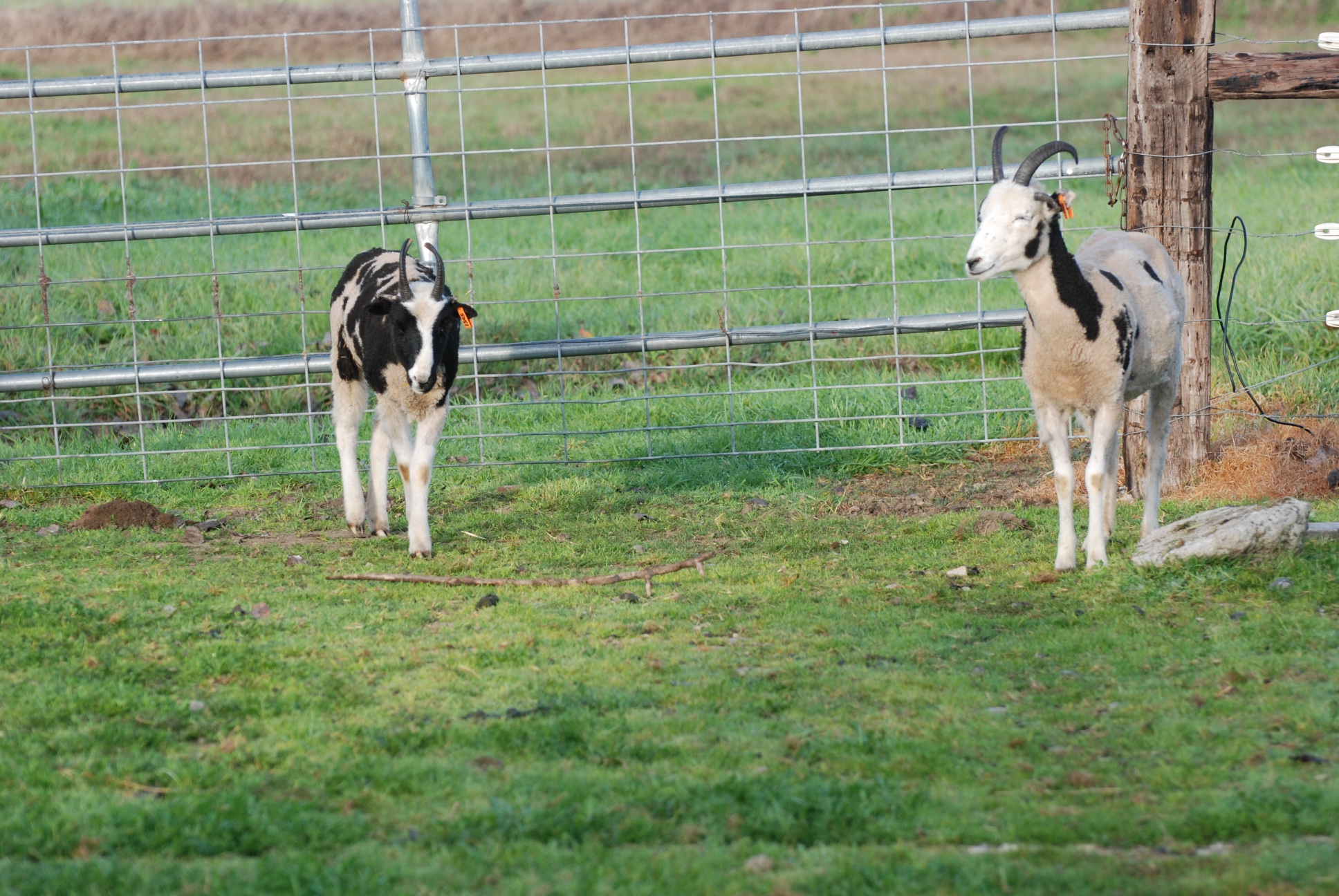 Sisters from last year, Jade and Jillian, waiting to go to the pasture. Jade wasn't bred but Jillian is pregnant.
Sisters from last year, Jade and Jillian, waiting to go to the pasture. Jade wasn't bred but Jillian is pregnant.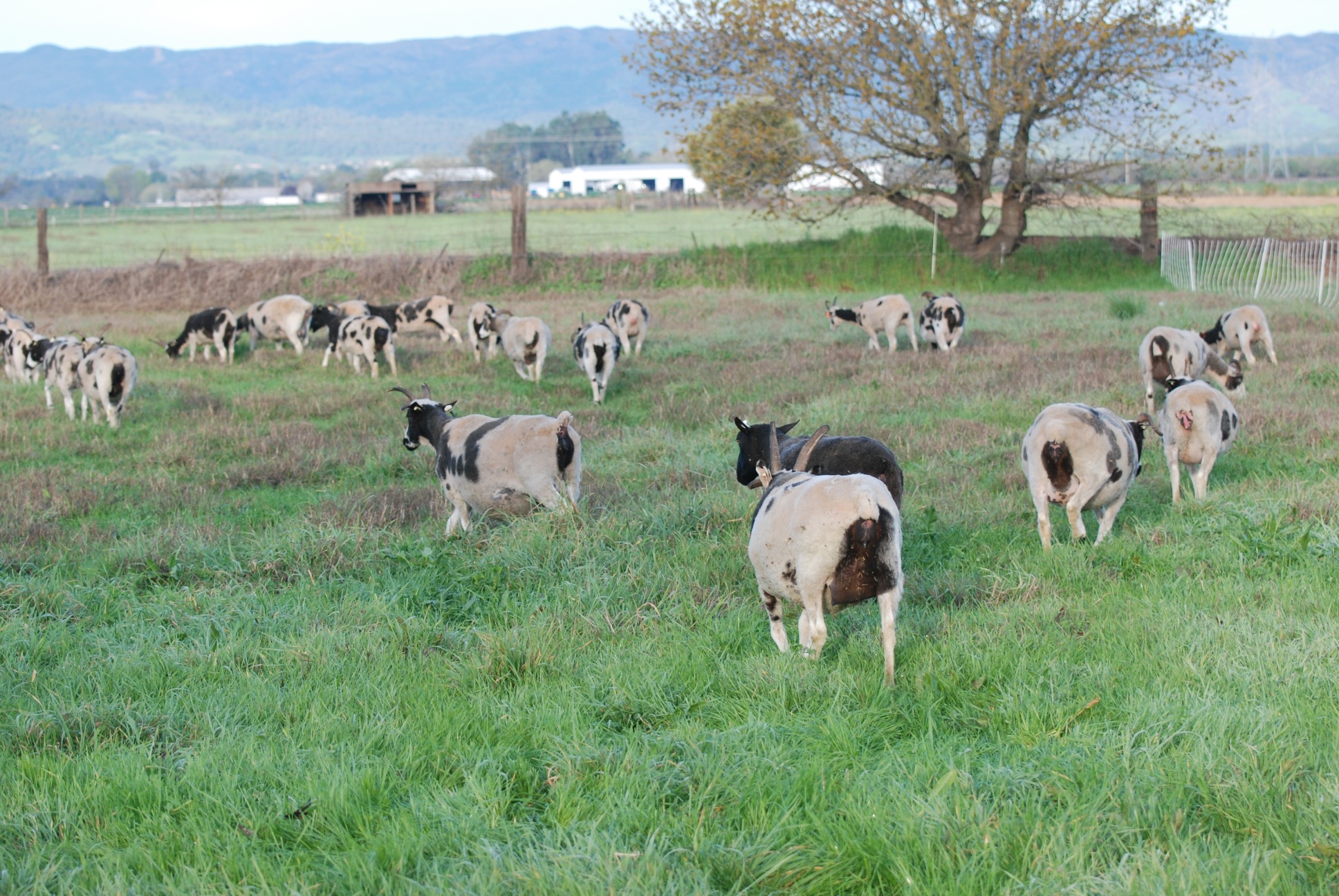 Sending the pregnant ewes out in back.
These are yesterday's lambs:
Sending the pregnant ewes out in back.
These are yesterday's lambs: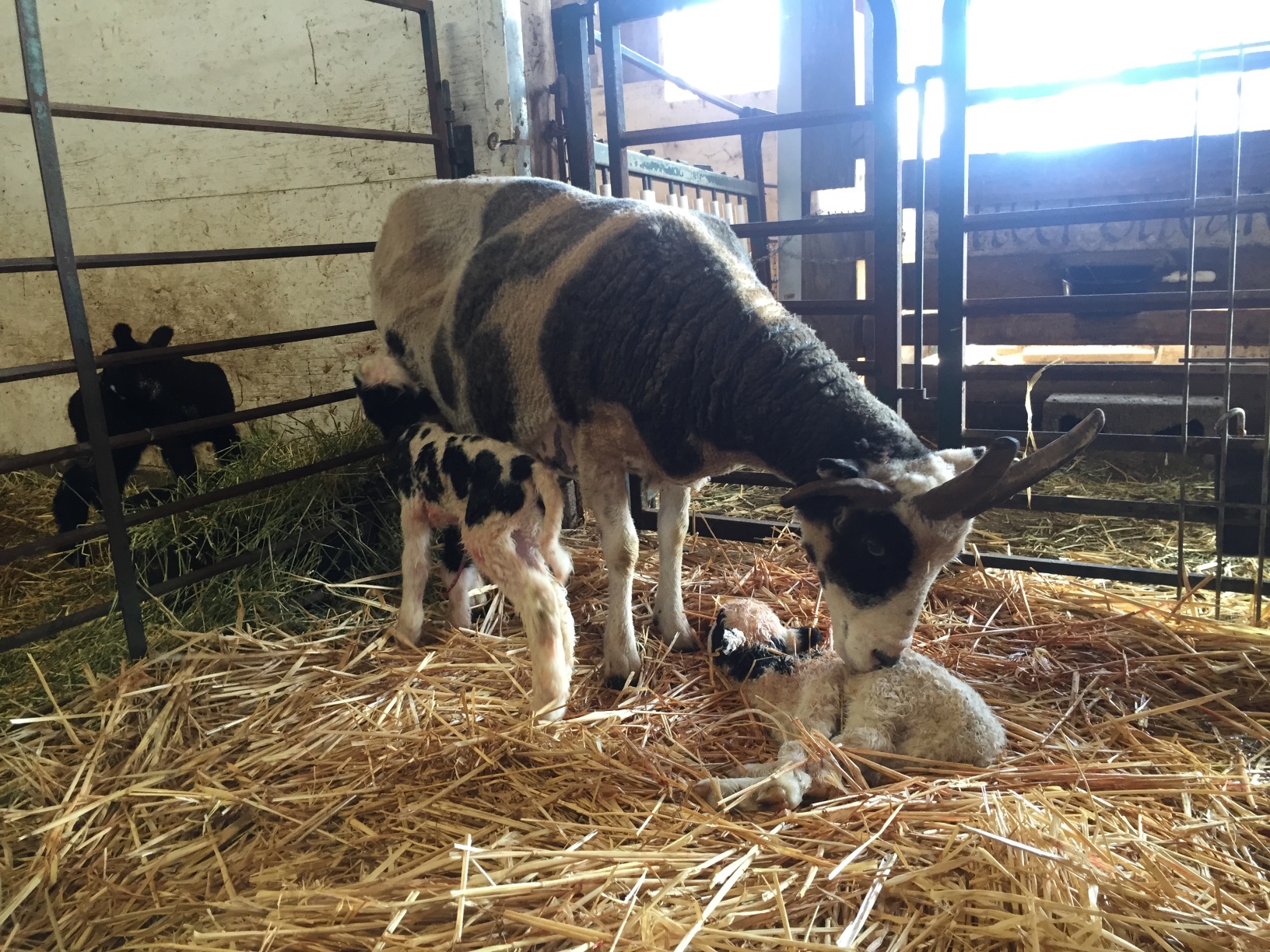 Loretta and a single ram, standing. The one on the ground is the lamb that Raquel rejected a couple of days ago. I successfully "slime grafted" her to Loretta. More about that in a future post.
Loretta and a single ram, standing. The one on the ground is the lamb that Raquel rejected a couple of days ago. I successfully "slime grafted" her to Loretta. More about that in a future post. Later in the day Alexandria lambed with little tiny lambs, both under 5 pounds, but vigorous and healthy.
Later in the day Alexandria lambed with little tiny lambs, both under 5 pounds, but vigorous and healthy. Cascade lambed with a single ram last night. That lamb is to me an average size but weights only one pound more than Alexandria's combined.
Cascade lambed with a single ram last night. That lamb is to me an average size but weights only one pound more than Alexandria's combined. Here is the status so far. Color coding for girl/boy. BT means that the lambs have had BOSE (selenium and Vitamin E supplement) injections and their tails have been banded. Sires are
Here is the status so far. Color coding for girl/boy. BT means that the lambs have had BOSE (selenium and Vitamin E supplement) injections and their tails have been banded. Sires are 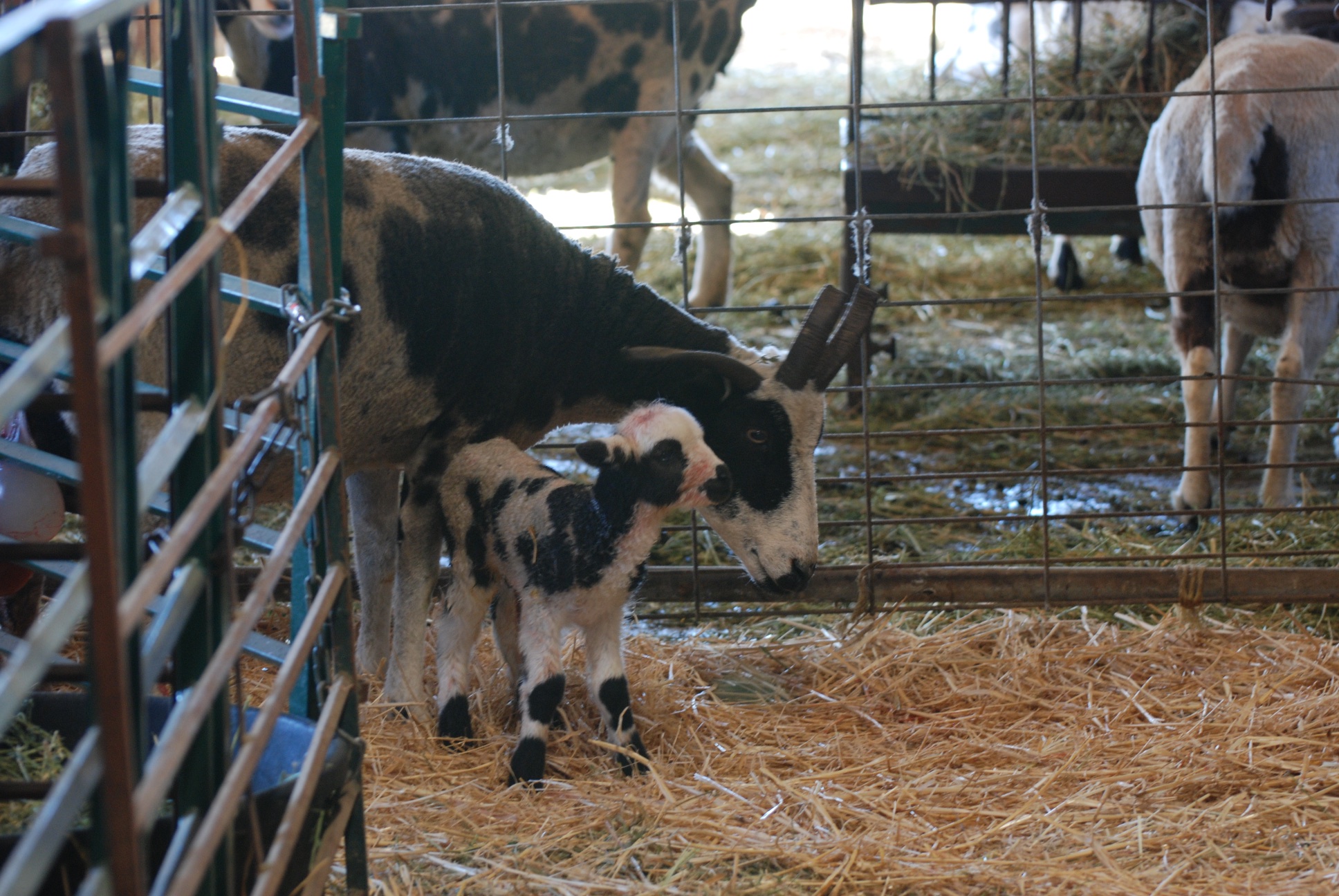 Lana had a very pretty lilac ewe lamb. Eventually, after it seemed things were taking a long time, I checked and found another lamb, pulled it, and spent about twenty minutes trying to make it live. I don't know if it was doomed from the start or aspirated fluid during birth, but it could never get a good enough breath and it died.
Lana had a very pretty lilac ewe lamb. Eventually, after it seemed things were taking a long time, I checked and found another lamb, pulled it, and spent about twenty minutes trying to make it live. I don't know if it was doomed from the start or aspirated fluid during birth, but it could never get a good enough breath and it died.  In the meantime Raquel was in labor. I have been in touch with some students at the UC Davis vet school who are interested in coming out for some hands-on practice. It's been difficult to coordinate their schedules with sheep lambing, but they were able to come out then for a couple of hours. Unfortunately Raquel didn't lamb while they were here but they did do some ear tagging, tail banding...
In the meantime Raquel was in labor. I have been in touch with some students at the UC Davis vet school who are interested in coming out for some hands-on practice. It's been difficult to coordinate their schedules with sheep lambing, but they were able to come out then for a couple of hours. Unfortunately Raquel didn't lamb while they were here but they did do some ear tagging, tail banding...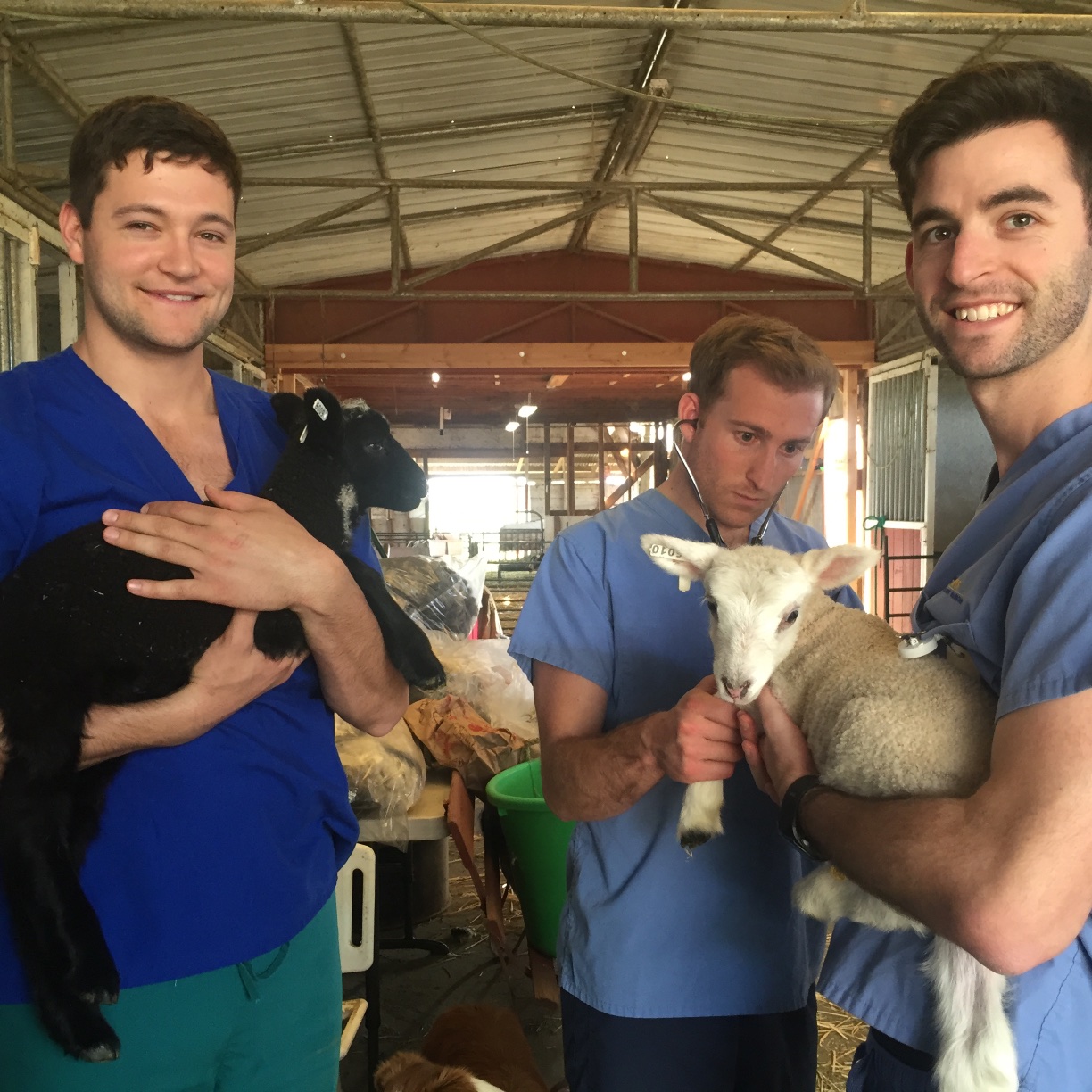 ...and they listened to the normal and the not-as-healthy lungs of these twins, one of whom has been getting penicillin because he almost died from pneumonia following a difficult birth (in
...and they listened to the normal and the not-as-healthy lungs of these twins, one of whom has been getting penicillin because he almost died from pneumonia following a difficult birth (in 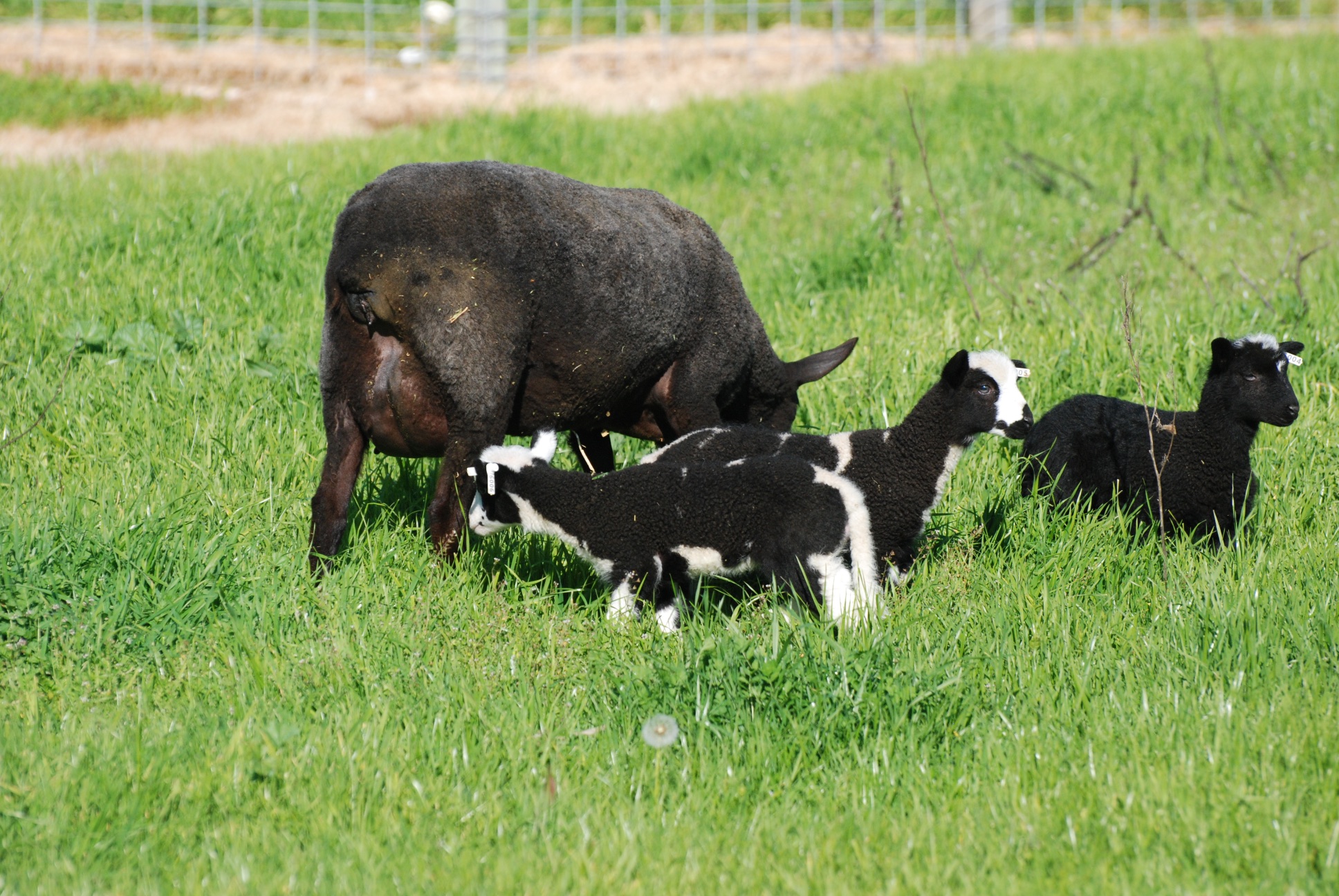 We finally got the ewes with the first lambs out on the pasture. Can you tell where all the mom's food is going now?
We finally got the ewes with the first lambs out on the pasture. Can you tell where all the mom's food is going now?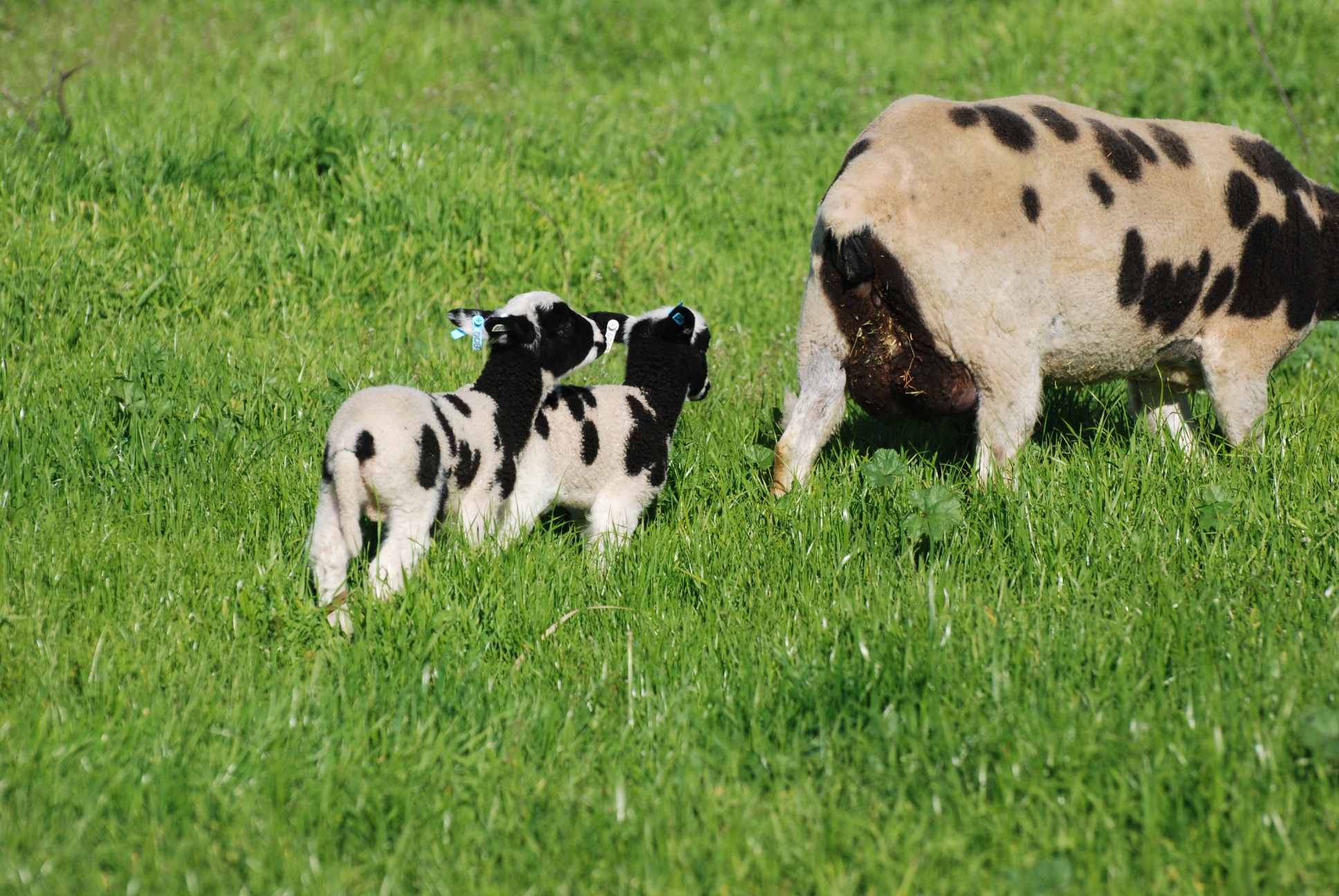 After getting the ewe through the end of pregnancy and then lambing in good health, the next challenge is keeping an eye on the udder health. As the milk is coming in (the lesser amount of colostrum giving way to a greater quantity of milk) the udder may become engorged. If there is tenderness and the ewe doesn't let the lambs nurse on one side it becomes a vicious cycle. Sore udder and teat...no nursing...more milk backing up...udder more full and sore. This can eventually lead to mastitis which, if not treated, can ultimately kill the ewe or at least ruin her udder.
After getting the ewe through the end of pregnancy and then lambing in good health, the next challenge is keeping an eye on the udder health. As the milk is coming in (the lesser amount of colostrum giving way to a greater quantity of milk) the udder may become engorged. If there is tenderness and the ewe doesn't let the lambs nurse on one side it becomes a vicious cycle. Sore udder and teat...no nursing...more milk backing up...udder more full and sore. This can eventually lead to mastitis which, if not treated, can ultimately kill the ewe or at least ruin her udder.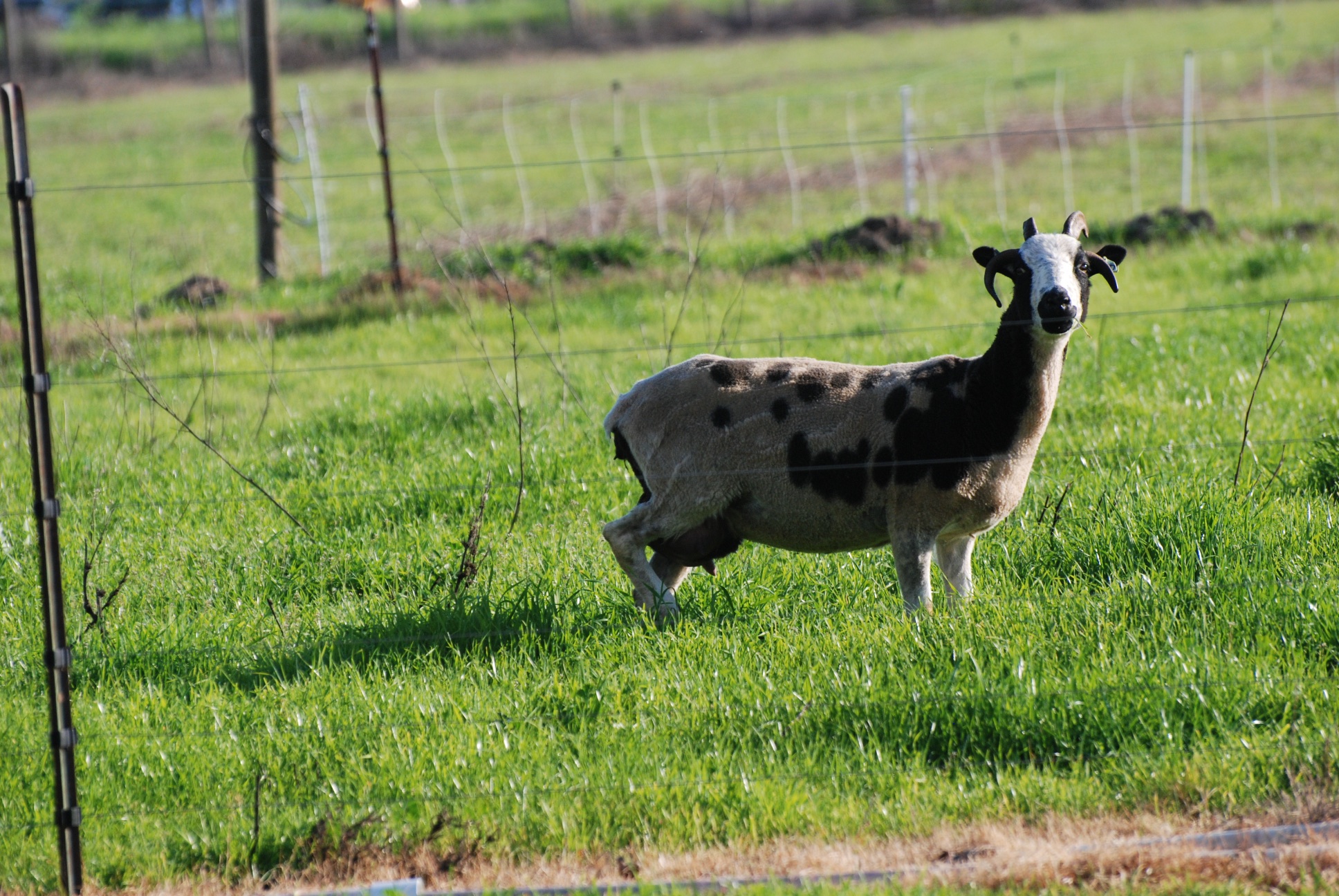 Walking back to the house I noticed Mae standing like this. "Lameness" in a ewe who in nursing lambs may have nothing to do with the feet at all, but be because her udder is full and painful.
Walking back to the house I noticed Mae standing like this. "Lameness" in a ewe who in nursing lambs may have nothing to do with the feet at all, but be because her udder is full and painful.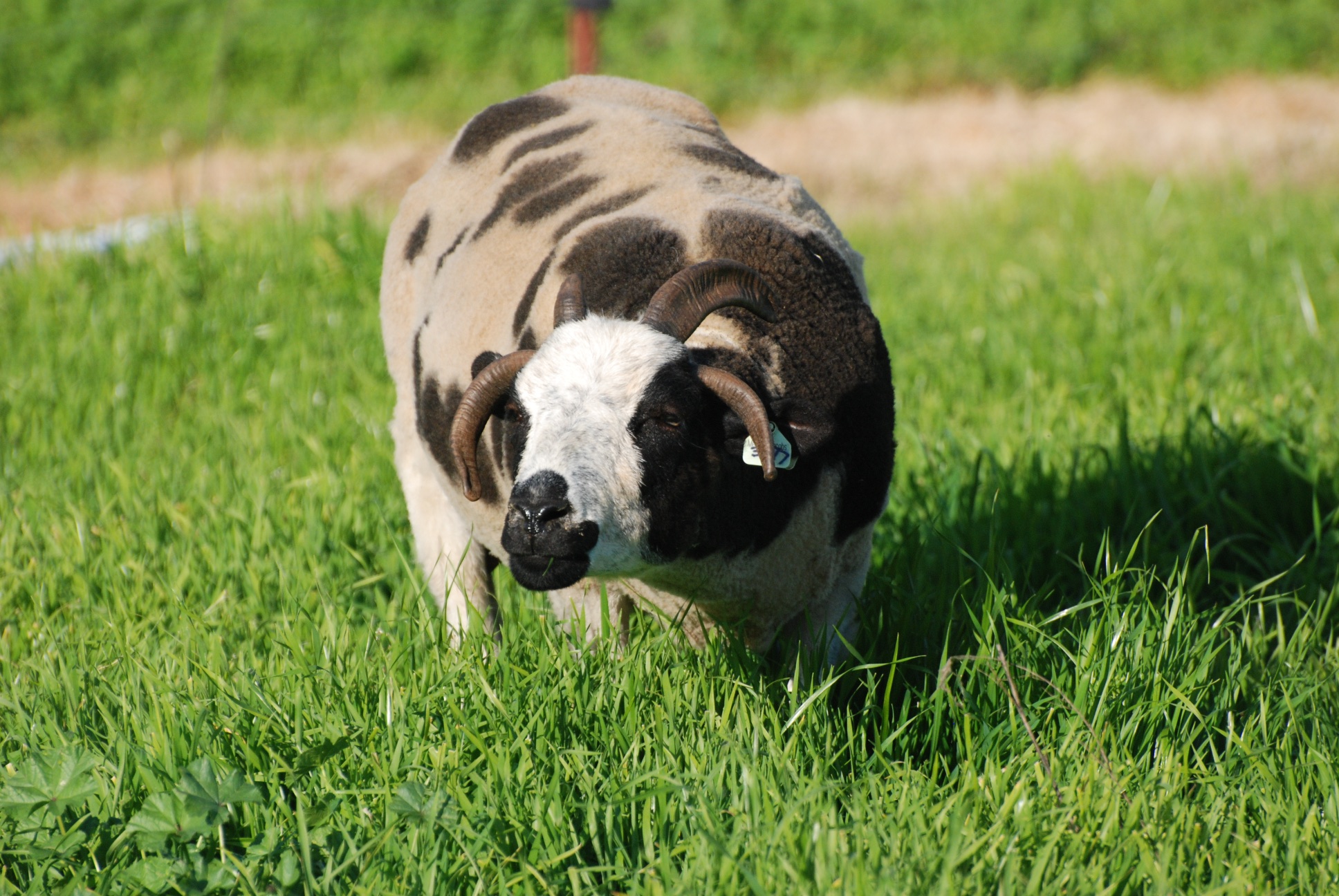 I went out to get her and bring her to the barn. I am amused by her response to me approaching.
I went out to get her and bring her to the barn. I am amused by her response to me approaching. This is why. Her lambs are hidden in the grass.
This is why. Her lambs are hidden in the grass. This is how Mae looked walking back to the barn.
This is how Mae looked walking back to the barn.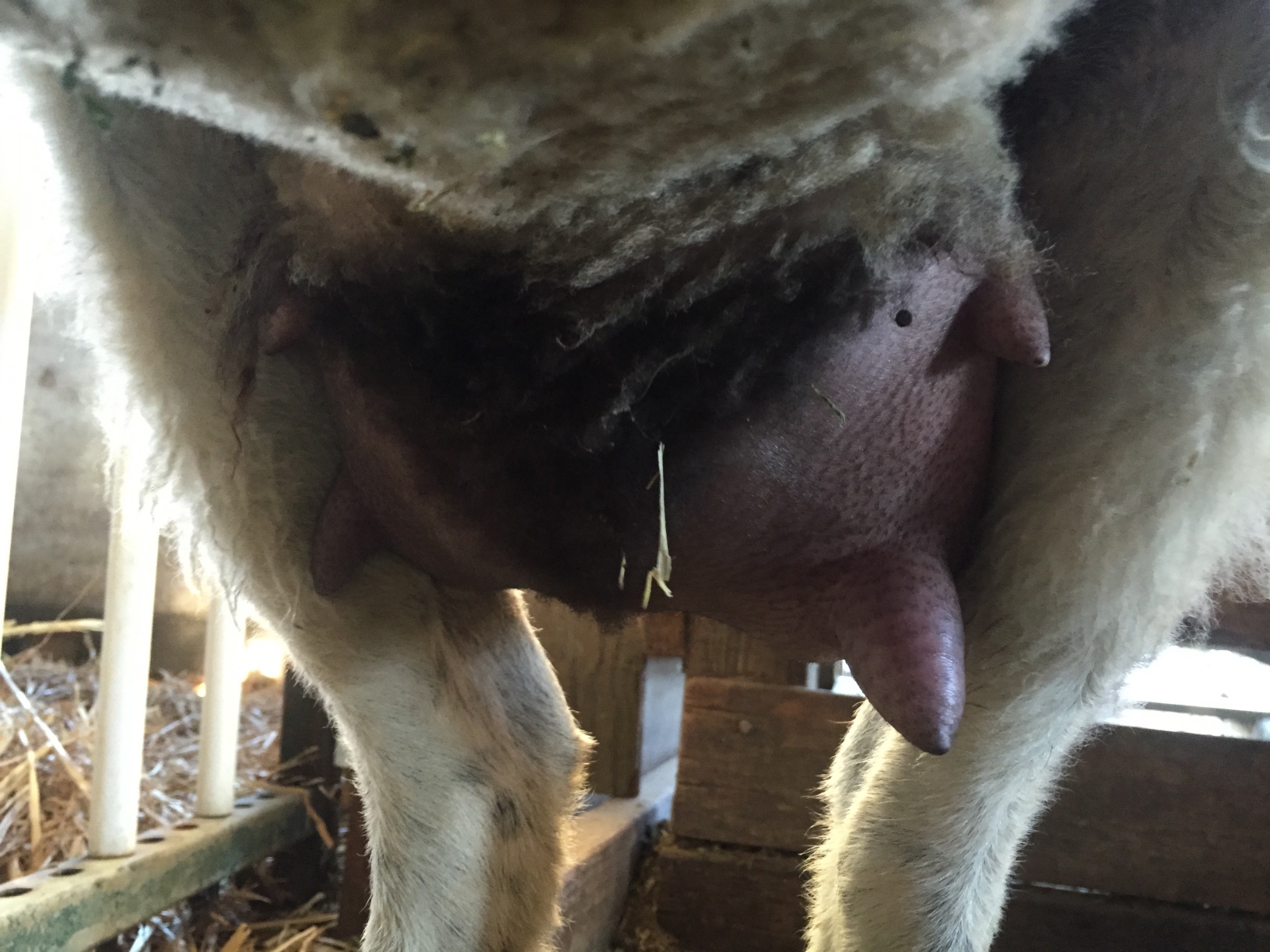 This is from the front. I tied her to the fence and milked the one side, taking 7.5 ounces.
This is from the front. I tied her to the fence and milked the one side, taking 7.5 ounces.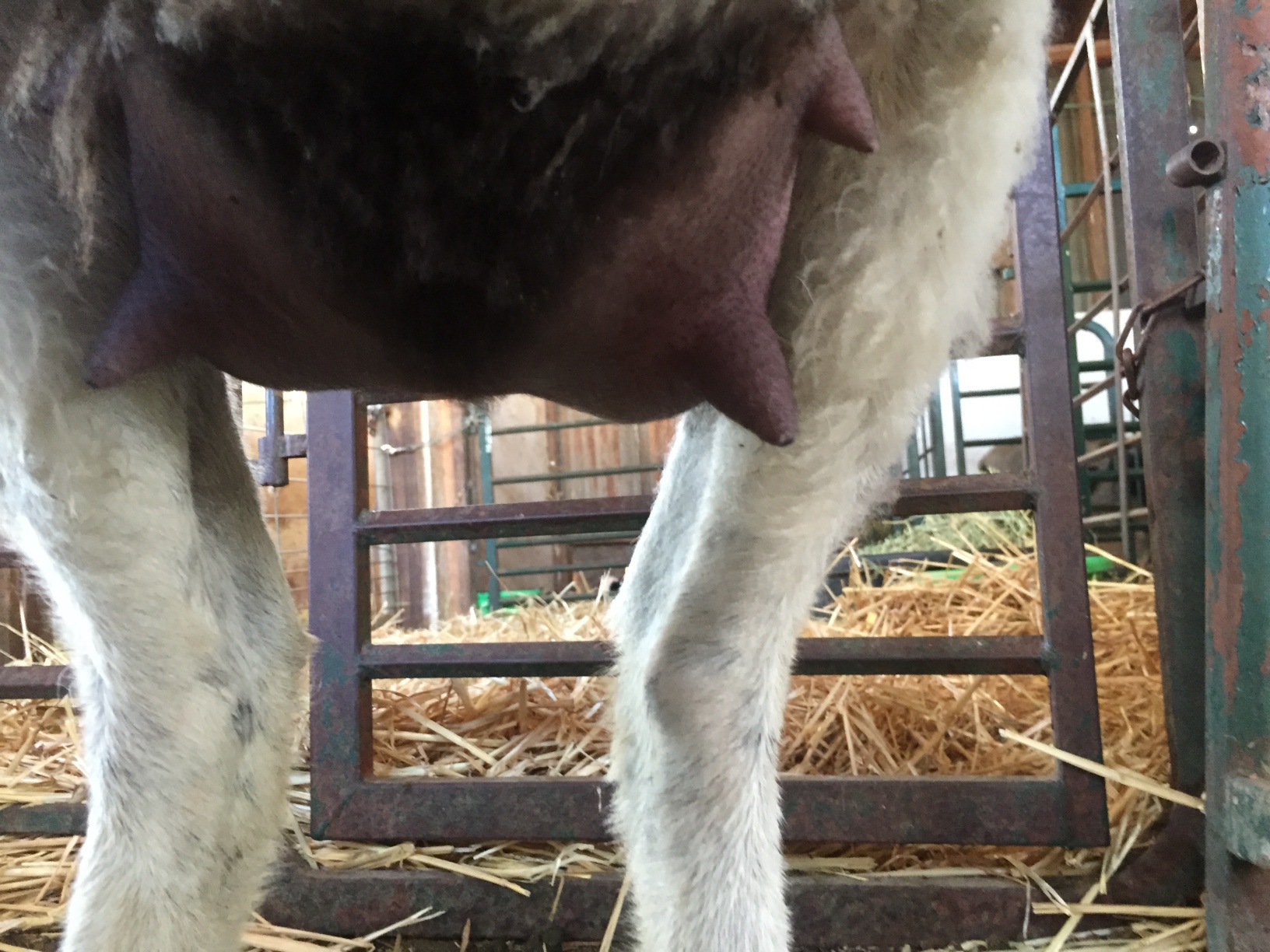 Then it looked and felt balanced. I milked her again this morning. There was another ewe in a similar situation and I had to milk her a couple of times. I have to remember to be watching for that over the next few weeks as these ewes lamb.
Then it looked and felt balanced. I milked her again this morning. There was another ewe in a similar situation and I had to milk her a couple of times. I have to remember to be watching for that over the next few weeks as these ewes lamb.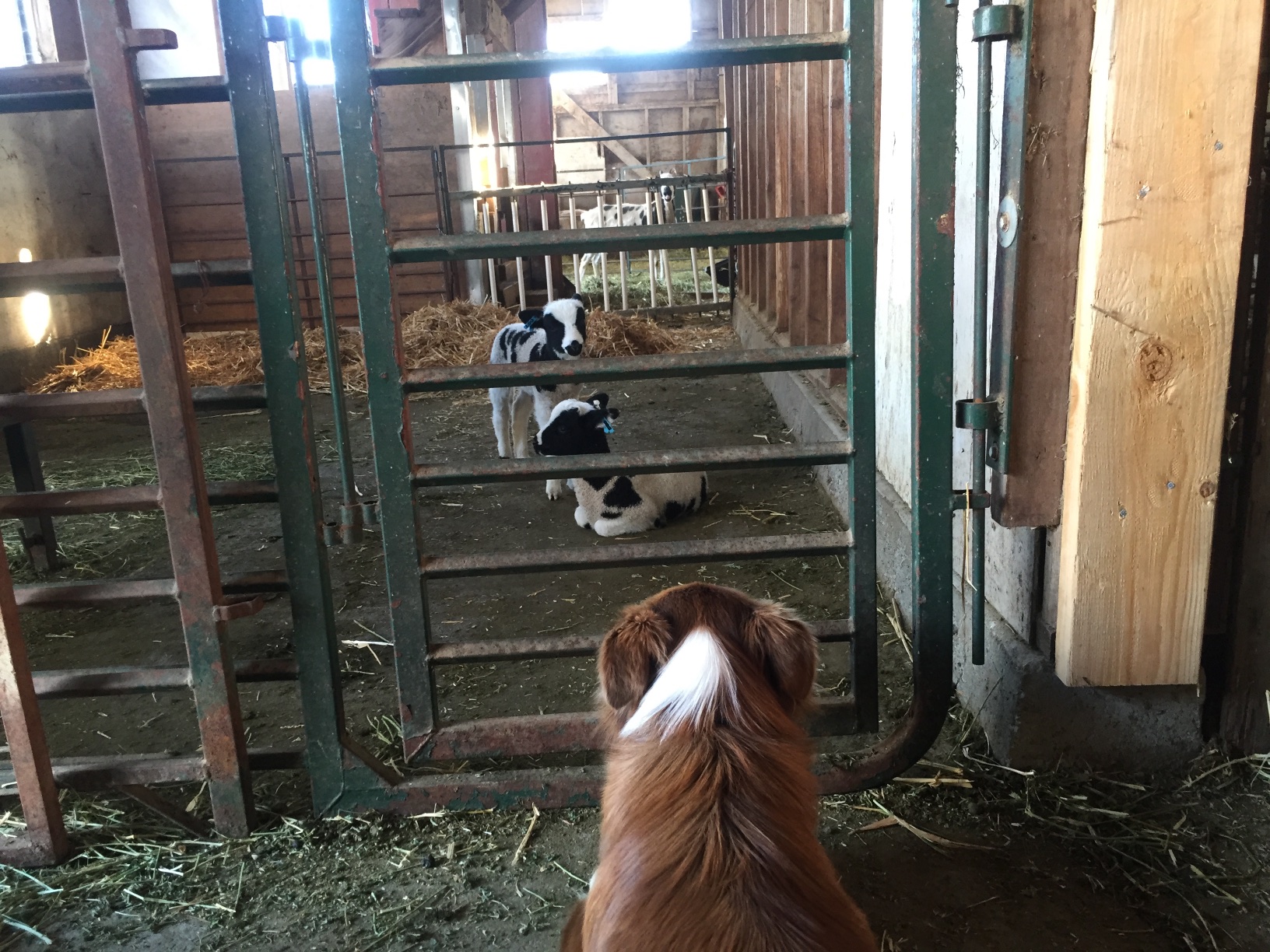 We set up the creep for the lambs. They can get through the narrow slots on that panel. The ewes aren't always happy that their babies can go somewhere that they can't follow.
We set up the creep for the lambs. They can get through the narrow slots on that panel. The ewes aren't always happy that their babies can go somewhere that they can't follow.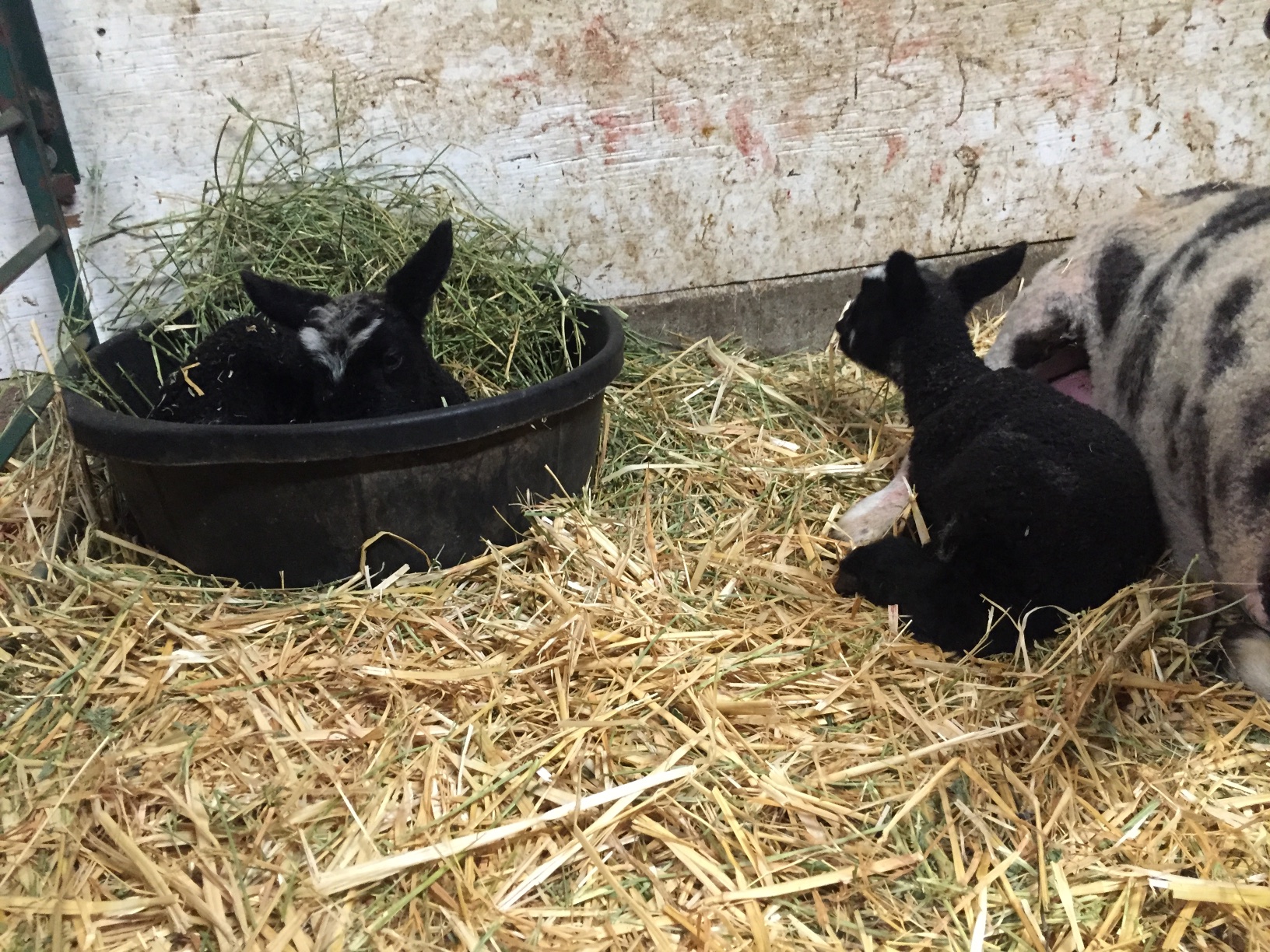 These are BFL-X lambs born the night before.
These are BFL-X lambs born the night before.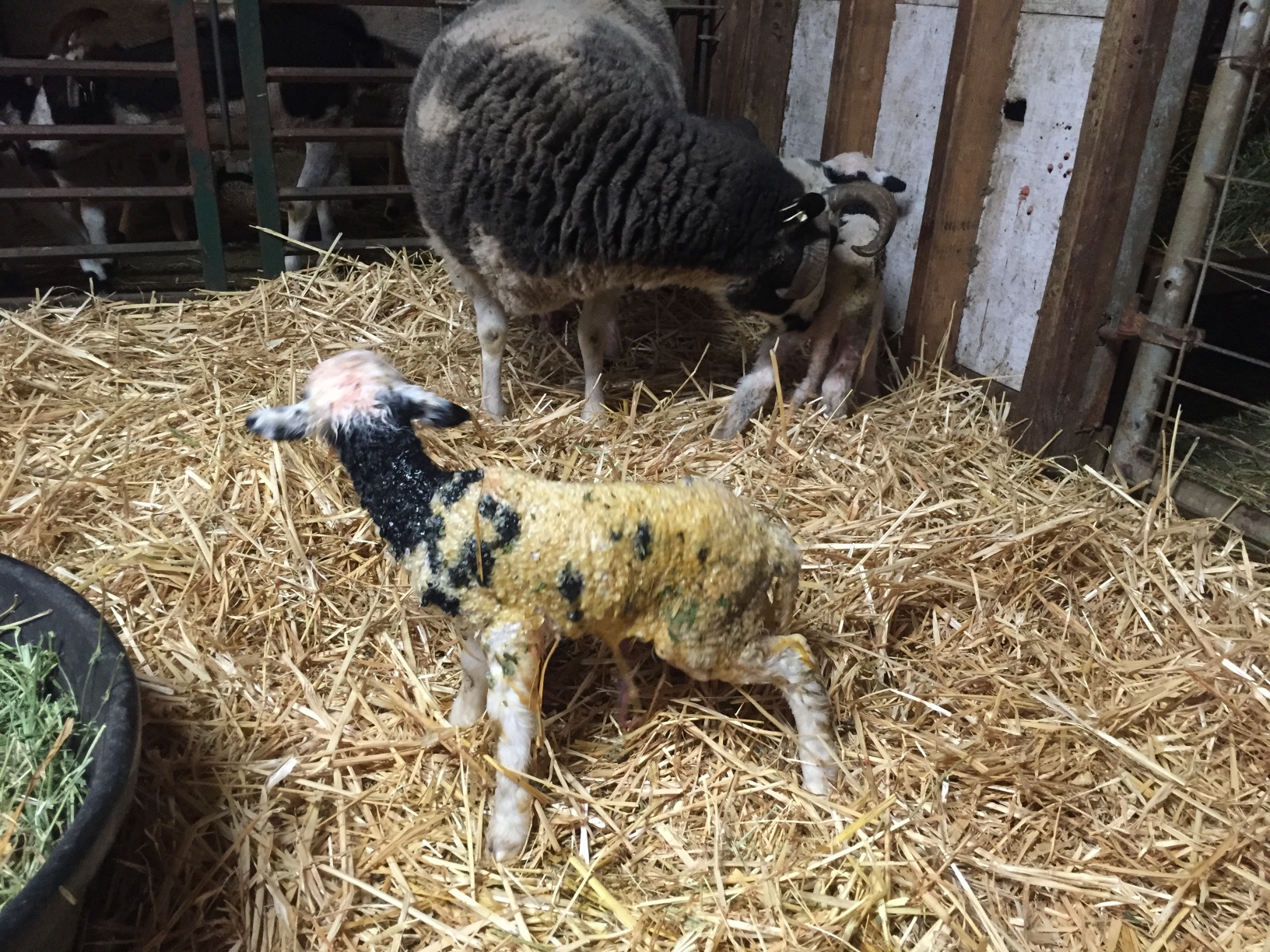 The last lambing of the day was Raquel. After the vet students had left and I had finished working outside I finally went to the house. I went back to the barn to check and these lambs had been born. It wasn't until later at the last check around midnight that I realized that Raquel didn't want one of them. But that is another story.
The last lambing of the day was Raquel. After the vet students had left and I had finished working outside I finally went to the house. I went back to the barn to check and these lambs had been born. It wasn't until later at the last check around midnight that I realized that Raquel didn't want one of them. But that is another story.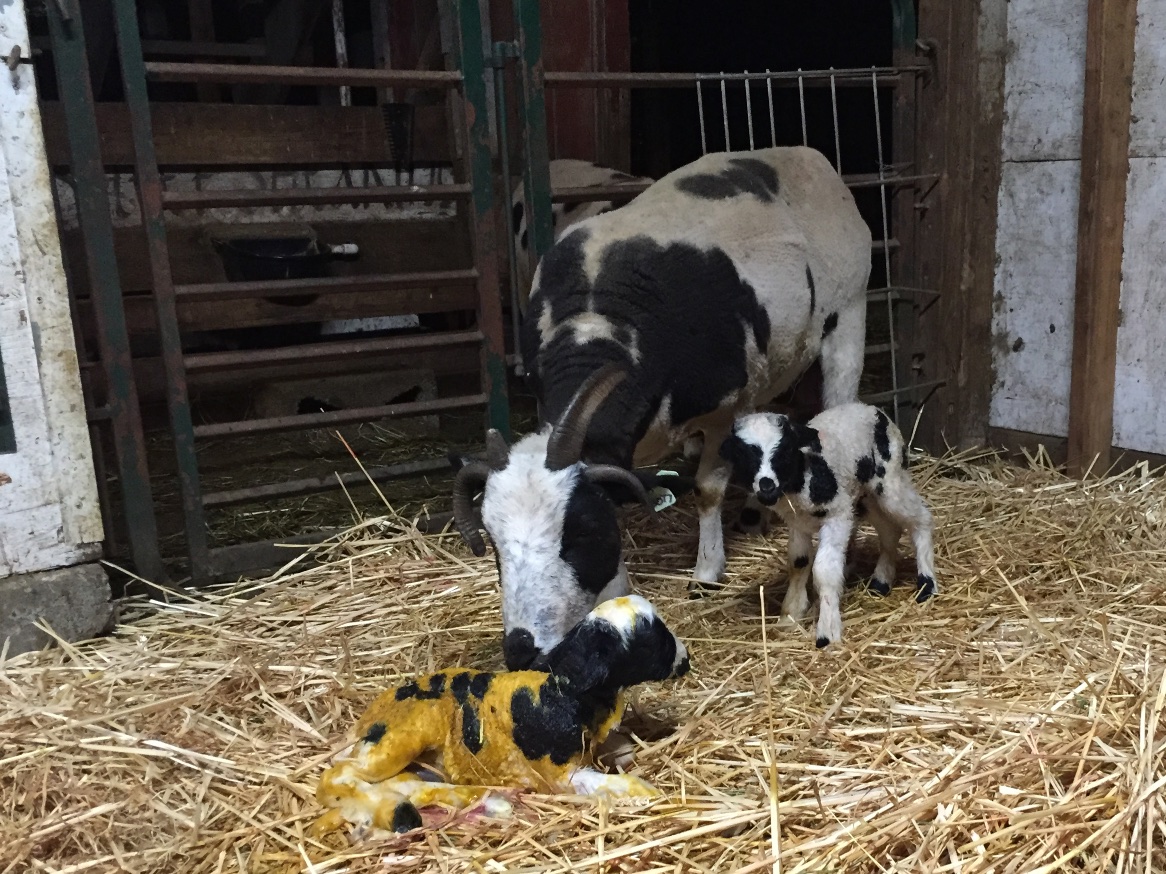 This is Mae, who lambed with twins a little after midnight.
This is Mae, who lambed with twins a little after midnight. It's a long story, but she probably had ketosis (pregnancy toxemia), fortunately in the early stages. After talking to my vet I got more proactive and pulled the lambs.
It's a long story, but she probably had ketosis (pregnancy toxemia), fortunately in the early stages. After talking to my vet I got more proactive and pulled the lambs. That black lamb is 11.4 pounds and his brother is almost 8 pounds. The only other white lamb I've had sired the BFL ram was this same cross--Athena x Faulkner--and there was also one black and one white. After some careful watching and TLC (interspersed with dealing with Maggie) Athena seems to be doing fine.
That black lamb is 11.4 pounds and his brother is almost 8 pounds. The only other white lamb I've had sired the BFL ram was this same cross--Athena x Faulkner--and there was also one black and one white. After some careful watching and TLC (interspersed with dealing with Maggie) Athena seems to be doing fine.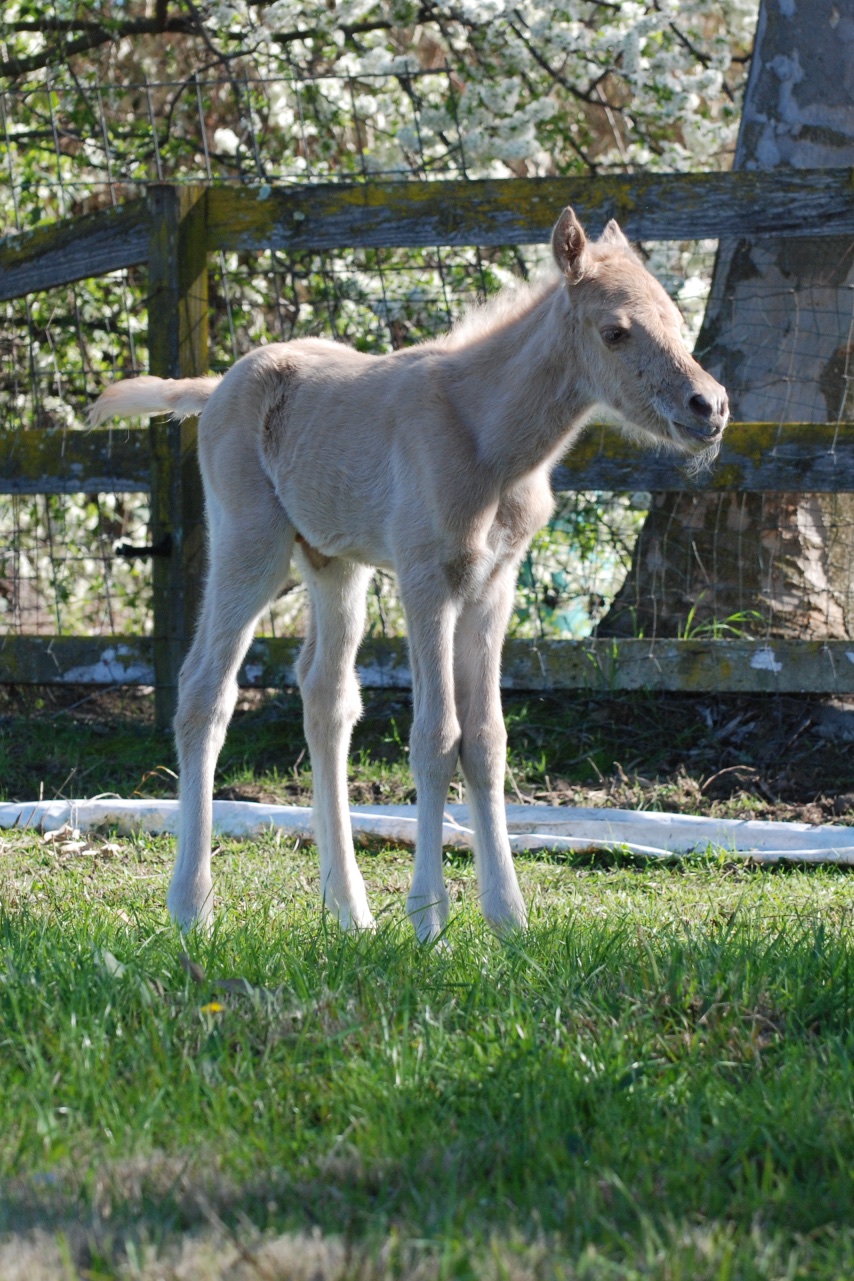 And how about a little more baby horse cuteness? I went down the road to visit this guy again. Here he is about 36 hours old. I got to pet him this time. So soft!
And how about a little more baby horse cuteness? I went down the road to visit this guy again. Here he is about 36 hours old. I got to pet him this time. So soft!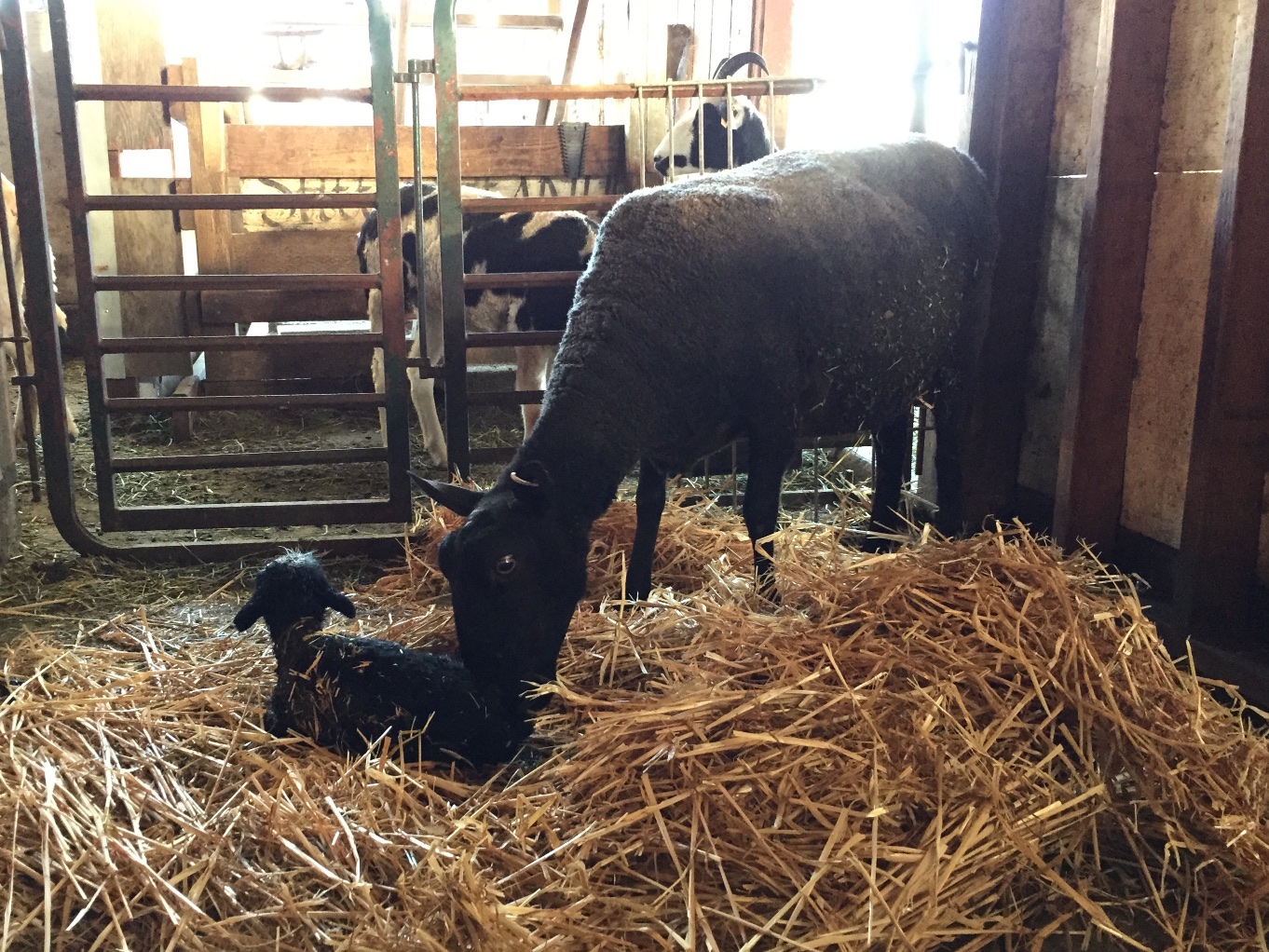 One lamb.
One lamb. Two lambs.
Two lambs. Three lambs. All were up and nursing quickly. Good job, Ears!
Three lambs. All were up and nursing quickly. Good job, Ears!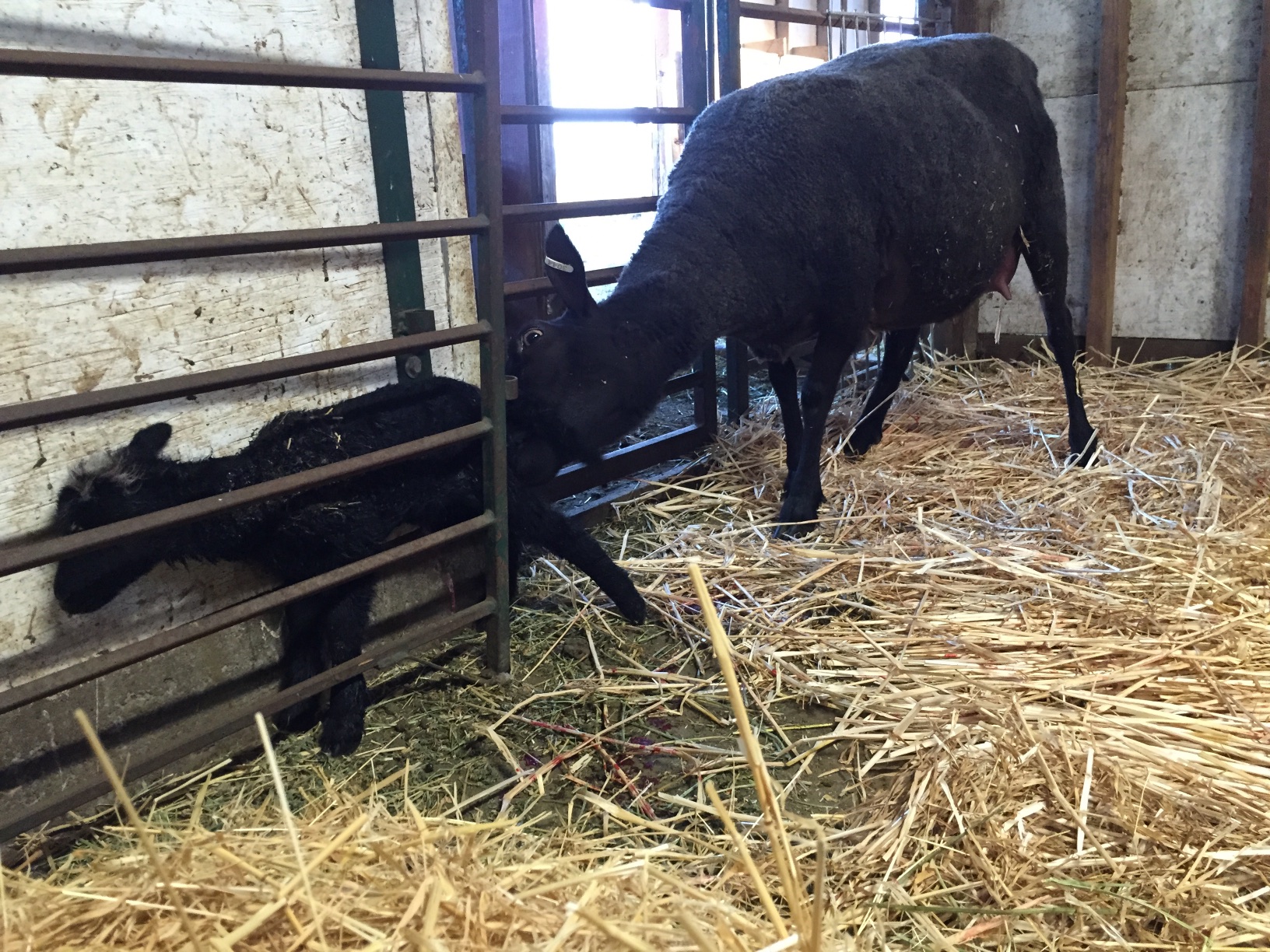 ...I knew that, however unlikely, a lamb could get stuck between it and the wall.
...I knew that, however unlikely, a lamb could get stuck between it and the wall.  Sure enough, that happened while I was still sitting there.
Sure enough, that happened while I was still sitting there. How about this foal that was just 12 hours old?
How about this foal that was just 12 hours old?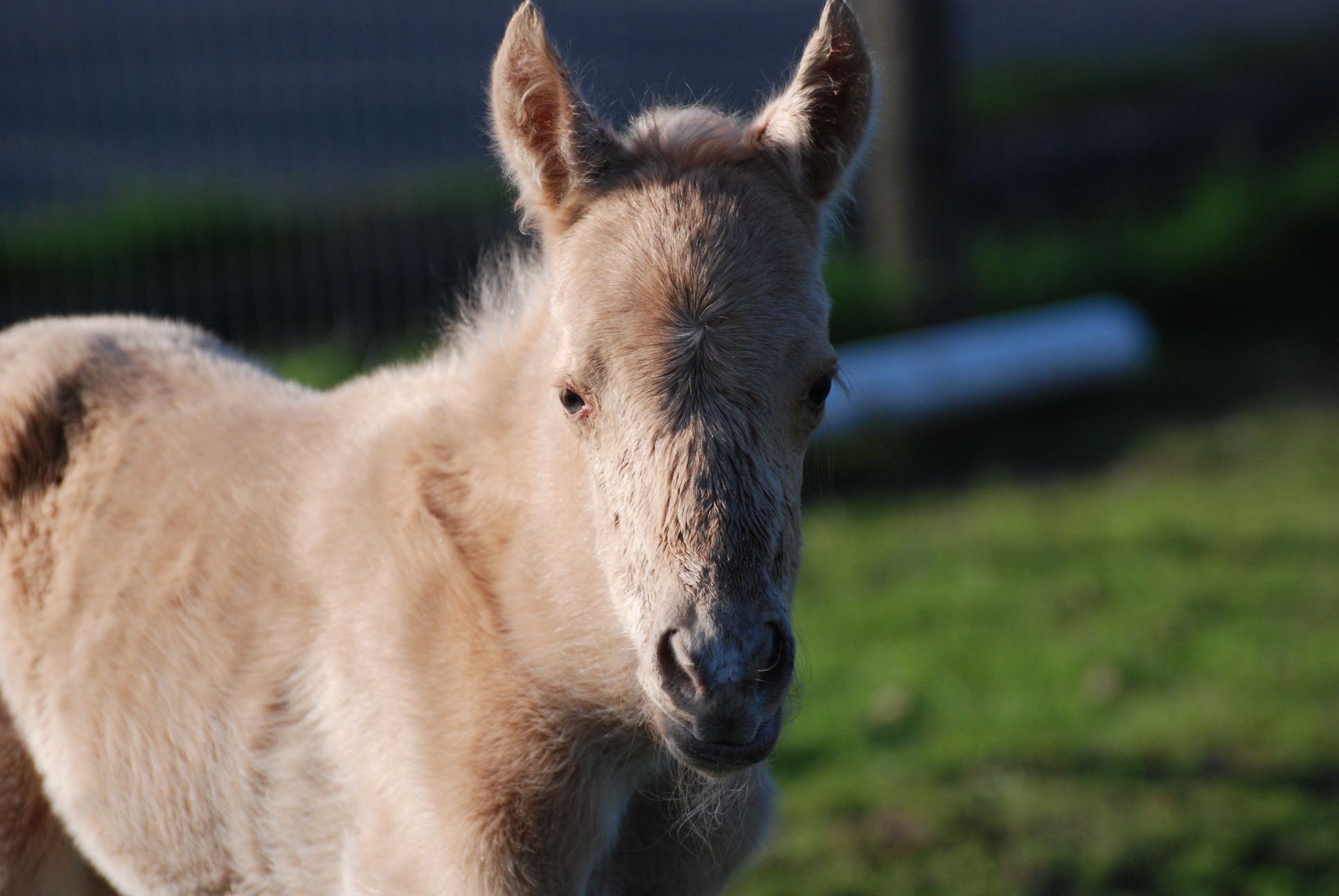 He was born down the road at my friend's house. We have to wait 5 months for lambs to be born. This foal was due on January 29 (11 months) and was just born today on February 22! That is almost a year of gestation for the mare.
He was born down the road at my friend's house. We have to wait 5 months for lambs to be born. This foal was due on January 29 (11 months) and was just born today on February 22! That is almost a year of gestation for the mare. Mae from the front.
Mae from the front.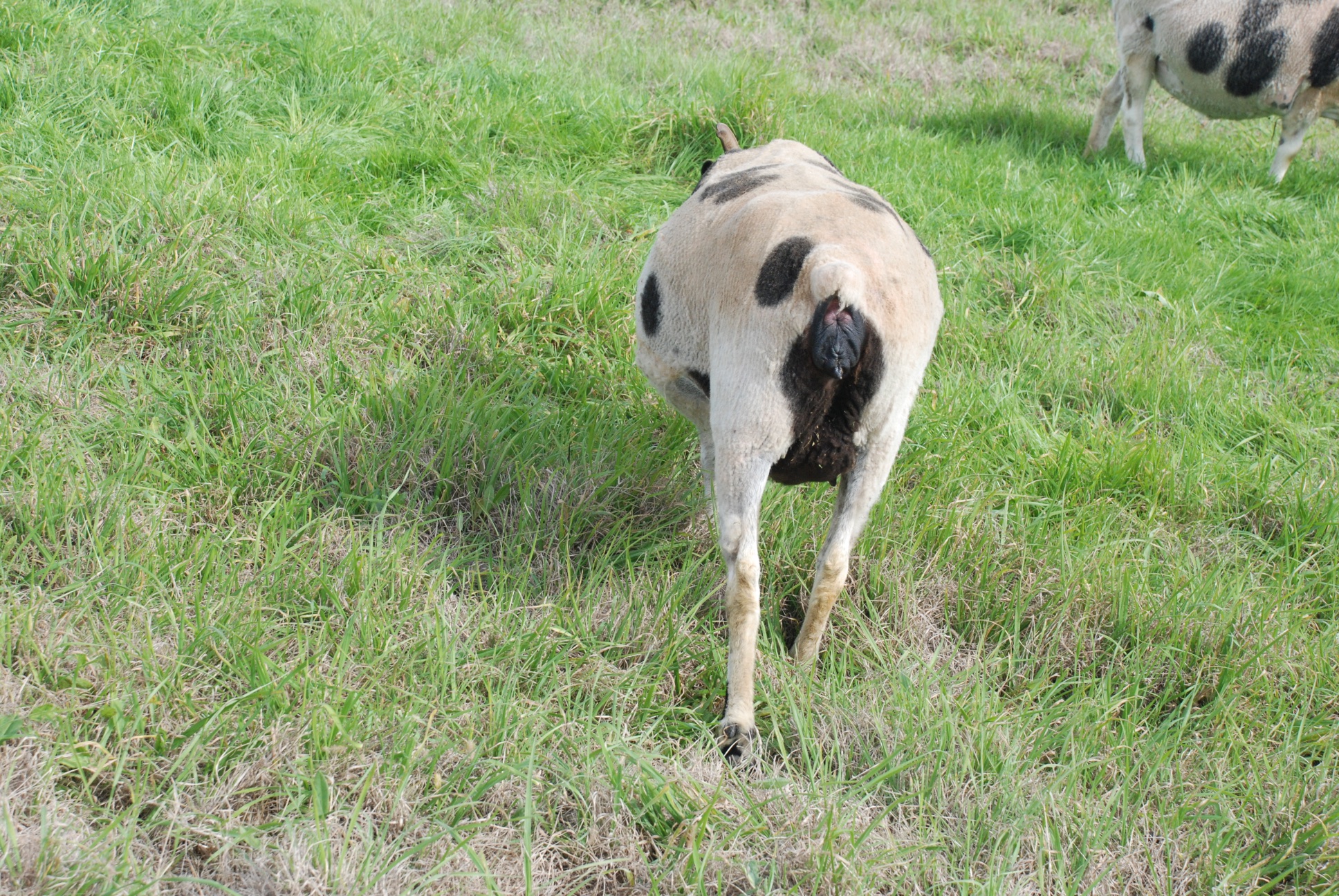 Mae from the rear.
Mae from the rear.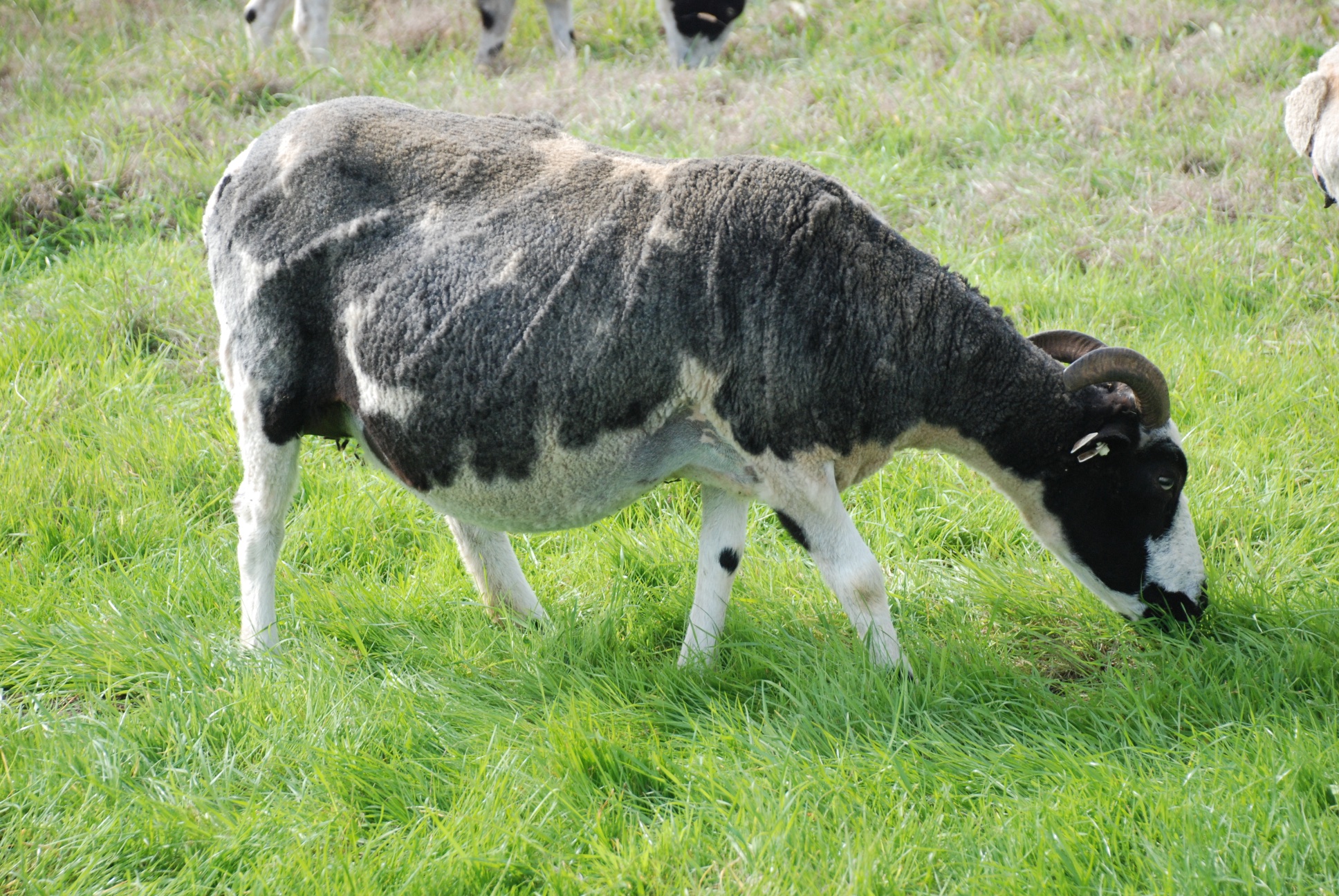 Shelby from the side.
Shelby from the side.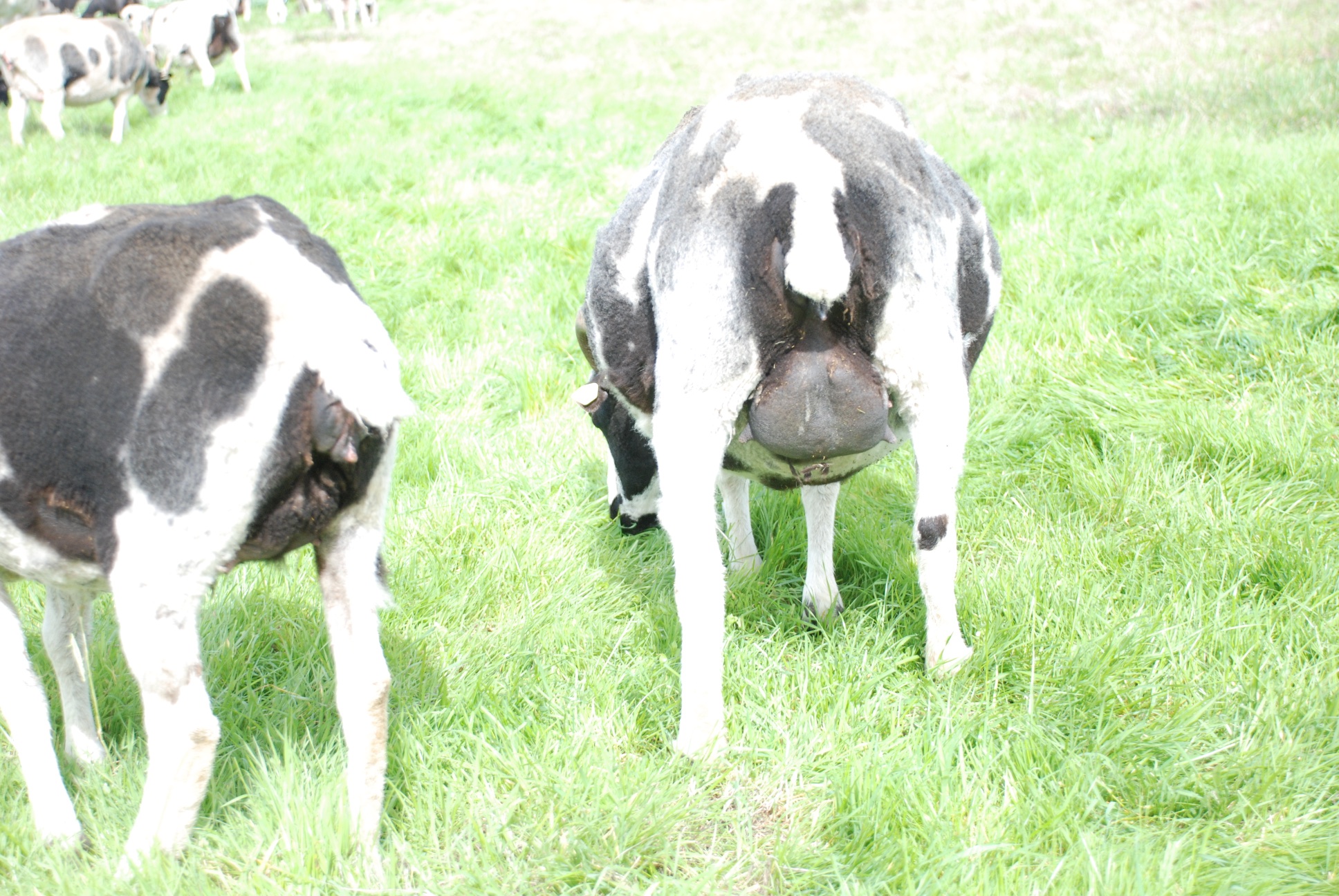 Shelby from the rear.
Shelby from the rear.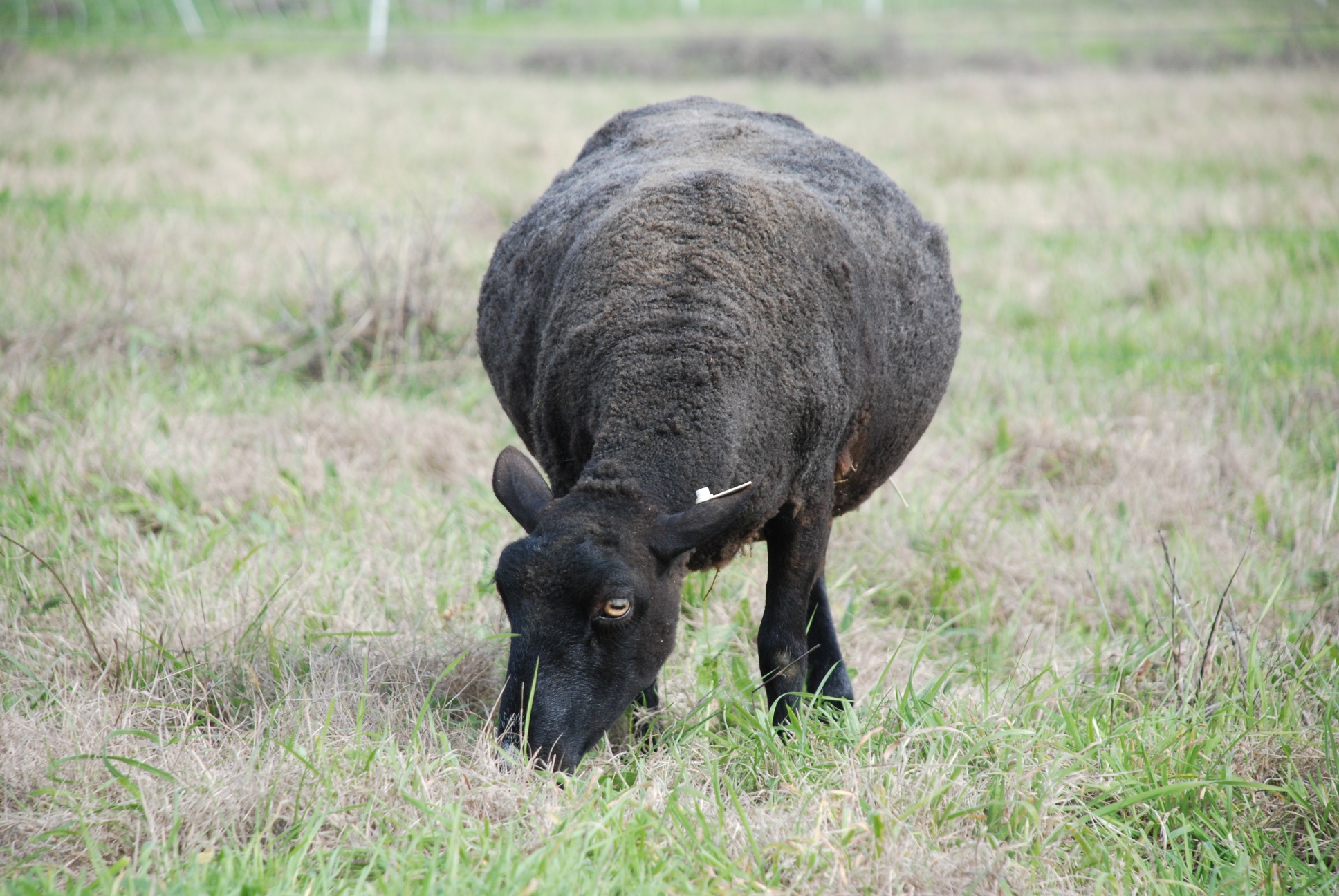 Esmerelda, front.
Esmerelda, front.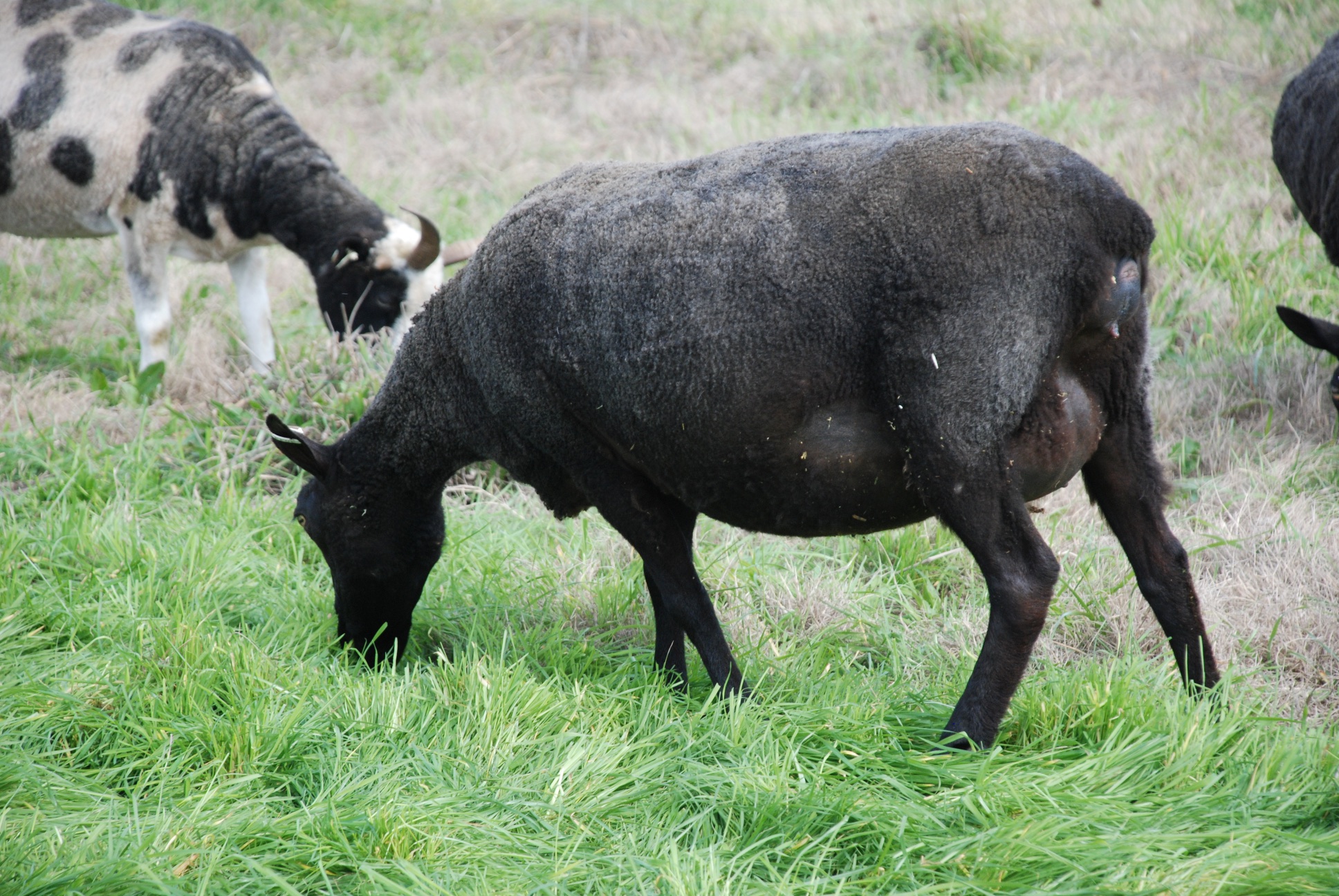 Esmerelda, rear.
Esmerelda, rear. Athena from the front.
Athena from the front.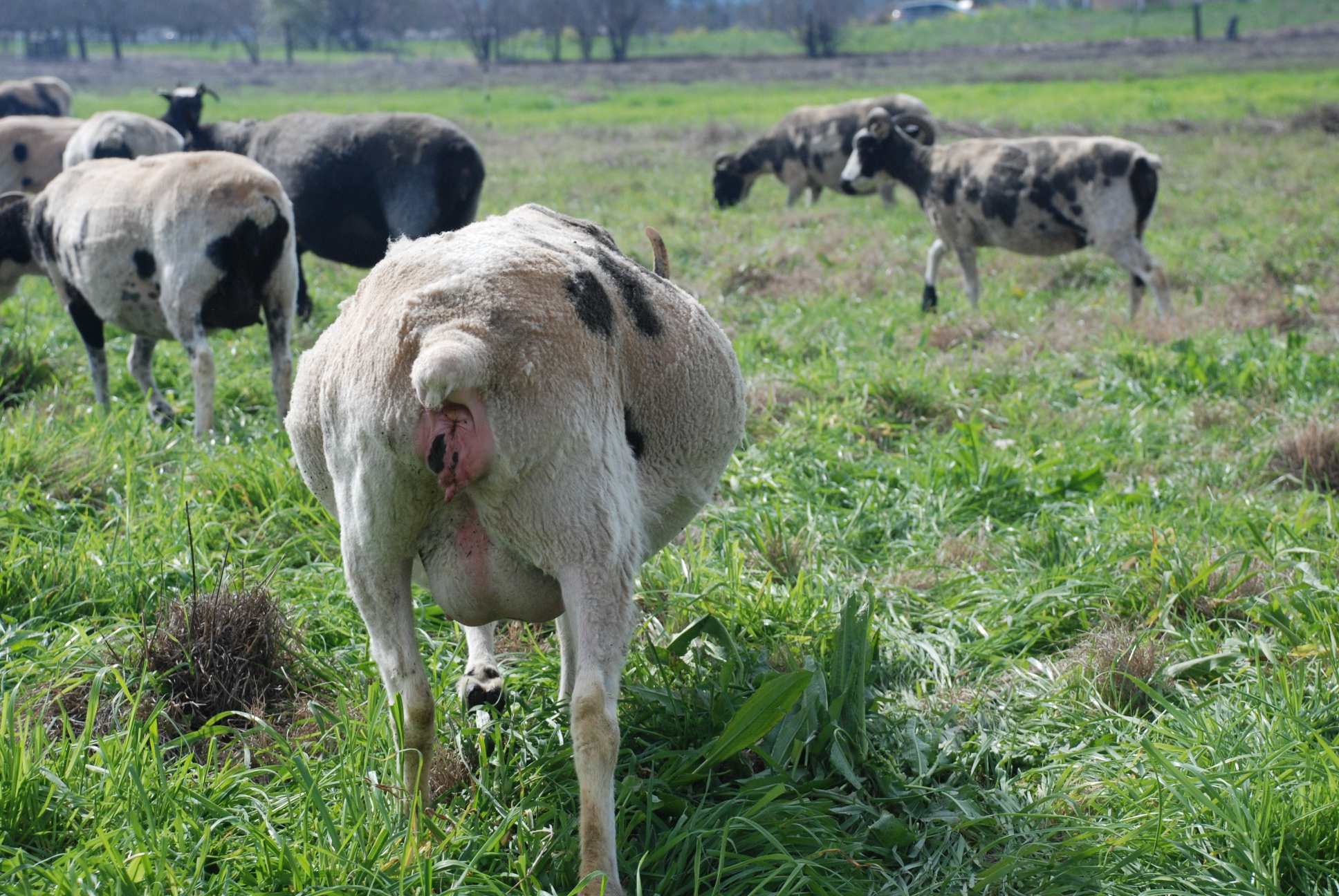 Athena from the rear.
Athena from the rear.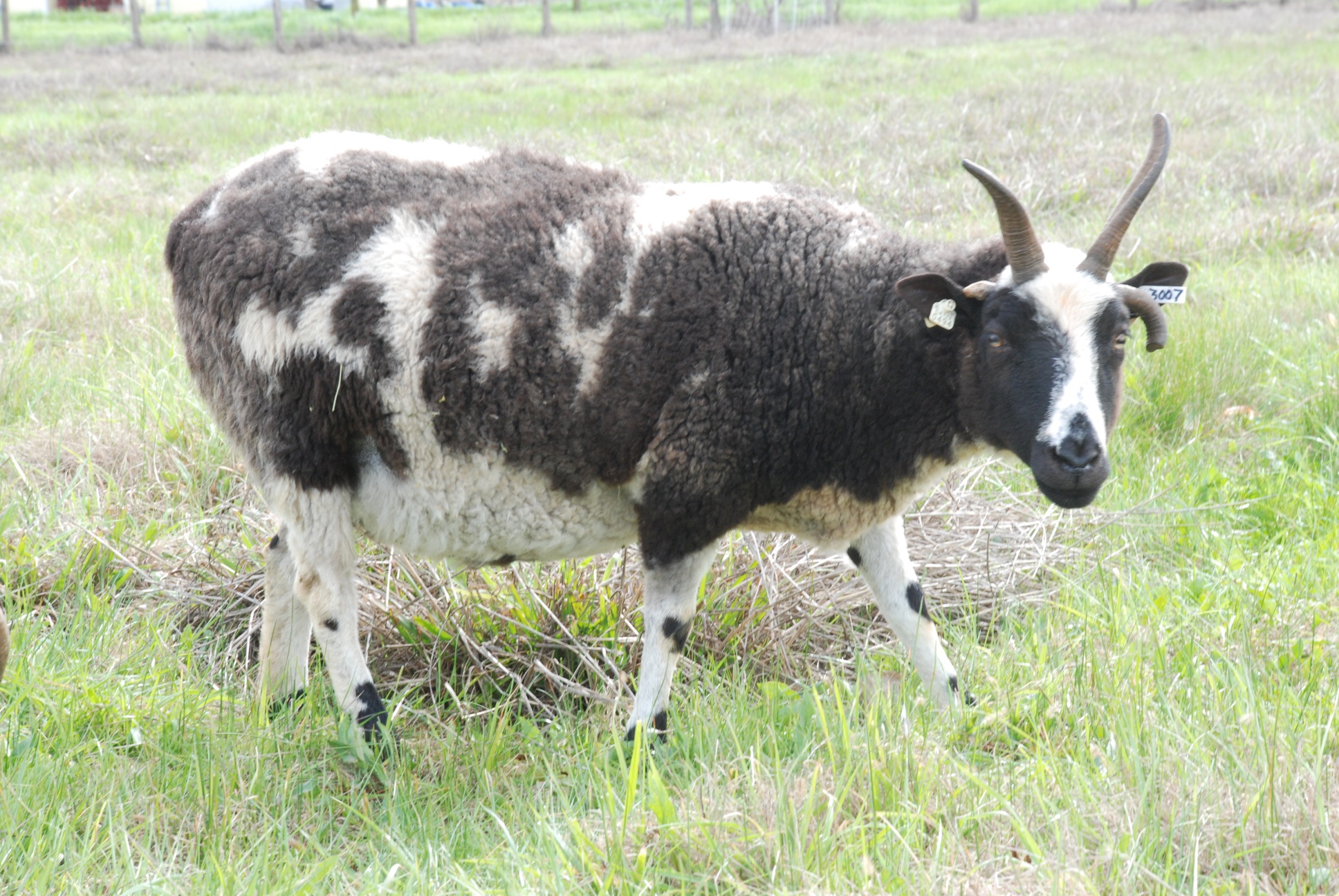 Marilyn is due 2/26.
Marilyn is due 2/26. 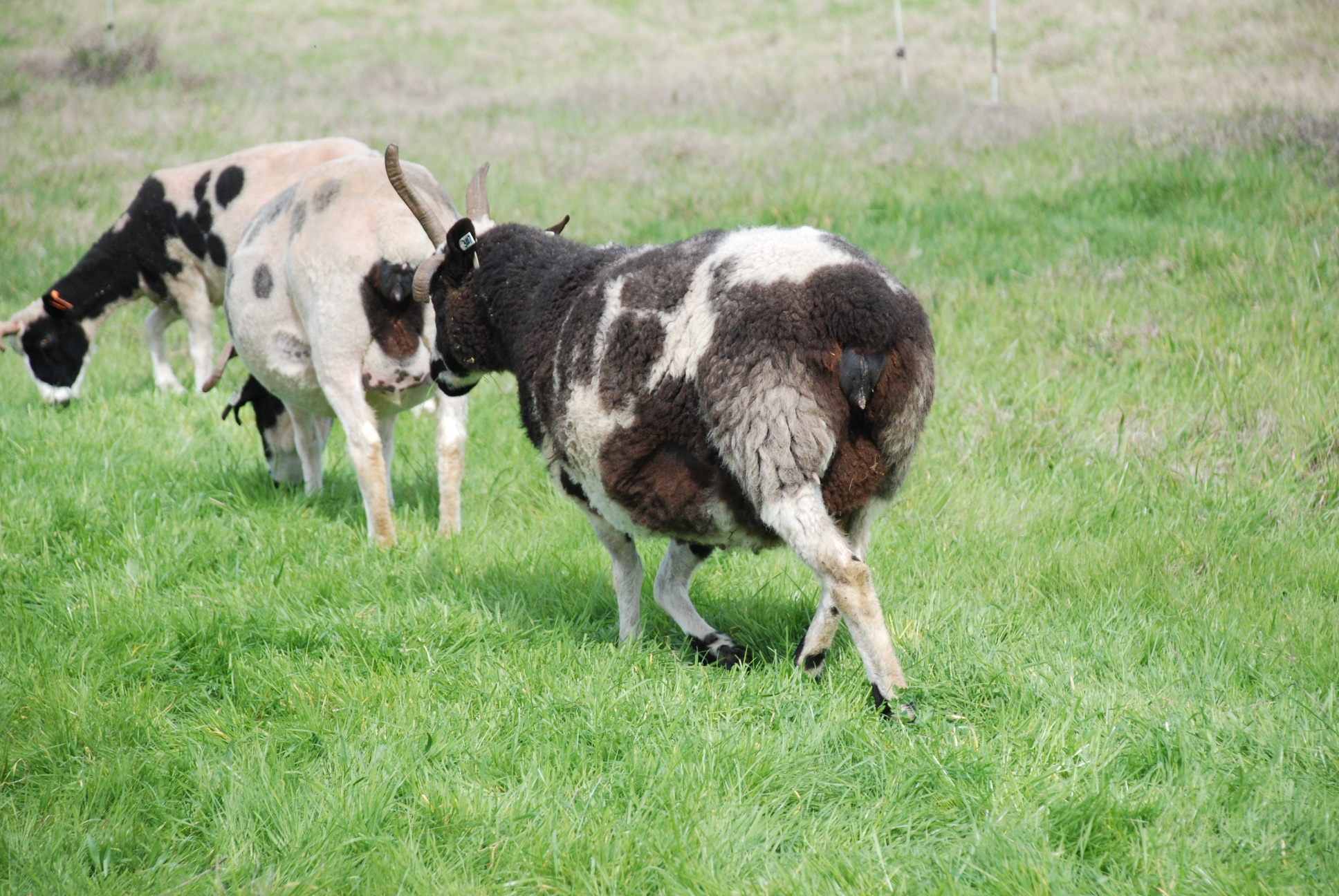 Here she is from the rear. She was shorn in November. I sure like the recently shorn views better for this.
Here she is from the rear. She was shorn in November. I sure like the recently shorn views better for this.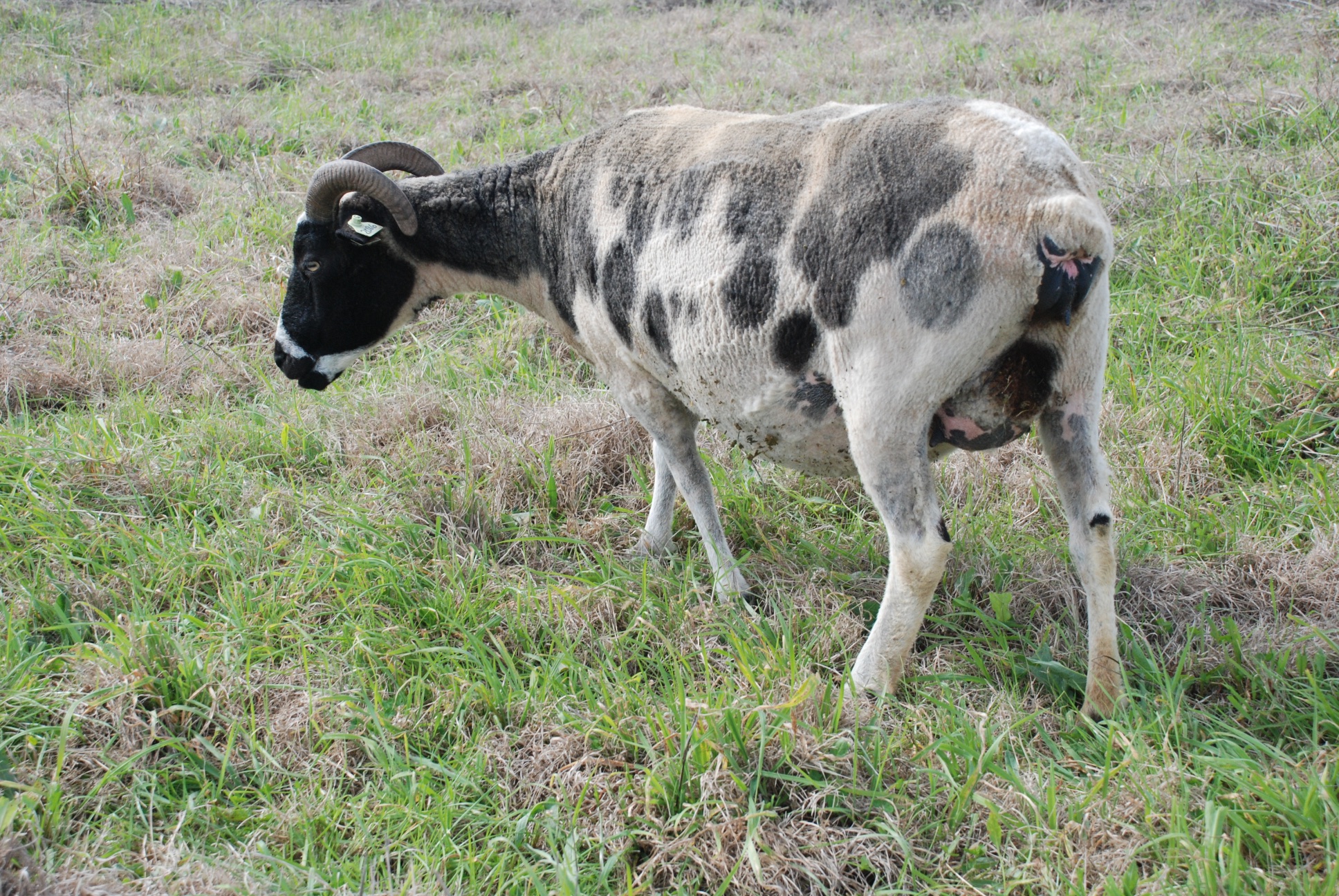 Noel is due 2/27.
Noel is due 2/27.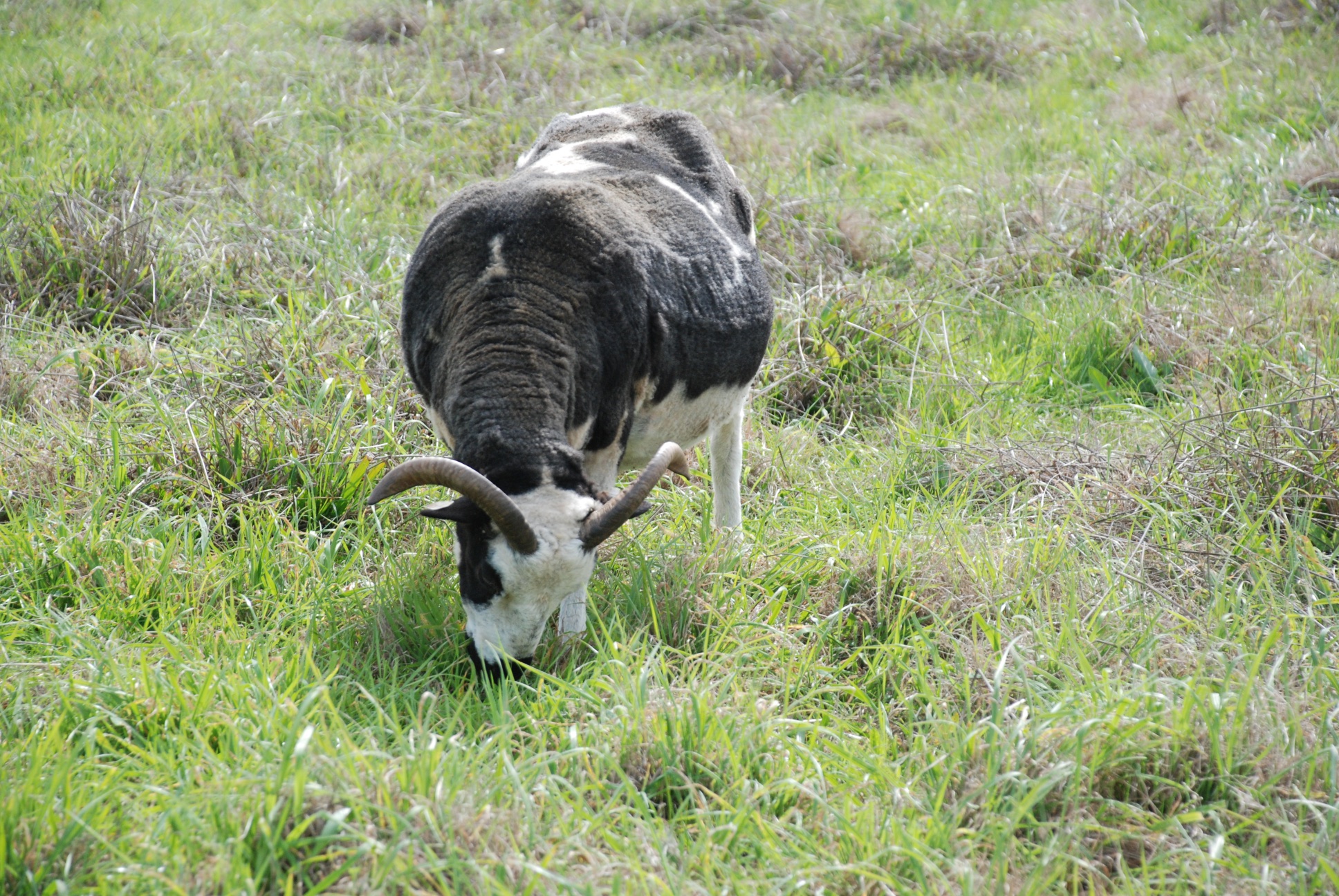 Fran is due 2/28.
Fran is due 2/28. Fran from the rear.
Fran from the rear.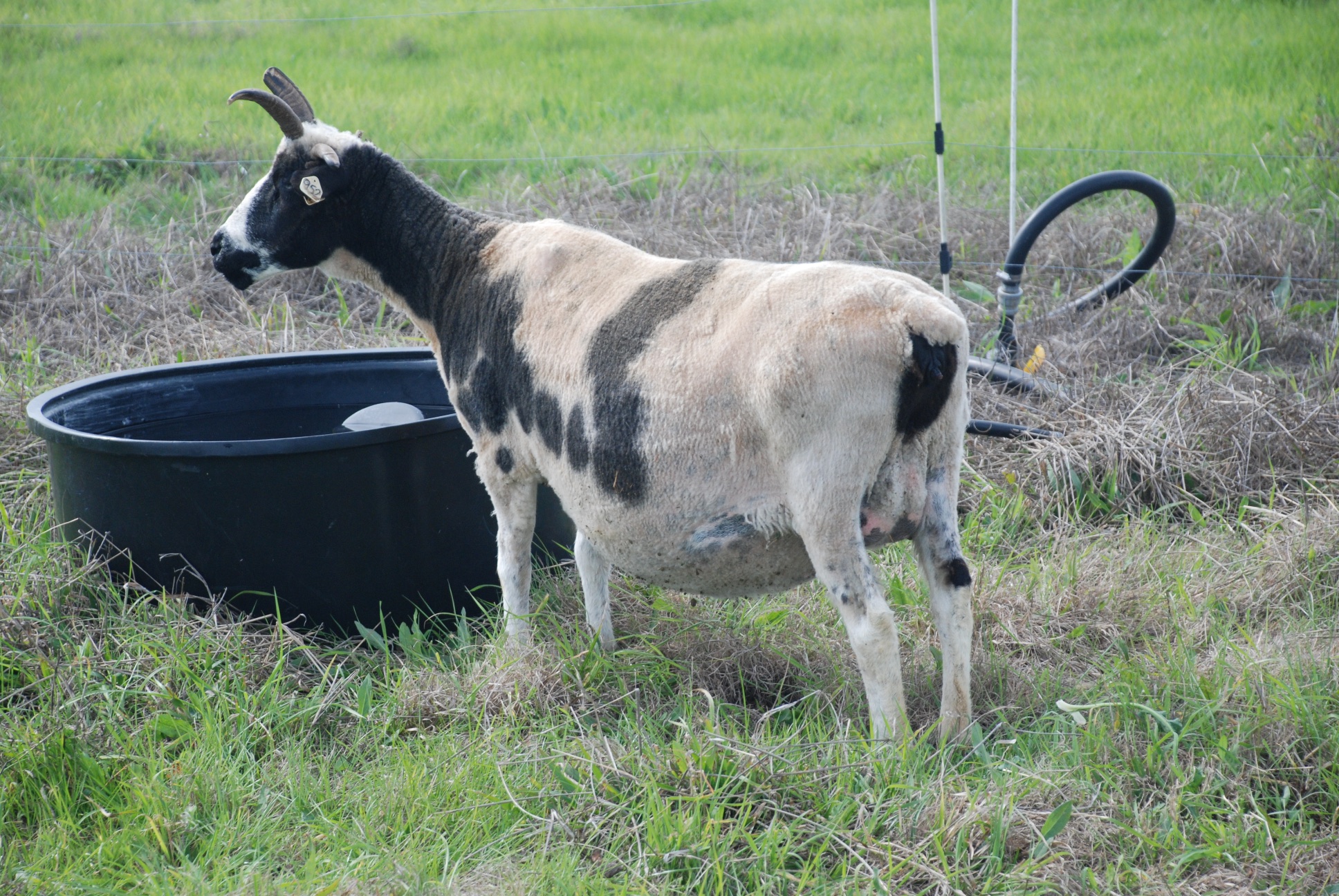 Spring isn't due until March 5 but she always looks so big I thought I'd just give you a view.
Spring isn't due until March 5 but she always looks so big I thought I'd just give you a view. Who is this? Trick question. That is Delight who is nursing twins.
Who is this? Trick question. That is Delight who is nursing twins.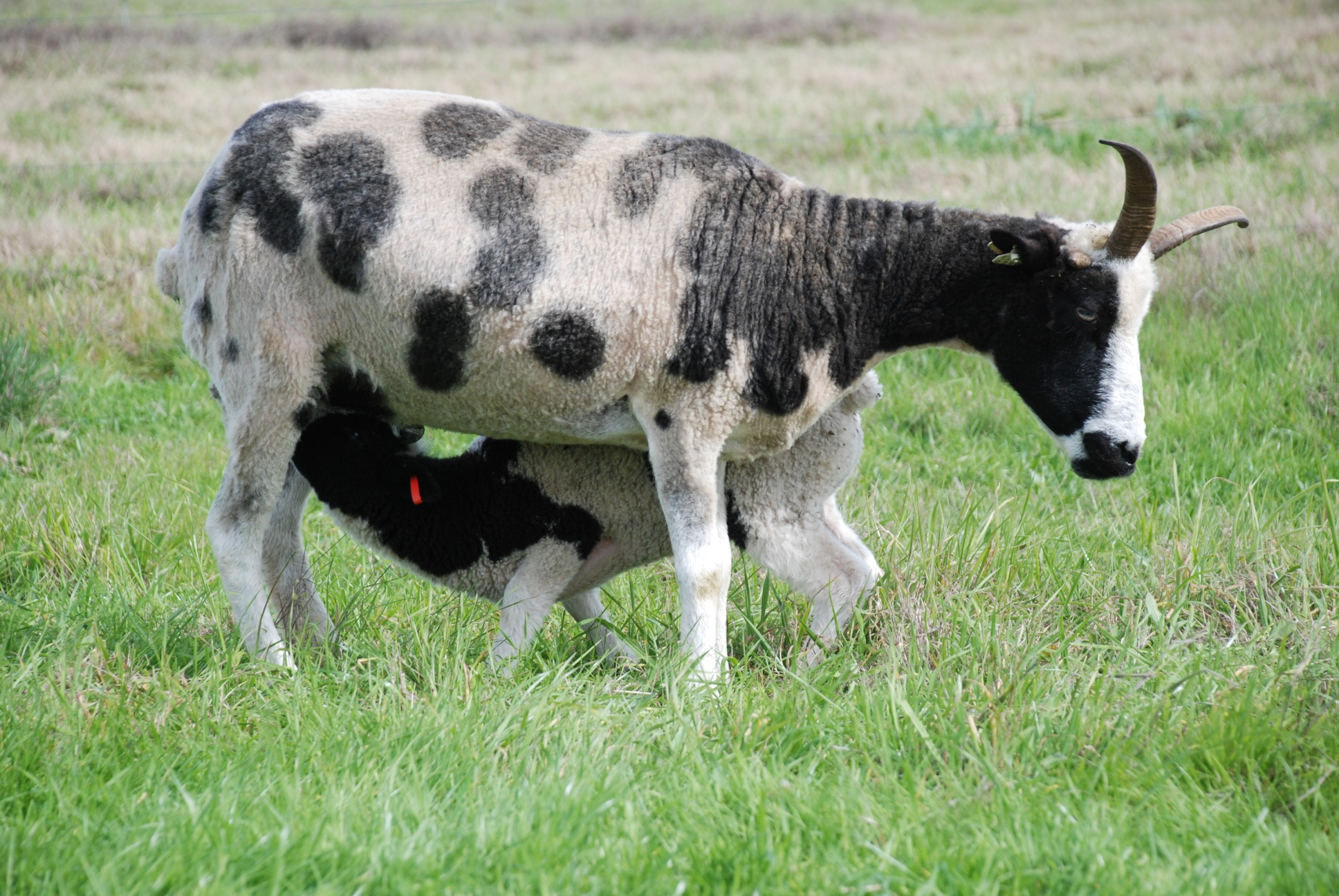 And here is Dazzle with her single. You can sure see the difference in body condition of ewes that are nursing month old lambs.
And here is Dazzle with her single. You can sure see the difference in body condition of ewes that are nursing month old lambs.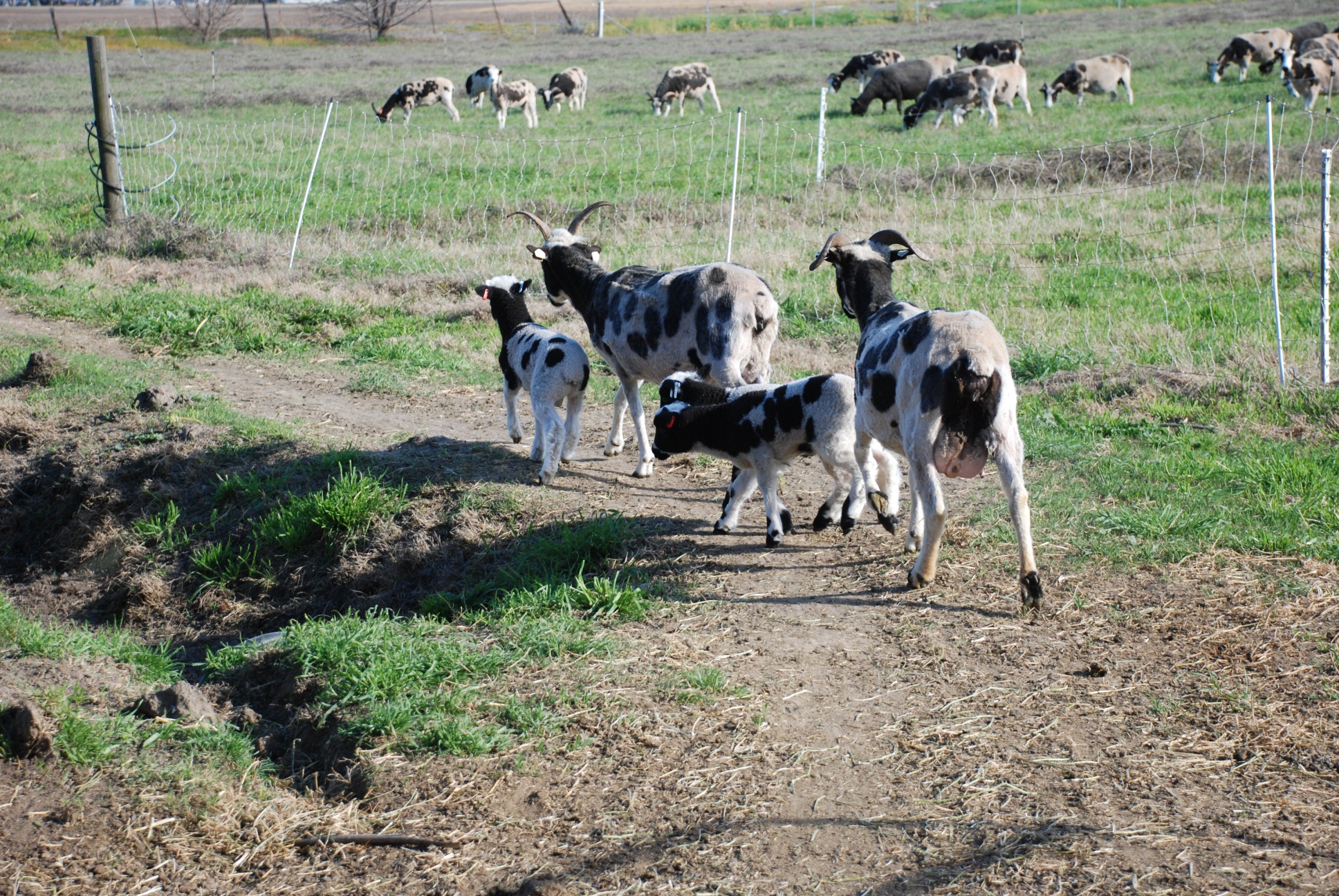 Last week as it was drying out I put the flock on the pasture and then turned the new lambs out with them.
Last week as it was drying out I put the flock on the pasture and then turned the new lambs out with them. One thing I watch for when putting lambs in the pasture for the first time is that they don't get tangled up in the electric fence.
One thing I watch for when putting lambs in the pasture for the first time is that they don't get tangled up in the electric fence.  I'm glad to see when they touch the fence because I know that they will have learned to avoid it.
I'm glad to see when they touch the fence because I know that they will have learned to avoid it. This looks worse than it was. The whole incident was very brief and then...
This looks worse than it was. The whole incident was very brief and then...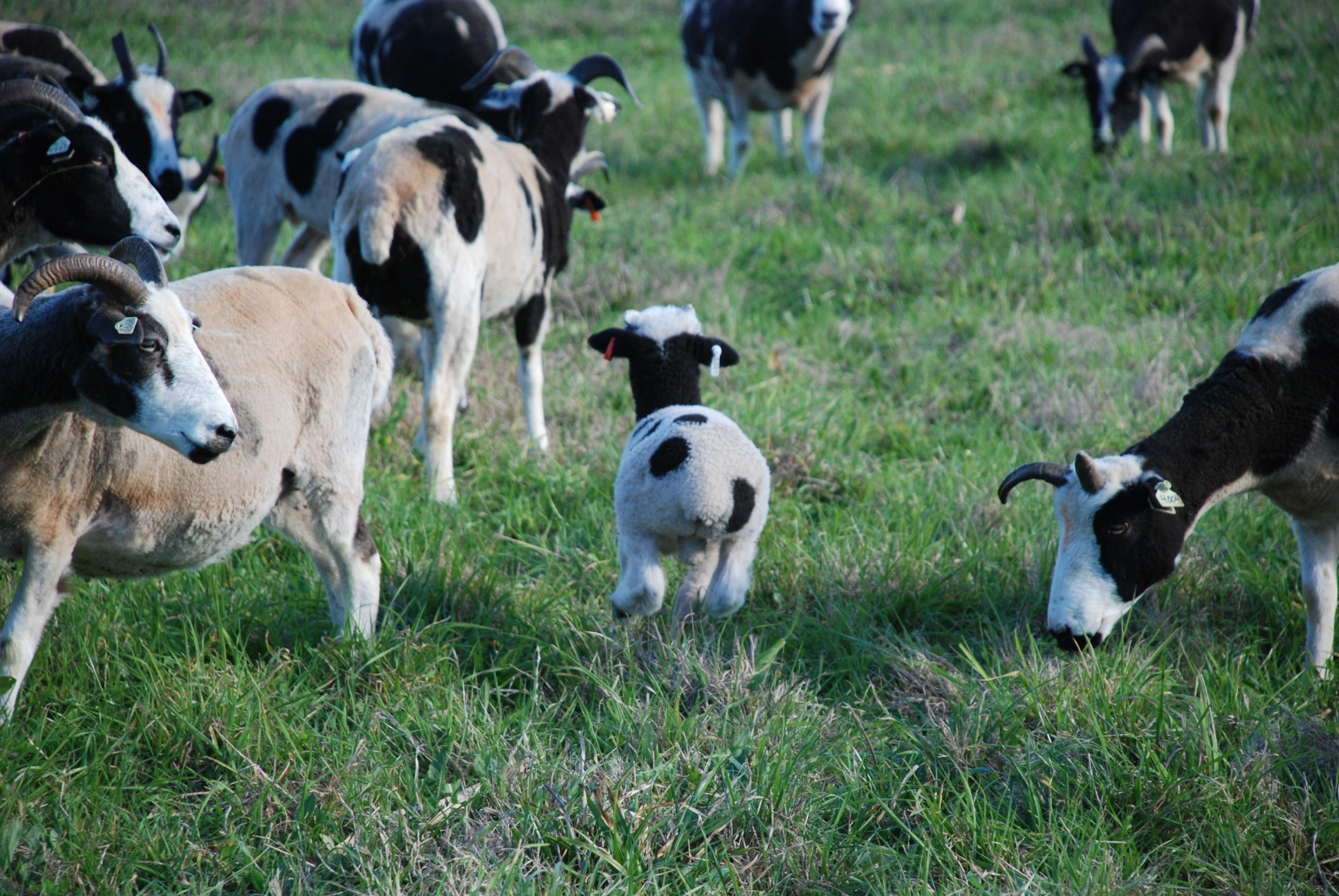 ...the nearby lamb was off and running.
...the nearby lamb was off and running.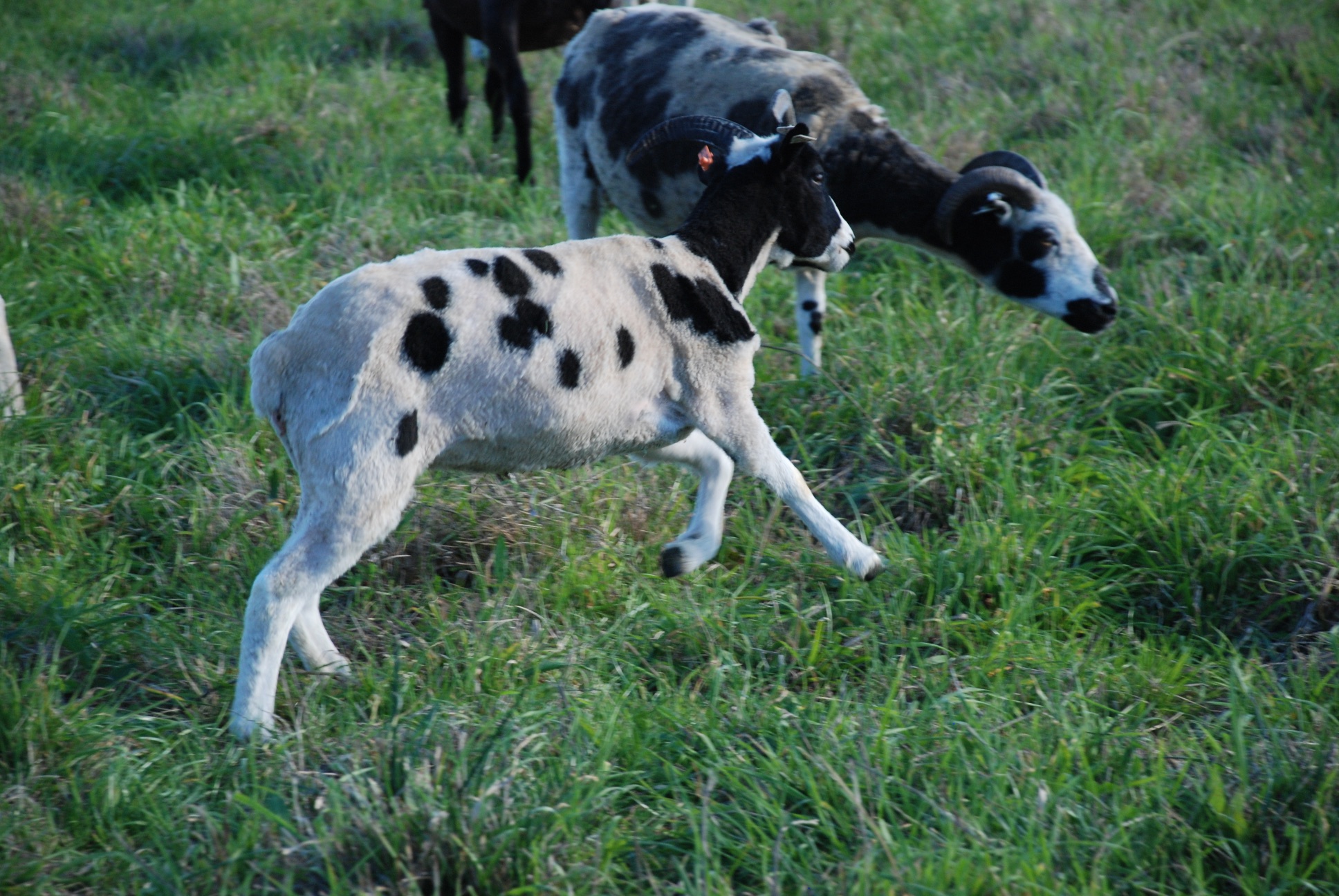 Bertha, one of the yearlings thought this looked like a good game...
Bertha, one of the yearlings thought this looked like a good game...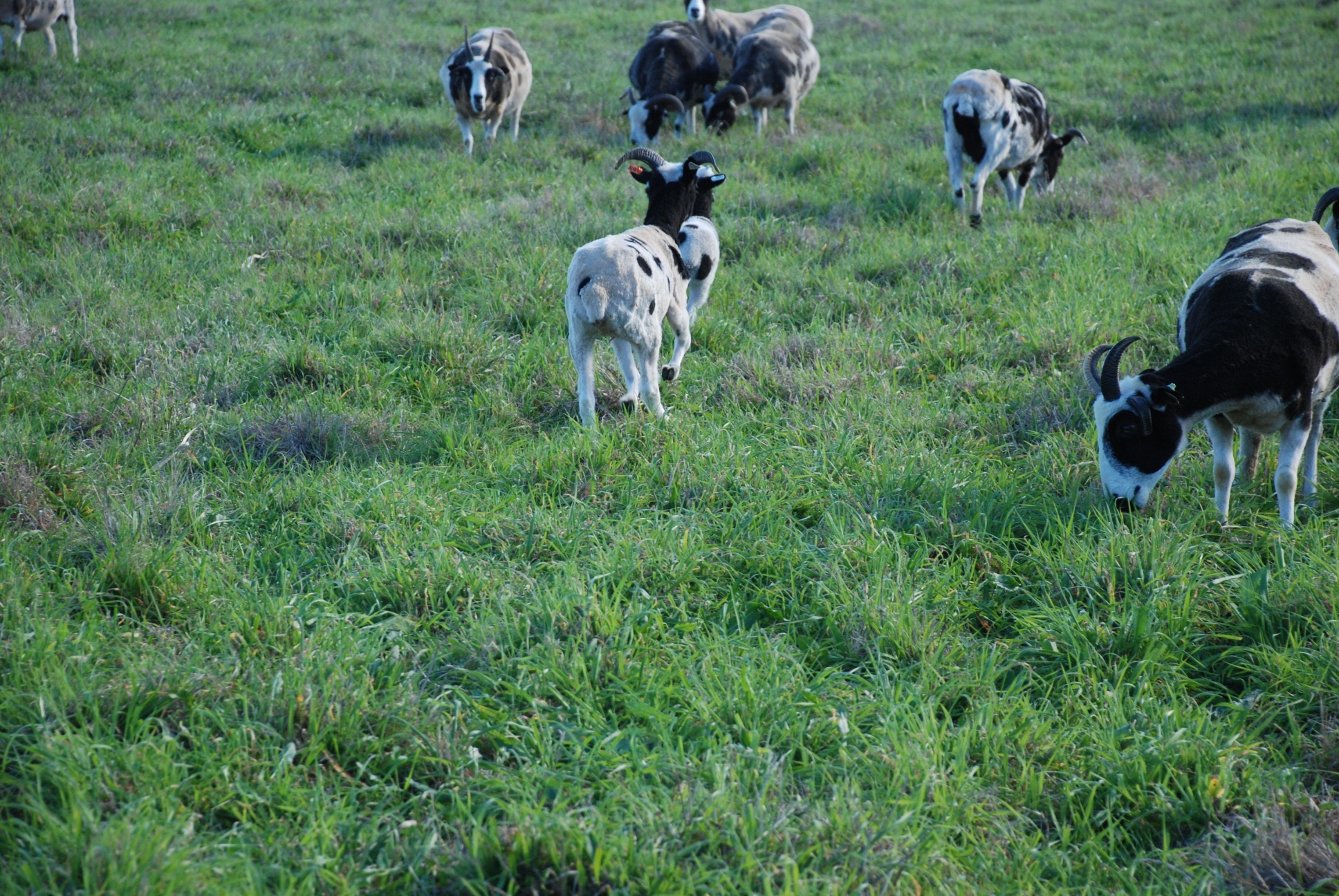 ...so she kept up the chase.
...so she kept up the chase.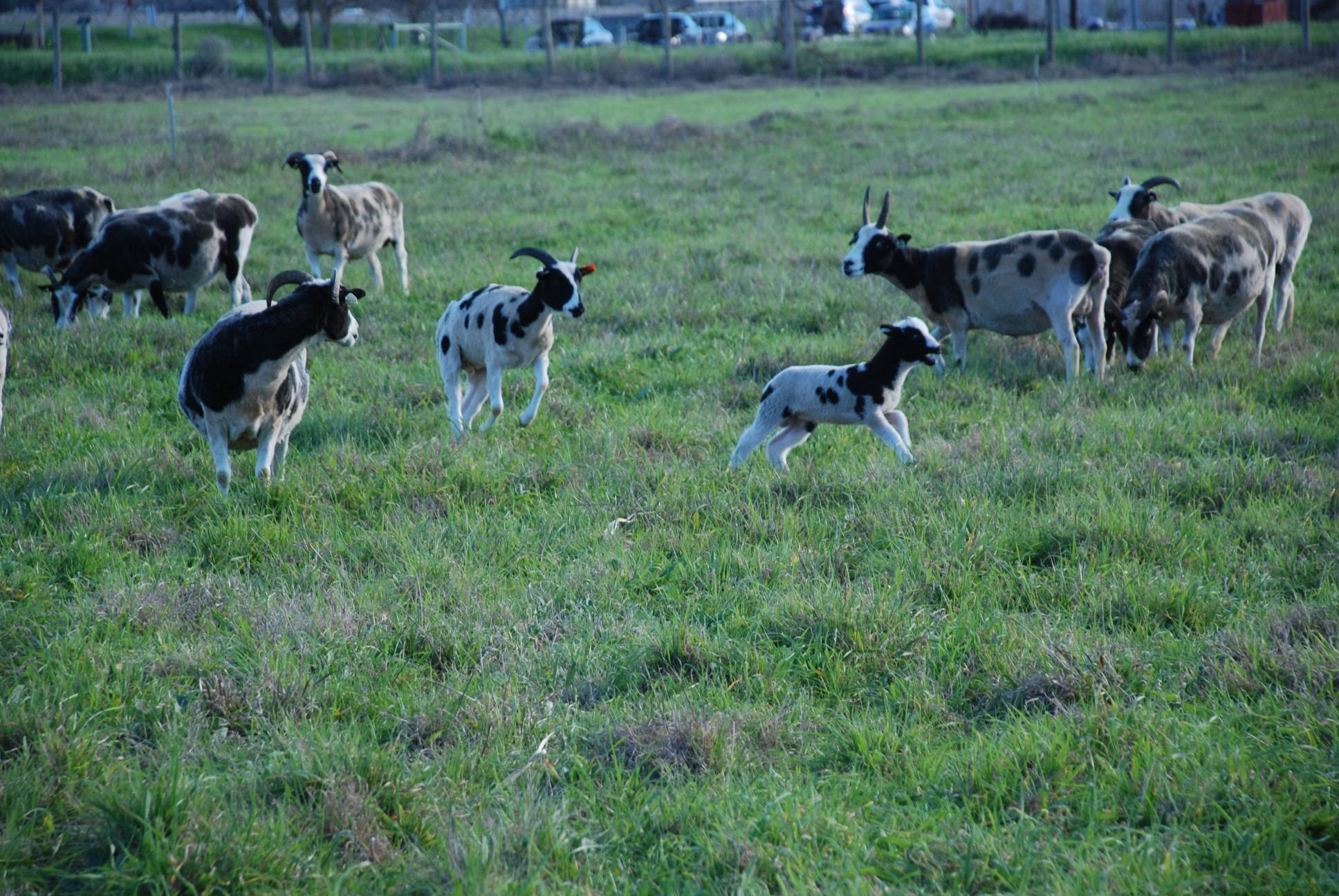

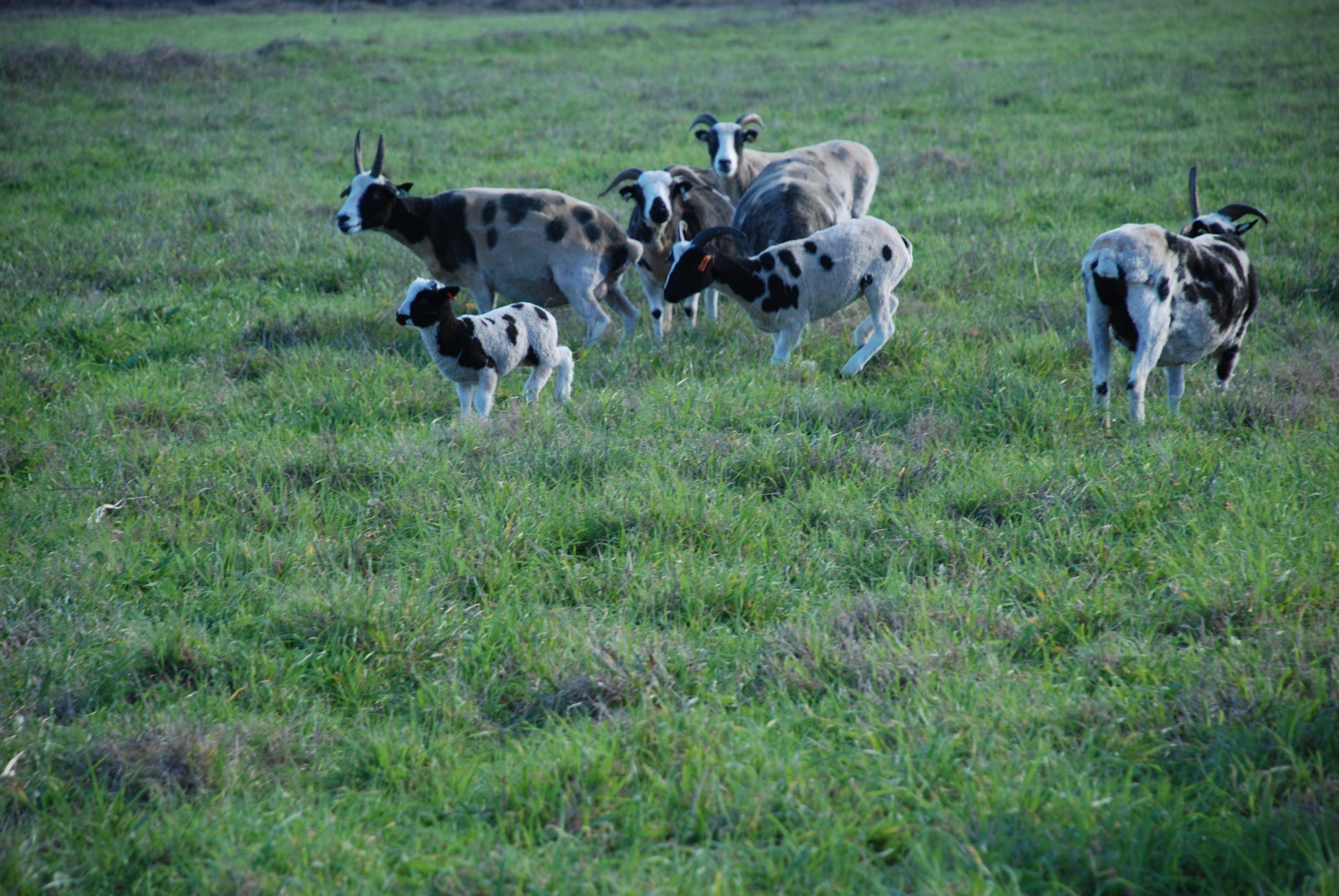
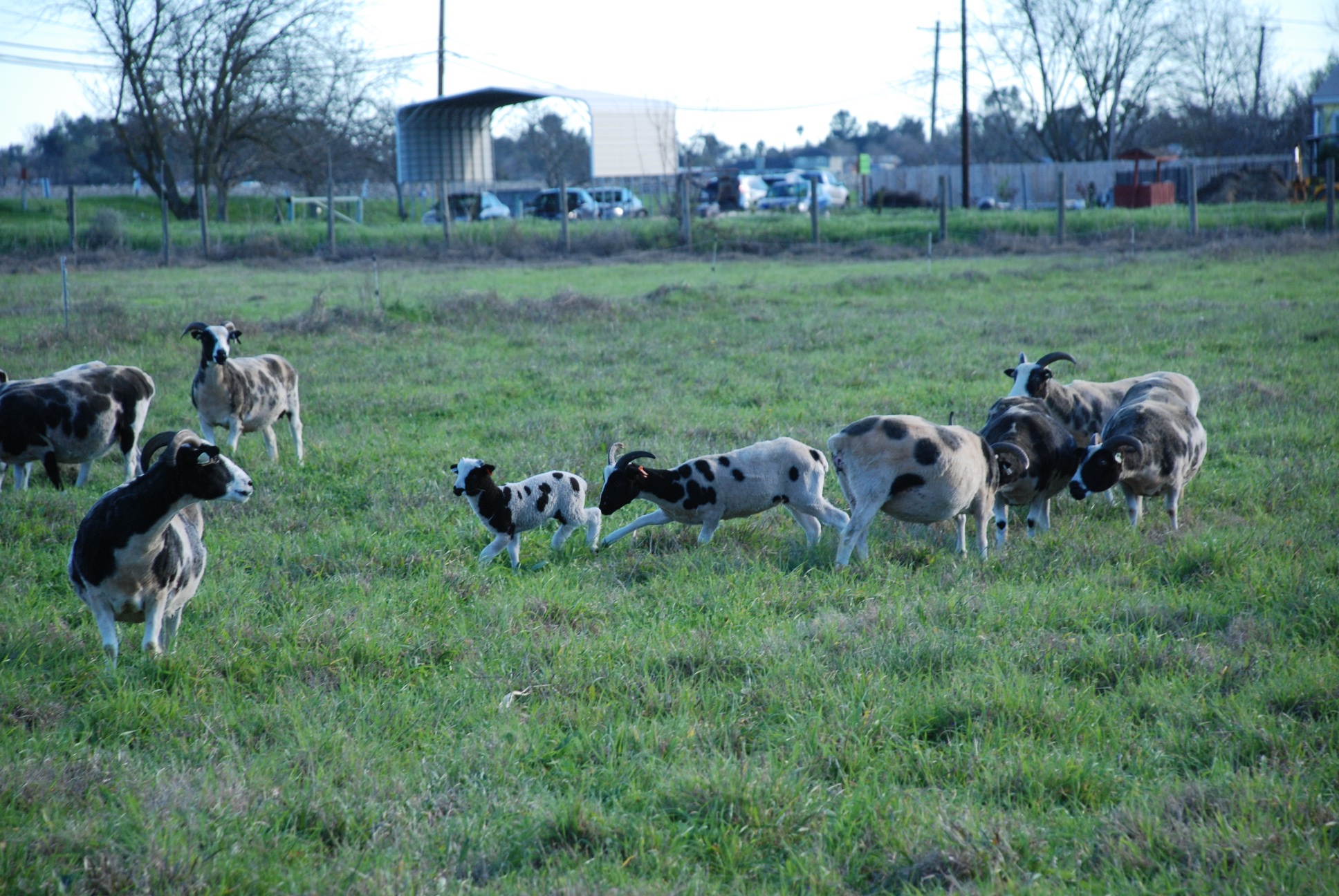

 Eventually this lamb found his mom who hadn't been particularly concerned about him.
Eventually this lamb found his mom who hadn't been particularly concerned about him.
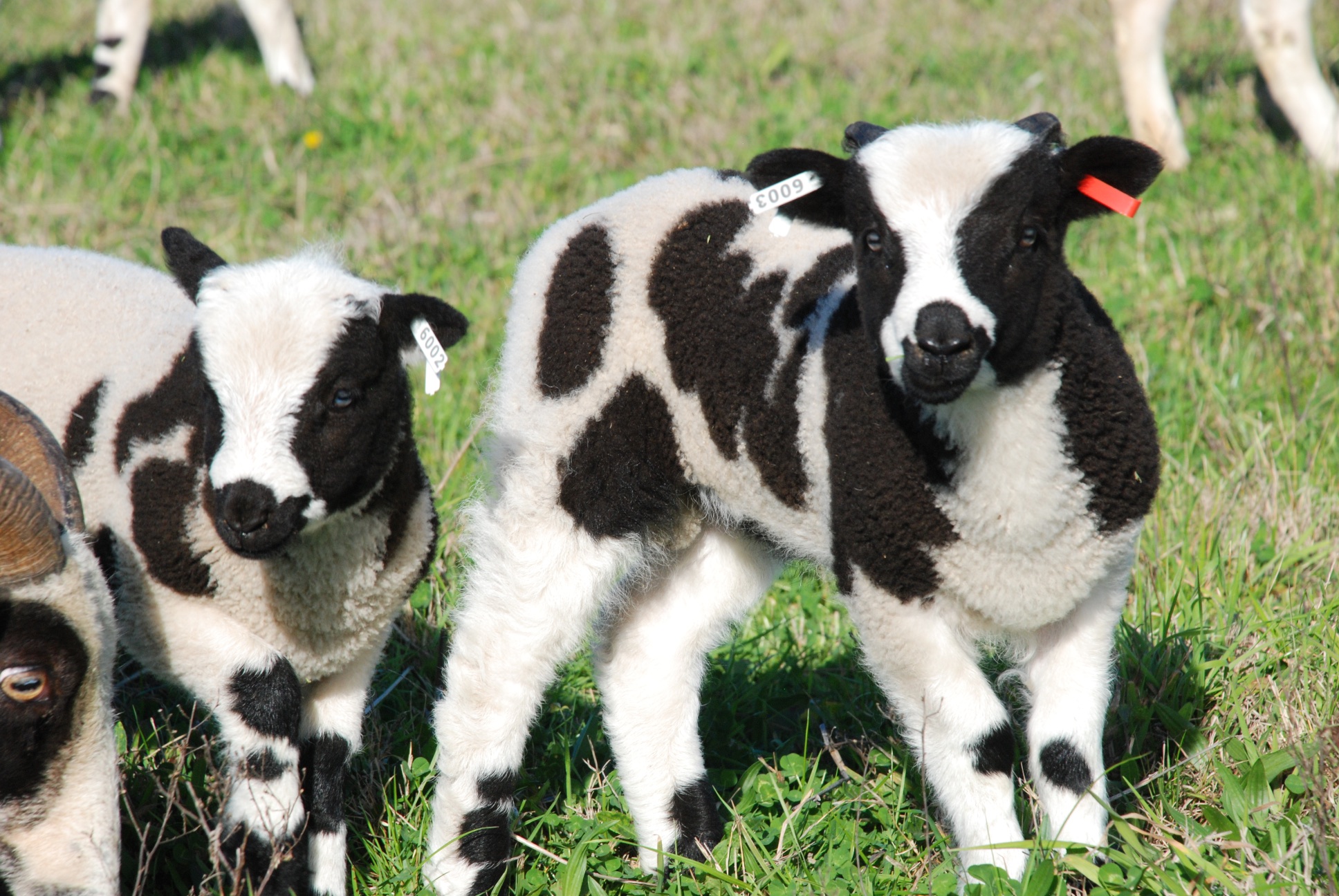 In the meantime the other two lambs stuck near their mom. I'm going to use colored tags again this year to give me more information about the lambs at a glance, mostly about sires. However, these first three have an unknown sire and the ram lambs (gorgeous as they are) have been banded. That's what the red tags mean--wether.
In the meantime the other two lambs stuck near their mom. I'm going to use colored tags again this year to give me more information about the lambs at a glance, mostly about sires. However, these first three have an unknown sire and the ram lambs (gorgeous as they are) have been banded. That's what the red tags mean--wether. When I asked how many alpacas there are, Mary said between 150 and 200. They roam the hills on the ranch, accompanied by guardian dogs.
When I asked how many alpacas there are, Mary said between 150 and 200. They roam the hills on the ranch, accompanied by guardian dogs. This is one of the many ranch dogs that include guardian and herding dogs. We were told that this one is only 8 months old.
This is one of the many ranch dogs that include guardian and herding dogs. We were told that this one is only 8 months old. Our meeting was in the greenhouse located near the field where the bucks live.
Our meeting was in the greenhouse located near the field where the bucks live. This guy seemed pretty friendly.
This guy seemed pretty friendly. Before we started the meeting we admired each others fiber products. This is one of the Twirl yarns produced by Mary.
Before we started the meeting we admired each others fiber products. This is one of the Twirl yarns produced by Mary. This is what I brought to share--sheepskins, buttons, yarn, and shawls from my Jacob sheep. The new
This is what I brought to share--sheepskins, buttons, yarn, and shawls from my Jacob sheep. The new  This is a felted hat made by
This is a felted hat made by  Here is
Here is  ...and this is a piece she felted from the wool of Vicki, one of my Jacob sheep.
...and this is a piece she felted from the wool of Vicki, one of my Jacob sheep. We were able to see the recently produced Wool and Fine Fiber Book. Each producer has a spread in which samples of their fiber is attached. These books will be circulated to designers and manufacturers who want to find out what kinds of fiber are available locally, how to contact the producers, and to learn how these fibers might be used in end products. This was an amazing undertaking by Fibershed.
Speaking of amazing things, we learned about the "projects" that Fibershed founder, Rebecca Burgess, has underway. I say "projects" in quotation marks because really these are major undertakings and far beyond the scope of anything that I ever attempt. Rebecca is not only writing another book, but is working with the
We were able to see the recently produced Wool and Fine Fiber Book. Each producer has a spread in which samples of their fiber is attached. These books will be circulated to designers and manufacturers who want to find out what kinds of fiber are available locally, how to contact the producers, and to learn how these fibers might be used in end products. This was an amazing undertaking by Fibershed.
Speaking of amazing things, we learned about the "projects" that Fibershed founder, Rebecca Burgess, has underway. I say "projects" in quotation marks because really these are major undertakings and far beyond the scope of anything that I ever attempt. Rebecca is not only writing another book, but is working with the  While hearing about all this we were also doing what Fibershed producers do best, eating and baby animal snuggling. This is a two-day old kid who needs some TLC.
While hearing about all this we were also doing what Fibershed producers do best, eating and baby animal snuggling. This is a two-day old kid who needs some TLC. One of the dogs was feeling left out.
One of the dogs was feeling left out. Even Rebecca found some goat snuggling time.
Even Rebecca found some goat snuggling time. I hadn't had a chance to do anything with it until recently. The first step was to gather some information.
I hadn't had a chance to do anything with it until recently. The first step was to gather some information. The McMorran yarn balance is one tool to do that. You trim the ends off a strand of yarn until the arm balances.
The McMorran yarn balance is one tool to do that. You trim the ends off a strand of yarn until the arm balances. Then you measure that length of yarn and multiply by 100 to get ypp (yards/pound). I repeated that a few times to get an average--1500 ypp.
Then you measure that length of yarn and multiply by 100 to get ypp (yards/pound). I repeated that a few times to get an average--1500 ypp. Another measurement is wpi (wraps/inch). This yarn measure 15 wpi. However, from past experience I know that this isn't quite accurate. Most yarn is scoured (washed) and skeined before it is sold in yarn stores. That can have a dramatic effect on the yarn. The yarn that I got from the mill on cones has not been scoured yet, so it is not really "finished".
Another measurement is wpi (wraps/inch). This yarn measure 15 wpi. However, from past experience I know that this isn't quite accurate. Most yarn is scoured (washed) and skeined before it is sold in yarn stores. That can have a dramatic effect on the yarn. The yarn that I got from the mill on cones has not been scoured yet, so it is not really "finished". Look at the difference a soak in warm water makes. Now this yarn measure 1200 ypp (which is what the specs from the mill were)...
Look at the difference a soak in warm water makes. Now this yarn measure 1200 ypp (which is what the specs from the mill were)... and it is 10 wpi. Based on those measurements I wove some samples.
and it is 10 wpi. Based on those measurements I wove some samples. These samples look pretty open on the loom...
These samples look pretty open on the loom... ...and I had to be careful to not beat the weft yarn down too much.
...and I had to be careful to not beat the weft yarn down too much. This is how the samples look off the loom. The 8 epi samples are in the top row.
This is how the samples look off the loom. The 8 epi samples are in the top row. And here is how they look after a quick wash. Dramatic difference from the loom to the finished fabric.
And here is how they look after a quick wash. Dramatic difference from the loom to the finished fabric. Here is how I had them displayed in the shop at the recent Shearing Day. The skein on the left has been washed. But these yarns aren't just for weaving. My friend, Mary, bought some, washed it, and then used it for a Mystery Knit Along. Here is the shawl she knit.
Here is how I had them displayed in the shop at the recent Shearing Day. The skein on the left has been washed. But these yarns aren't just for weaving. My friend, Mary, bought some, washed it, and then used it for a Mystery Knit Along. Here is the shawl she knit. This was knit over a few weeks with a new direction given out each week.
This was knit over a few weeks with a new direction given out each week. It is gorgeous in person and has a wonderful hand. I can't wait to get some of this yarn on the loom and get to work with it.
It is gorgeous in person and has a wonderful hand. I can't wait to get some of this yarn on the loom and get to work with it.